
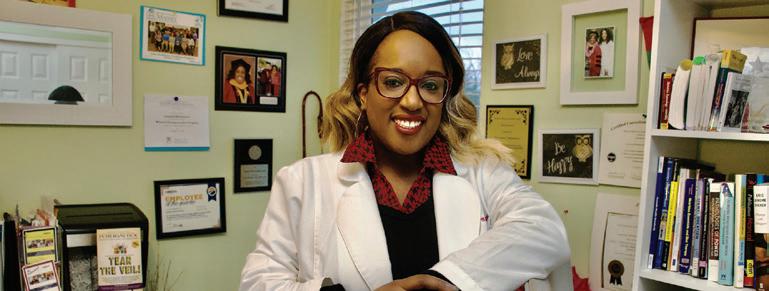
Black Nurses Association continues mission of pioneer Mary Eliza Mahoney • See page B1




Black Nurses Association continues mission of pioneer Mary Eliza Mahoney • See page B1

By Dana Rieck
Of The St. Louis American
With less than two weeks until the primary election in St. Louis, mayoral candidates’ political action committees (PACs) are raking in big money from influential donors. While the maximum donation allowed by an individual or committee to a mayoral candidate is limited to $2,600, as stipulated by a St. Louis Board of Alderman bill unanimously passed in June 2018, the same is not true for PACs.
These committees, which raise money for independent expenditures, may solicit and accept unlimited contributions from individuals and
other groups. The finances of PACs supporting St. Louis mayoral candidates are detailed in this report.
Aldermanic President Lewis Reed
Aldermanic President Lewis Reed’s PAC, One St. Louis, has raised over $200,000 with nine contributions since the beginning of 2020. More than half of that came from one funder — CHIPP (Carpenters Help in the Political Process) — which donated $100,000 on Feb. 11. CHIPP is a main proponent of privatizing St. Louis Lambert International Airport. Behind CHIPP in contributions to Reed is
Clayco and its CEO, Robert Clark, who donated $55,000 in total. Clayco is a construction engineering company, and Clark worked with private-equity firm Oaktree Capital in its effort to privatize St. Louis Lambert International Airport, according to the St. Louis Business Journal. In addition, Jeff Tegethoff contributed $10,000 to One St. Louis on Wednesday. He is a managing partner at CRG, the St. Louis real estate development and investment arm of Chicago-based construction firm Clayco.
See PACs, A6

By Sophie Hurwitz Of The St. Louis American
The Jennings School District Board of Education on Tuesday, gave unanimous approval to Paula D. Knight to serve as the north St. Louis County district’s next superintendent. Knight will replace Art McCoy, who announced last fall that this would be his last year leading the district after over five years as superintendent. Knight’s start date will be July 1, according to a Jennings news release. After McCoy announced his retirement from Jennings, he was tapped to lead the Regional Business Council’s workforce development program, a job he started on Jan. 4. He will be ending his tenure as superintendent on June 30. “I’m retiring from the system, not the mission,” he said in a letter to the community in
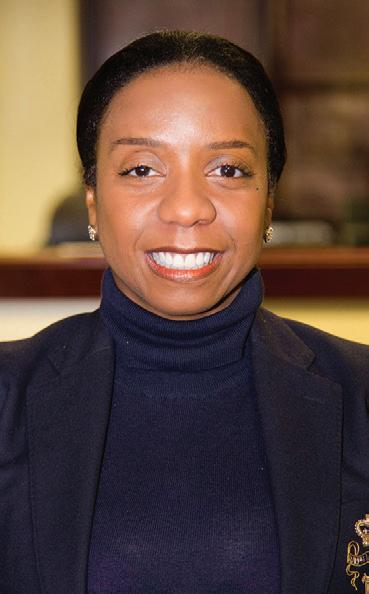
late 2020.
“The work continues in a different way, being a worker outside the system supporting the system inside.”
Regarding Knight’s appointment, McCoy said, “Selecting a strong successor is the most critical step to sustain success. Our amazing Board of Education has done just that with Dr. Paula Knight. She is an amazing education leader with whom I have had the pleasure of serving side-by-side for over two decades. Now, I am proud to pass this torch to Dr. Knight on July 1st.” Knight will be moving to the Jennings position from her current job as deputy superintendent and chief academic officer in the St. Louis Public Schools, where she began her career in
education in 1994 as a classroom teacher at Hamilton Elementary.
The news release noted her numerous community organization involvements. She is a past president of the Urban League Guild-St. Louis chapter, a member of the NAACP, an Education Steering Committee member for the Regional Arts Commission, and a member of the Board of Directors with the United Way of Greater St. Louis, among other volunteer positions.
She was appointed in 2013 to then-Gov. Jay Nixon’s Coordinating Board for Early Childhood, the state’s public/private entity for coordinating a cohesive system of early childhood programs and services. Under Knight’s leadership, student enrollment in Early Childhood programs increased from slightly over 1600 in the city of St. Louis to 2,210 in the 2017-2018 school year.
Early childhood education, Knight said, is her passion.
“I truly believe the earmark of any successful
By Dana Rieck Of The St. Louis American
St. Louis Alderwoman and mayoral candidate Cara Spencer began airing an ad Tuesday attacking Aldermanic President Lewis Reed’s political record, an effort Reed called a “sad old racist trope.”
n “Shame on her for running racist, divisive and offensive ads.”
— Lewis Reed
The 30-second commercial claims Reed has led the city in the wrong direction for more than 20 years. In true political ad fashion, grainy footage of Reed is used, in addition to several shots of various news articles — one in 2020 about St. Louis reaching its highest homicide rate since 1993; another questioning his push to privatize the airport and one about Reed receiving an ethics fine.
“The Reed Record? Corruption, cronyism and crime that’s out of control,” a narrator says at the beginning.
The commercial also features a man and woman who talk about their personal connection to crime. They call for change, asserting politicians have had their chance and failed.
“St. Louis is in the fight of its life and I’m
By Dana Rieck Of The St. Louis American
Several local advocacy groups on Wednesday asked St. Louis officials to allow attorneys to inspect the conditions at the St. Louis City Justice Center following the recent uprising. The city responded with a resounding “no,” and an accusation that these organizations “clearly intended to spread a false narrative” by sending their letter with the request. The group of organizations sent the letter to St. Louis Mayor Lyda Krewson, Public Safety Director Jimmie Edwards and Corrections Commissioner Dale Glass. It was signed by individuals from the ACLU of Missouri, ArchCity Defenders, and the MacArthur Justice Center — as

After 17 years of separation, Al Sharpton files for divorce from his estranged wife, Kathy Jordan
TMZ says legal documents state they broke up in 2004, but the MSNBC “Politics Nation with Al Sharpton” talk show host filed his divorce paperwork in New York City last week. Sharpton and Jordan met in the 1970s when he was touring with James Brown and she was a backup singer. They married in 1980 and split after 24 years of marriage. TMZ says Sharpton has been in a relationship with Aisha McShaw since 2013.
Who do you want in the 2021 Rock & Roll Hall of Fame?
Mary J Blige, Tina Turner, Chaka Khan, Dionne Warwick, LL Cool J and Jay-Z are among this year’s 16 nominee individuals and groups. The late Nigerian musician and activist Fela Kuti was leading the vote at the beginning of the week.
To vote, you must enter your email address or log in via Amazon, Facebook or Google to pick your top five, one ballot per day, at vote.rockhall.com.
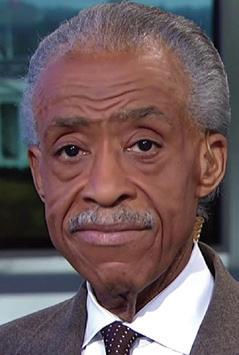
Fans can vote until each day April 30 for their favorite entertainers who are candidates for the 2021 Rock & Roll Hall of Fame.
cash into his own account in less than two years, for lavish spending on himself.
As TMZ reported, Queens County D.A. Melinda Katz said Syer built trust with Hart, when he was hired in 2015, by making legitimate, authorized purchases on Hart’s behalf. However, Katz claims Syer started siphoning off hundreds of thousands from Hart’s credit cards, depositing that money into his own bank

Personal shopper allegedly rips off Kevin Hart for $1.2 million
Actor and comedian Kevin Hart’s pockets are over a million dol lars lighter, allegedly thanks to the money grubbing hands of a personal shopper. TMZ reports that suspect Dylan Syer was in court in New York City last Wednesday, where he was arraigned on charges of grand larceny and nine other counts. Syer allegedly used Hart’s credit card information to launder nearly $1.2 million
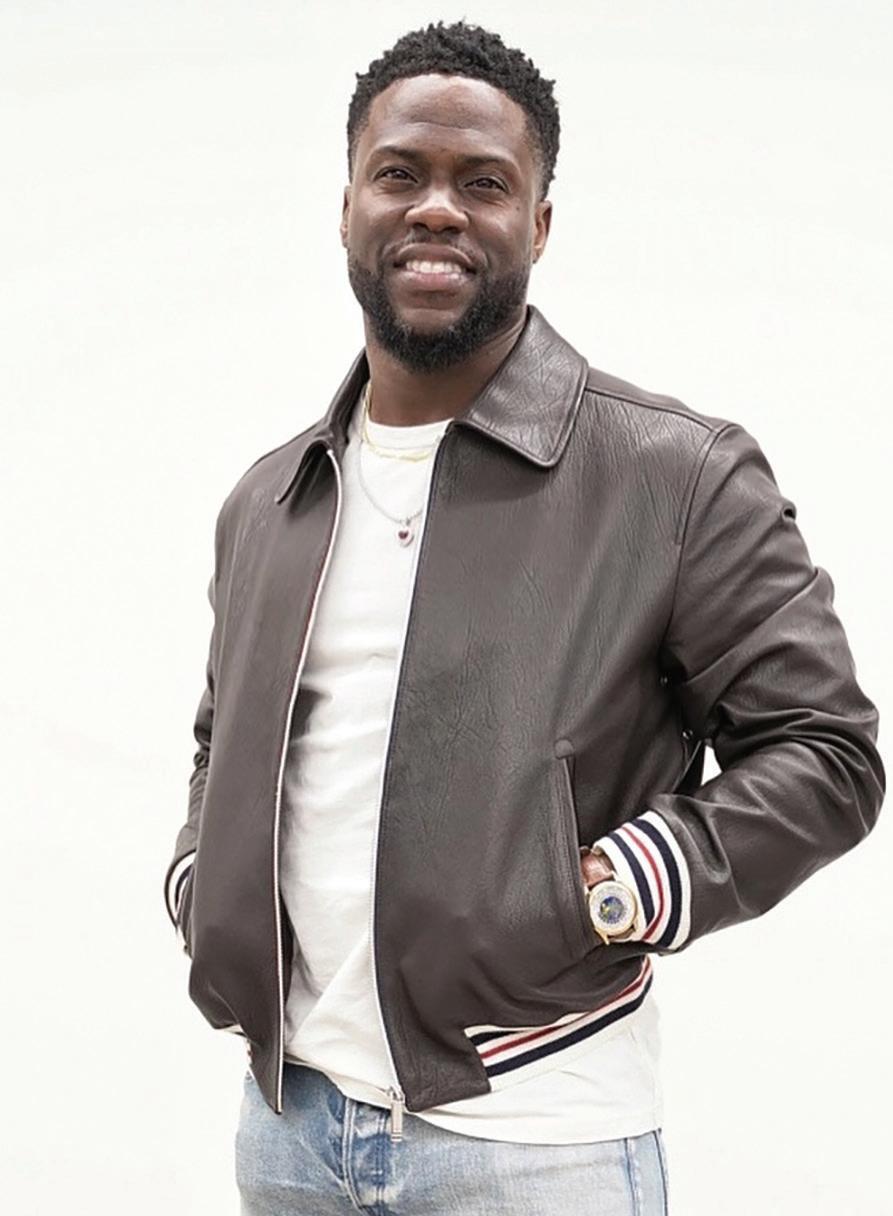
Prosecutors say much of the ill-gotten gain was used to buy expensive jewelry, watches, art, collectibles and luxury handbags.
NeNe Leakes claims her team did not drop her
Reality TV star NeNe Leakes reportedly has tea to spill about how black women get treated. On
Feb. 8 she tweeted, “I have numerous emails, text messages, RHOA group text, voice recording that go back yearsssss. I never got rid of anything! Fix your dirty work. Being a racist is so yesterday.”
Leakes tweeted, as reported in The Daily Mail, “You can’t turn on your teammate and get away with this @stevengrossman #DarrellMiller #Foxrothschild,” and “suppression, retaliation, discrimination, unequal pay, devaluation against black women is real, it’s painful and it hurts. I will fight for all women rights PS: FIX IT.”
The former “Real Housewives of Atlanta” star is denying reports by AceShowbiz and other outlets that she has been dropped by her entire team, including her agent, manager, lawyer and public relations team. A Feb. 9 tweet by Leakes reads, “For all of you that are asking, emailing, in boxing, blogging, reporting etc. The ONLY statement I have...My team DID NOT let me go! No further statements at this time.”
Sources: AceShowbiz, Daily Mail, Page Six, Rock and Roll Hall of Fame, Smart News, TMZ, Twitter







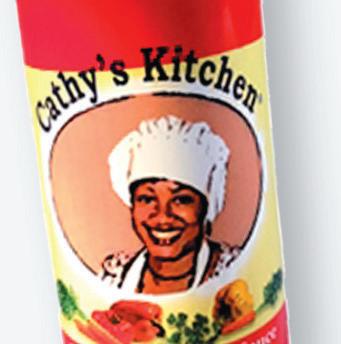



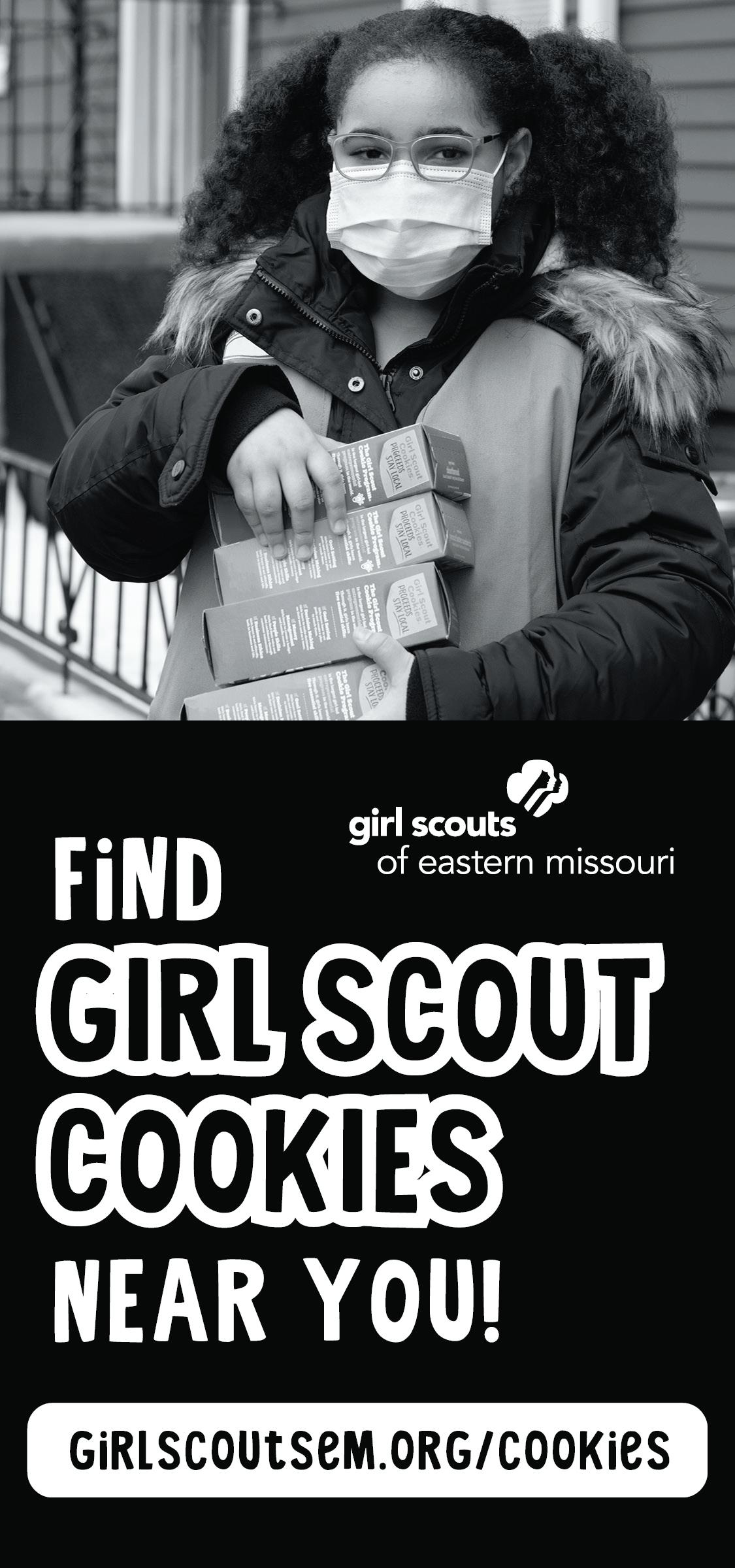

Andrew Jones Jr.
The continued population decline in St. Louis is directly tied to the failures of our elected officials. Their flawed initiatives and policies have created a climate where residents feel that living in the city is simply not worth it. However, all is not lost.
My plan provides the roadmap to recovery. The first step requires the drastic reduction of narcotic and gang homicides. We’ll target the small segment of criminals who are involved in drugs and gangs that commit approximately 80% of the homicides. Once accomplished, we can implement the viability initiatives necessary to inject vitality into the city.
I will commission the key stakeholders necessary to develop three comprehensive plans: an economic, business and community development plan that will create a template for housing, business designa-
tions and workforce development.
These plans will demonstrate a seriousness of purpose and they will provide us with a future direction and the opportunity for measurable progression. Potential residents and businesses need to feel safe and secure, and these plans will show that the city is committed to progress.
Tishaura O.Jones
To rebuild our population, we need to reduce crime and gun violence in our communities, rebuild our neighborhoods, and stabilize our school district.
The City of St. Louis stands at a crossroads. Industry leaders need to see that we have bold, transformative leadership as they consider relocating or bringing their companies to our city. People deserve to be able to be safe in their homes, have access to grocery stores, pharmacies, mainstream financial services and more, including fast and reliable internet.
As mayor, I will look to other cities that have reversed the trend of population loss, bring those solutions to St. Louis,

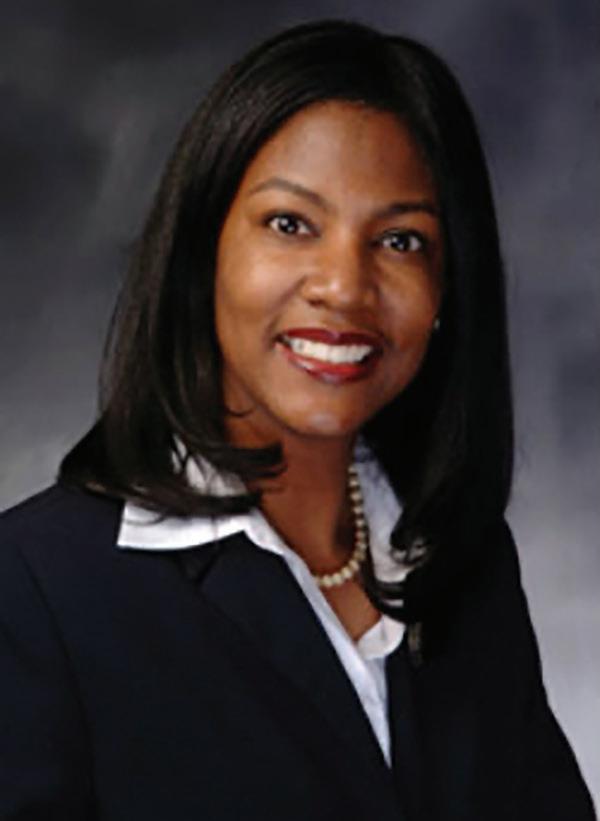
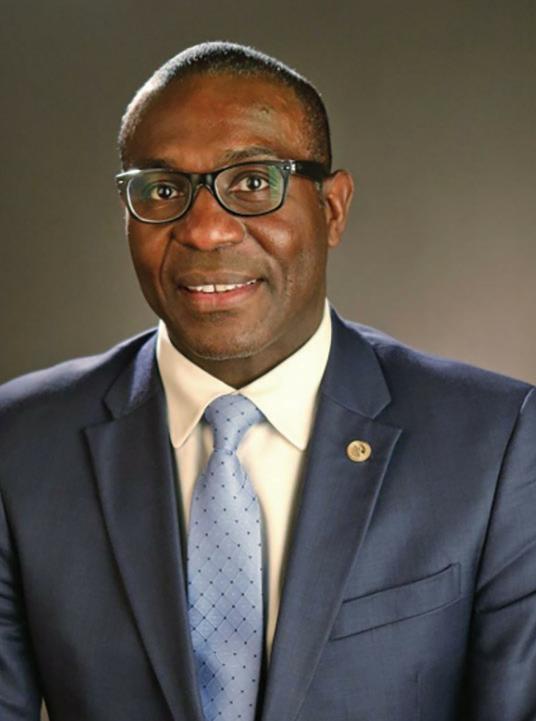

tweak them for our environment, and let them roll. We do not need to reinvent the wheel. We’re not a poor city; we’re a cheap city, and we have refused to invest in what will move our city forward.
Lewis Reed
“As mayor, I will increase the city’s population, which starts with retaining the residents already here by making their lives better. We will reduce gun violence and create more jobs to make life better for our current residents. I will make sure there are equitable opportunities for women and people of color. As mayor, I will get this city on the right track, and I want all the people who are living here now to benefit from that. I will not let policies and
conditions drive good citizens out. I want our neighborhoods to retain their character and affordability. As mayor, I will make sure our longstanding citizens get to enjoy the rebirth of our city. We have affordable housing units. We need to improve the environment that surrounds these housing units so that more people want to live here. Through my Equitable Economic Growth Strategy, every neighborhood will be a place people want to live. I will protect our public school system and allow it the chance to grow as our population grows.”
The St. Louis region has stagnated for the last 4 decades and has been out-performed by most major cities in the nation. In fact, over the last 10 years of economic expansion, the St. Louis region has performed at about a quarter of the national average. We cannot have a successful region without a successful city and I’m confident that the City of St. Louis, as the historic core, can lead our region out of stagnation and put us on the path to growth for the first time in decades. It starts by address-
ing some of the major structural issues holding our community back: violence in our streets and racial disparities. That’s why I’ve put together a 10-step plan for addressing crime, rooted in building trust. I’m committed to breaking down systemic racism and addressing disparities in health outcomes, neighborhood investment and the delivery of city services. I am committed to leading without the influence of special interests, protecting our public resources, building new systems of public safety and justice, and bringing prosperity to neighborhoods both north and south of Delmar.

U.S. Congresswoman and Ferguson frontliner Cori Bush this month announced her congressional subcommittee appointments: she will serve on the Subcommittee on Crime, Terrorism and Homeland Security as well as the Subcommittee on the Constitution, Civil Rights and Civil Liberties, within the House Judiciary Committee. She was assigned to the Judiciary Committee in mid-December. Within the House Committee on Oversight and Reform, she will be serving on the Subcommittee on Economic and Consumer Policy, as well as the Subcommittee on the Environment.
These subcommittee appointments will be a serious test of Bush’s ability to bring to life her promises to the people of St. Louis. They are, certainly, full of opportunity, and a welcome sign in what has been a tumultuous start to Bush’s congressional career: First, the storming of the Capitol. Then attacks from one of her fellow Congress members, noted Republican, racist, and anti-Semitic conspiracy theorist Marjorie Taylor Greene, whose behavior ultimately caused Bush to relocate her office.
will be good to have a nurse on the committees overseeing the force doing the pepper spraying: she’s there to look out for us.
So, too, she is also on the subcommittee for the Environment. In late January, Bush partnered with U.S. Sen. Edward Markey, D-Massachusetts, to introduce legislation that would develop a nationally-coordinated, interactive mapping tool to depict environmental violence.
Here, Bush brought a conversation that has been going on for years locally and in more activist circles nationwide onto the governmental stage: the fact that environmental injustice is racism.
n These subcommittee appointments will be a serious test of Bush’s ability to bring to life her promises to the people of St. Louis.
Bush’s appointments to the Subcommittee on the Constitution, Civil Rights and Civil Liberties and Subcommittee on the Environment are particularly prudent and commendable — and not just because they’re a big deal for a freshman congresswoman.
Having someone who, just last summer, stood with protesters and was tear-gassed with them in front of the Florissant Police Department now overseeing the Congressional Committee that investigates civil rights violations is a powerful image, to say the least.
At one point on a hot July evening, Bush paused while washing tear gas out of her own eyes to inquire after the well-being of one of this newspaper’s own reporters. That spirit is indicative of a nurse’s concern for others and a protester’s willingness to put herself in danger. It
The map that Bush and Markey outlined would help ensure that the Biden administration’s investments in environmental development would be targeted toward areas that have been most harmed by racist and unjust environmental practices.
From a St. Louis perspective, that appointment to the Subcommittee on the Environment means something. This region experiences no shortage of environmental racism.
It’s a place where Black children are 2.4 times more likely than white children to test positive for lead in their blood, and visit emergency rooms due to asthma 10 times more frequently than white children do.
It’s a city where nearly all major air pollution sources, according to a 2019 Washington University report, are located in communities of color, and more building demolitions occur in majorityBlack neighborhoods — demolitions that release harmful dust, often containing asbestos and lead, into the air.
Bush’s meteoric rise to national prominence means that St. Louis gets to be in the national news for something good, which we know is rare enough here. Her national spotlight is in a sense a spotlight for Black St. Louis in particular. So, Cori, keep fighting for us. Keep bringing St. Louis with you. Now more than ever.
By Adofo Minka For The St.
Louis
By Ray Curry For The St. Louis American
A month into a tumultuous start of a new year, a new year following the most chaotic year in America that any living person can remember, I am seeing signs that the work in the streets and in our hospitals and at our voting booths, are saying even in states no one thought we would have captured after 2016, that even though we have been hit hard on so many fronts, it’s our front line that is now advancing for the greater good.
It is divisiveness and hate that must retreat; it is science that will now confront the coronavirus.
And it is Americans of color who overcame at the polls to deliver the House, the Senate and the presidency.
Contentious as it was, more Americans voted in the 2020 election than in any other election in 120 years. And look at what we did together.
A historic start
We elected the first Black, female, Asian vice president in Kamala Harris.
We elected in a historic runoff election, the first Black senator from Georgia in more than a decade in the Rev. Raphael Warnock.
Warnock, the pastor of the historic Ebenezer Baptist Church — where Dr. Martin Luther King Jr. once was pastor — has dedicated his life to service and ministry.
And we tipped the U.S. Senate for hard working men and women by also delivering his fellow Georgian Jon Ossoff.
Out west, Wyoming elected their first female senator; Missouri sent its first Black congressperson to D.C.; Delaware elected its first transgender senator.
The voters of New Mexico made it the first state to send a delegation to the House
of Representatives made up entirely of women of color.
And this 117th Congress is the most diverse in our country’s history just as President Joe Biden’s cabinet promises to be.
So, for me, 2021 is about hope and about working for a better life for all and a better nation, as we rise from the terrible test that 2020 has been. It is about recommitting to one another and to good works to help our brothers and sisters in need.
And even before we voted for inclusion, we were already making good trouble.
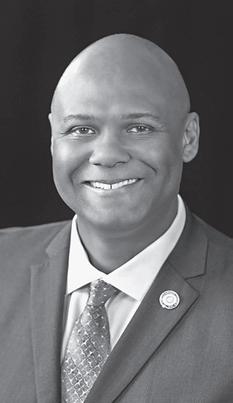
White, Black and Brown nationwide took to the streets this past spring and summer to ask our nation — to demand of our nation — that we address the systemic racism that has plagued this country since its founding. With one voice, all were saying:
“Please, at long last, fix this.”
Our path is clear
It is time to think not of ourselves, not of what divides us, not of our differences, but of our common good. It is time once again to remember that there is much, much more that unites us than divides us. Those who would seek to divide us, do not want us to see this truth.
But it is here and it is powerful.
And we must embrace it. We must together reform policies and institutions and thinking where injustice resides and restore people to the status of neighbors, not opponents.
Walter Reuther, the great UAW president who was a close friend and supporter of Martin Luther King summed it up like this:
“There is no greater calling than to serve your fellow man. There is no greater contribution than to help the weak. There is no greater satisfaction than to have done it well.”
President John F. Kennedy famously put it just a bit differently. “Ask not what your country can do for you — ask what you can do for your county.”
With those words, he inspired a generation of Americans. So, this is our time. It is time for our generation. Our historic moment. There are Americans who need our help. The coronavirus pandemic has ravished us as nothing we have ever experienced. But here too I see hope ahead.
I see President Biden moving quickly to put battling COVID19 front and center and to put good practices and science and the federal government back in the driver’s seat.
I see us recommitting to our better angels, to help fellow Americans who are suffering and struggling.
In this vein we must also support our veterans. Those brave men and women who make the greatest sacrifice to protect all of us and our great nation. And we must participate in this democracy of ours, just like we saw in this past election. We must stand strong and united against bigotry and hatred and heed the call we saw this past year as hundreds of thousands of Americans took to the streets to demand a fundamental change. There is real work ahead, but I believe we are up to the task. Let us meet 2021 head on and with solidarity. We are more than ready to bring our A game. Ray Curry is secretarytreasurer of the United Auto Workers. This commentary was provided by BlackPressUSA and the National Newspaper Publishers Association.
All letters are edited for length and style. As I See It - A Forum for Community Issues
More senators need spines
ed more senators with spines.”
I agree — especially senators from the state of Missouri.
American
After repeatedly having their requests for basic human decency ignored and being subjected to the hellish conditions that exist in the St. Louis City Justice Center, detainees justifiably said enough is enough.
Unwilling to accept the barbarity of violence and degradation of the state, these men spoke the only language that their oppressors understand. They spoke the language of violence that the state has been speaking to most of them all of their lives.
Yet, elected officials continue to be tone deaf to the legitimate and serious concerns that caused the powder keg that is the City Justice Center to explode.
In the aftermath of the detainee’s minor destruction of state property in the form of a few broken windows and burned bed linens, Public Safety Commissioner Jimmie Edwards feigned as if he was unaware of the detainee’s grievances. Edwards stated that no reasons were given nor demands made leading up to the actions taken by detainees after their countless appeals to human decency were ignored for weeks leading up to the uprising.
In the same breath, however, Edwards spoke of locks on cells inside of the jail malfunctioning. Does he seriously expect the public to believe that the locks on the cells are the only things in the jail that are in disrepair and disarray?
In such facilities, violence is routinely meted and/or facilitated by guards as a way to exact control over people warehoused as they await their day in court for years. In fact, it is alleged that an inmate being accosted by a guard was the spark that lit the powder keg that exploded into the melee that ensued at the Justice Center.
What detainees have described to the public in the aftermath of the uprising is a facility and treatment unbefitting animals, let alone human beings.
For Mayor Krewson to make a declaration that all is well, she must really be out to lunch and expects commoners to be out with her. But ordinary people know better.

Politicians’ blatant denial of reality are slaps in the face to those detained at the Justice Center, their loved ones, and the general public who they expect to believe such mystification of the dismal reality that detainees face at the Justice Center.
Equally disturbing as the obfuscation in the aftermath of the Justice Center rebellion, are the insincere calls for reform and independent investigations into the conditions at the Justice Center. Individuals who make such calls pretend that they are unaware of the conditions that have existed at the Justice Center long before detainees took matters into their own hands.
In a news conference after the uprising, St. Louis Mayor Lyda Krewson claimed that all is well with conditions inside of the facility. Anyone who has spoken to anyone detained in the Justice Center or any jail or prison in America knows that this is a mendacity of great proportions.
Not only have such people known of the barbarity, but their silence has served as a rubber stamp of approval. Now, such political opportunists run to reduce what is playing out at the Justice Center to reformist talking points because at this moment it is politically expedient to do so.
What should not be obscured by these false calls for accountability is the role and function of the carceral state in St. Louis and across this nation. That role and function is to coerce, exploit, degrade, and heap brutality upon those it warehouses. Such barbarity cannot be reformed. It must be abolished. I do not mean defund.
If the cycle of violence that results in intermittent jail and prison rebellions are to be avoided, ordinary people must take seriously the task of taking responsibility for organizing their own judicial affairs which includes making a determination of what are the appropriate means to punish and when possible, rehabilitate those who have violated people, not property. It is evident that professional politicians above society have failed miserably at this task.
Ordinary people must also discard the false solutions of bourgeois sociology offered by those who aspire to administer their lives. These elite, professional politicians who rule above society hold Black and poor toilers in contempt and see them as unfit to govern.
These are responsibilities that cannot be avoided if commoners are to rid themselves of the intermittent explosions that have become all too familiar in America’s jails and prisons.
Adofo Minka is a criminal defense attorney and St. Louis native.
Regarding “Support grows for riot inquiry after ‘heartbreaking’ verdict,” St. Louis PostDispatch, Feb. 14, 2021, I believe that the House Managers did an excellent job prosecuting Donald Trump. Sen. Mitch McConnell, R-Kentucky, by acquitting Trump, then saying that Trump was wrong, made me think of if the United States had said at the beginning of World War II that the atrocities going in in Europe were wrong but that we weren’t going to do anything about them.
I agree with Delegate Stacey Plaskett, a House prosecutor who represents the Virgin Islands, “But, listen, we didn’t need more witnesses. We need-
Linda Caravelli Florissant
Trump’s lawyer showed own contempt
In the second impeachment trial, Donald Trump’s lead lawyer barely concealed his client’s racism, sexism and anti-Semitism. He directed special vitriol toward Vice President Kamala Harris and House Manager Jamie Raskin.
Attorney Michael Vander Veen endlessly repeated visual images of Harris, essentially depicting a Mammy gone rogue,
and portrayed Rep. Jamie Raskin, D-Maryland, a Jewish man, as morally and professionally bankrupt.
The defense played Trump’s video image of Harris encouraging partisans to “fight” many more times than images of others. The former president’s counsel accused Raskin of being a liar, engaging in “impeachment lust,” being “intellectually dishonest,” and arguing like “a first-year law student.” Counsel denigrated him as a criminal who “manufactured and doctored evidence,” and engaged in “prosecutorial misconduct.”
Kimball Shinkoskey Woods Cross, Utah





By Jamala Rogers For The St. Louis American
When I first saw the images of three gaping openings at the City Justice Center, I saw them as possible escape routes. If I was one of the detainees who knocked out the windows on Feb. 6 in protest of conditions, I think I would’ve jumped for safety and supported the demands from an unknown location. At least I would be safe from COVID-19 and live to fight another day. Those nearly 120 or so detainees weren’t interested in escape. They needed the attention of the public to hear their plight and bring some relief to the wretched situation, sadly reminiscent of jail conditions under dictators of repressive regimes. Their cries for help extended way past the St. Louis region and were heard around the world.
We can say with some assurance these detainees weren’t interested in escape. You know the locks that officials reported as being jammed by jail residents to get out of their cells to “riot”? These have been faulty for a while and to the knowledge of most inside the jail. At any given time, detainees could’ve taken advantage of the situation.
A task force was recently convened by the mayor to investigate. This appears to many to be more about public relations than public solutions. Partly, this is because Mayor Lyda Krewson is out of office after the April general election. The other part is because her administration has not shown leadership on issues such as the pandemic and criminal justice for the last four years.
Such a task force would have been critical about a year ago, when the criminal justice system would ultimately collide with the coronavirus pandemic, which has created extraordinary circumstances that require extraordinary measures.
The mayor, the governor and the president can use executive powers to temporarily cut through statutory and legislative barriers that prevent us from getting to humane and holistic goals in the face of global pandemic.
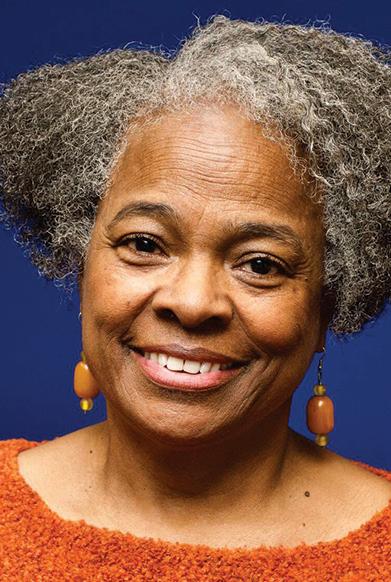
Feb. 6 was the third attempt by Justice Center detainees to get the attention of policy makers. The other two attempts were covered up by
Commissioner Dale Glass, Public Safety Director Jimmie Edwards and the mayor with guarantees that everything was under control. They were not. Obviously.
Several groups are working with detainees and their families as part of their missions. Their levels of involvement have intensified since the virus reared its ugly head inside these correctional facilities operated with our tax dollars. On both the state and local levels, CDC guidelines are not being followed, and caged men and women are sitting ducks for the deadly virus. Implications are that detainees are not human and have no rights.


(WIC)
Remember, most of the detainees are awaiting trial and have not been convicted — innocent until proven otherwise.
Detainees who participated in the three protests should receive immunity. Many are now facing retaliation by being subjected to even more inhumane conditions. What happens to those who ignored the dangerous situation for months until it erupted into property damage and bodily injuries?
The City Justice Center situation is characteristic of the racist systems that see Black bodies as subhuman. What detainees deserve is humane treatment and a right to a speedy trial. They are being denied that and more.
The conditions at the Justice Center and the Workhouse are not the sole responsibilities of the detainees, their loved ones and a handful of social justice groups.
This is one of the serious problems plaguing St. Louis. Issues, like our neighborhoods, have been racialized and marginalized. This allows them to be quietly and comfortably pushed to the side and ignored.
Krewson’s days as mayor are numbered, but we still have a city to manage and grow.
On April 6, St. Louis voters will elect the next mayor. This person must be a mayor who doesn’t believe pitting interests and exploiting differences in the best way to lead.
If we don’t embark upon collectively building a more racially-just and equitable city, St. Louis will always be projected in the national news for all the wrong reasons.



its
St. Louis American Staff Journalist, author and syndicated columnist Roland Martin is traveling to St. Louis this weekend to support mayoral candidate St. Louis Treasurer Tishaura Jones’ bid for office. Martin will co-host a virtual town hall event with Jones at 6 p.m. Friday from the Omega Center on Goodfellow Boulevard. People can watch the event at www.Facebook.com/stltreasurer/live and are encouraged to offer questions. Jones and Martin will host a “Stroll to the Polls” canvas from 12:30 to 4 p.m. Saturday at Ivory Perry Park, where Jones announced in November that she was running for mayor

Martin has been a host, guest and commentator on numerous broadcast and print media outlets. As an author, he has written the books “Speak, Brother! A Black Man’s View of America,” “Listening to the Spirit Within: 50 Perspectives on Faith” and “The First: President Barack Obama’s Road to the White House as Originally Reported by Roland S. Martin.” Jones is running against St. Louis Board of Alderman President Lewis Reed, Alderwoman Cara Spencer and businessman Andrew Jones Jr. The primary for the mayoral election will be held March 2 and the general election will be held a month later on April 6.

Opera Theatre of Saint Louis will host A Toast to Opera with the Intermezzo Society on Zoom at 6 p.m. on March 4.
Led by Crystal Allen Dallas and Marcela Manjarrez Hawn, the Intermezzo Society is a group of professionals in and around St. Louis who are dedicated to supporting the arts while building their own communities. For more information: ExperienceOpera.org/Intermezzo

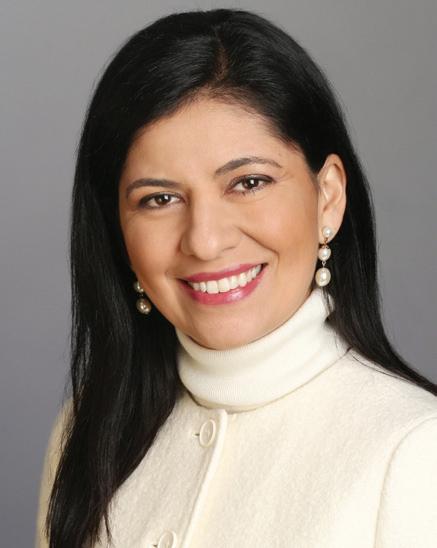
What led you both to become involved with OTSL?
CAD: My first involvement with Opera Theatre was at an event called Opera Tastings. The themed performances represented a cross-section of the St. Louis region and I loved that Opera Theatre ensured the diversity of performances, people, and locations.
MMH: Since I was a little girl, growing up in Mexico City, my mother and I would go to the opera as a special mother-daughter activity. As a Saint Louisan, I was delighted to learn of OTSL! I have taken my 19-year old twins to the opera since they were very young to instill love and appreciation for this wonderful art form.
You’re hosting an event on March 4. Tell us more!
MMH: The event is a great opportunity to gather virtually and meet new people, and perhaps see old friends as well. It will be a great and fun experience, both for anyone who is new to opera and is curious what OTSL is all about, and for anyone who is already passionate about opera.
What would you say to someone who has never attended an opera?
CAD: OTSL is a great entry point for someone who has never attended an opera. We do not take ourselves too seriously and neither should you. As a transplant to St. Louis, OTSL has been a great way for me to meet new people. Lastly, opera is for everyone!
MMH: Do not let never having attended an opera intimidate you. The typical opera format is in Italian, but OTSL has operas in English so that is not a barrier at all. We invite you to join us and give it a try!
Q: What is next for Opera Theatre?
CAD & MMH: The summer opera festival is always the best time of year! This year, it will all be happening safely outdoors and you can learn more at ExperienceOpera.org.

David Steward, World Wide Technology chairman, contributed $25,000. Steward is a longtime Reed supporter, having contributed more than $150,000 to Reed’s past unsuccessful mayor bids.
United Food and Commercial Workers, a labor union, contributed $10,000. The other three contributions were from Progressives for Mary Entrup ($387.12), Nexus PAC ($5,000) and Milan Patel ($2,000).
In light of those contributions, it’s no surprise Reed’s campaign committee launched a six-figure TV ad campaign Sunday. In it, Reed talks about losing his brother to gun violence and coming up from a difficult time while homeless.
A new PAC established in December, Leadership Counts, received $32,400 in contributions on Feb. 11 — $25,000 of that coming from Steve Stone, developer Paul McKee Jr.’s longtime attorney.

A worker shovels the snow from the walkway of City Garden Plaza downtown Mon. Feb. 14, 2021.
paign, which references her 10-point plan to reduce crime and “a commitment to rebuild our local economy.”
Utility executive Andrew Jones Andrew Jones, the sole Republican in the race, is self-funded, having loaned his campaign $10,000 of the $11,100 it raised. Records indicate no PACs have given directly to his campaign or supported him in other financial ways.
The primary for the mayoral election will be held March 2 and the general election will be held on April 6. With the passing of Proposition D on Nov. 3, the primary will be nonpartisan and voters will be asked to vote for every candidate they approve of. The two with the most votes, regardless of party affiliation, will go on to the general election.
The St. Louis Post-Dispach has endorsed Lewis Reed and Cara Spencer in the mayoral primary election.
In February 2020, McKee asked the St. Louis Board of Estimate and Apportionment for an extension on its deadline in his hospital project in north St. Louis and is currently embroiled in litigation with the City of St. Louis for defaulting on his NorthSide Regeneration development agreement. Stone also helped write the 2007 Distressed Area Land Assemblage tax credit law and, according to the St. Louis Post Dispatch, in 2012 Stone’s company sold less than an acre of vacant ground north of downtown to McKee for $463,000, creating $230,000 in state tax credits. Stone also donated $2,600 to Reed’s campaign through his company University Square Company and another $2,600 under his name.
In addition, Leadership Counts contributed $2,500 in December to theLouPAC, a committee that donated $10,000 to the Committee to Elect Reed in September 2018 and $2,600 to his current mayoral bid.
St. Louis Treasurer
Tishaura Jones
As for St. Louis Treasurer Tishaura Jones, her PAC 314 Forward has raised about half ($104,000) of what Reed’s has, with three times the number of contributions. Eighteen of those contributions were each $3,000 or less.
Fuse Advertising is 314 Forward’s largest funder, contributing $20,000, plus an additional $5,000 from its CEO Clifford Franklin. Fuse Advertising bills itself as an independent political consultancy company that has worked on campaigns across the country such as President Barack Obama’s bid for the executive office and Jay Nixon’s bid to become Missouri’s governor.
Right behind Fuse Advertising is The St. Louis American’s publisher, Donald Suggs, and Michael Homes, RX Outreach chairman emeritus, who each contributed $15,000. Alison Ferring, a local philanthropist, donated $10,000. Cafe Soul St.
Louis contributed $8,000. Jones’ and Reed’s PAC funding somewhat mirrors their campaign committee fundraising — 90% of Reed’s $166,906 came from 71 contributions and of the $155,647Jones received at the time of the report, more than 550 contributions amounted each to $50 or less.
Alderwoman Cara Spencer
While Alderwoman Cara Spencer, Ward 20, may have outraised all three of her opponents, her PAC financing is almost nonexistent in comparison to Reed and Jones. Gateway to Progress was founded in
mid-December and the PAC has received one $10,000 contribution on Feb. 10 from Daniel Ludeman, CEO of Concordance Academy.
Ludeman previously served as CEO of Wells Fargo Advisors and now runs Concordance Academy, which seeks to enhance the re-entry experience for formerly incarcerated individuals and reduce their risk of reincarceration.
Because the PAC is only two months old, it has not filed any reports, meaning contributions less than $5,000 are not available through the Missouri Ethics Commission yet.
Gateway to Progress paid for Spencer’s television ad cam-
How we vote is changing and AARP is fighting to make sure that the voices of voters 50+ are heard.
In November, St. Louis City voters passed Proposition D, creating a two-part election system for this Spring’s elections for mayor, comptroller and 16 aldermanic seats.
• Under the new system, all candidates for the March 2nd election will appear on a single, nonpartisan ballot.
• You can vote for all of the candidates who you approve of for each office.
• After the March primary, the top two candidates for each office will compete in a general election run-off on April 6th.
For more information about this Spring’s elections, including how to request a ballot, register to vote, and locate your polling place, visit aarp.org/stlouisvotes. facebook.com/aarpmissouri @AARPMissouri | aarp.org/stlouis
Continued from A1
Spencer and no matter where you live in St.
I am committed to keeping you safe,” Spencer says at the end of the ad. In a media release sent a few hours after Spencer announced the ad on Twitter, Reed condemned the ad as a racist attack. “This is a sad old racist trope — blaming black leaders for crime,” Reed wrote. “The fact is I lost my brother to violent crime, and most recently my nephew was shot, killed, and burned in a dumpster. My own son has even been held up at gunpoint outside my own home. I know the toll violence is taking on our community. Shame on her for running racist, divisive and offensive ads.” Reed goes on to argue he’s spent years working to fight crime and Spencer has “done absolutely nothing in her time in office.”
“The darkened, grainy image and racial fear tactics she uses are reminiscent of racist political ads that were designed to paint a frightening image of candidates of color,” Reed wrote. “This type of ad is from a time most of us hoped we had long gotten past.” Spencer released a statement in regard to Reed’s comments about the ad:
“Elections are about choices, and voters need to be informed to be able to choose,” she wrote. “This ad is about Lewis Reed’s record over 14 years in the second most powerful office in the city, his failure to improve St. Louis during that time, and his work for a failed plan to sell Lambert Airport to benefit his contributors. I challenge him to point to anything in the ad that is not rooted in fact.”
St. Louis Treasurer Tishaura Jones, who is also running for mayor, told The St. Louis American this kind of public scrutiny is the downside to being a political candidate.
“And as someone who has been repeatedly attacked by some in the media, I definitely can empathize with how he feels, because I can’t tell anybody how to feel about how they perceive an ad, and his perception is 100 percent his,” Jones said.
“… I totally expect someone to put an ad about me and stuff that they don’t agree with how I handled different things in my political career. And that’s the unfortunate part about when you’re running for the top spot in the city — you’re gonna get blamed, whether you had a hand in it or not, for the current state of things.”
Utility executive Andrew Jones, the fourth candidate on the mayoral primary ballot, said he had not seen the commercial and was focusing on his own campaign.
“This doesn’t surprise me, when you don’t have a winning strategy, or tactics, to turn the city around I guess it gets reduced down to personal attacks and I just don’t want to be involved with personal attacks — I’m here to help the city,” Andrew Jones said.
The letter states that, in light of the “significant discrepancies between what we are hearing from directly impacted people and the information shared by the City,” the coalition of organizations wants officials to verify, within 24 hours, that they are providing full and complete access to food, clean drinking water, mattresses, and bedding for all inmates.
In addition, the letter asked the city to immediately grant access to housing units and common areas in the Justice Center for attorneys to inspect, verify and document conditions inside, including the ability to talk with detainees.
The letter indicates the organizations have received reports from inmates, who say that since Saturday’s uprising, some inmates are only being given one meal a day.
Others, according to the letter, have gone up to 72 hours without food or water.
People are sleeping on floors and non-functioning toilets are overflowing from use.
In response to the letter, Michael Garvin, the city’s

provide tours of the facility,” he wrote.
Rep. Cori Bush sends letter
Continued from A1
district is based on early childhood education, so ensuring that opportunity is strengthened for all children.”
attorney, refuted the claims that the jail was not taking proper COVID-19 precautions or providing adequate basic needs to the inmates. He said these accusations were an insult to all staff involved with running the jail.
He also called the inmates who participated in the protest “incarcerated rioters” who “committed felony crimes.”
“The rationalizations suggested by your group for this criminal conduct are simply false,” he wrote.
“CJC staff is currently focused on assessing and repairing the damage caused by the rioters. We do not plan to
n Paula D. Knight will be moving to the Jennings position from her current job as deputy superintendent and chief academic officer in the St. Louis Public Schools.
U.S. Rep. Cori Bush, D-Missouri, also wrote this week to Krewson, Edwards and Glass regarding her concerns about jail conditions following the Feb. 6 uprising. In it, she asks for data regarding coronavirus testing, transmission and precautions, as well as other information regarding the nature of charges the inmates are being held on, other jail protocols, current conditions of the jail, and a breakdown of how CARES Act funding has been spent within the jail.
“If we’re not listening then they’re going to continue to cry out, and so that is on us,” she said in an interview with The St. Louis American.
“And so that’s why we sent that letter to the city officials to say, ‘let’s talk about this.’ And the thing is, we want to talk about it, we want to address it, we want to make it public, so that we can have better account ability. And then also so that those conditions can change to the people who are there.”
The letter can be read at https://bit.ly/373lqFM.

cited to be working in a smaller district where she will be able to interact more directly with those she serves.

The Jennings School District is made up of eight schools serving about 2,500 students. Jennings
As such, her primary goals will be to strengthen the beginning and the end of a Jennings student’s education — the Early Childhood program, drawing on her previous experience — as well as the post-secondary opportunities the district offers. In addition, she said, she is ex-
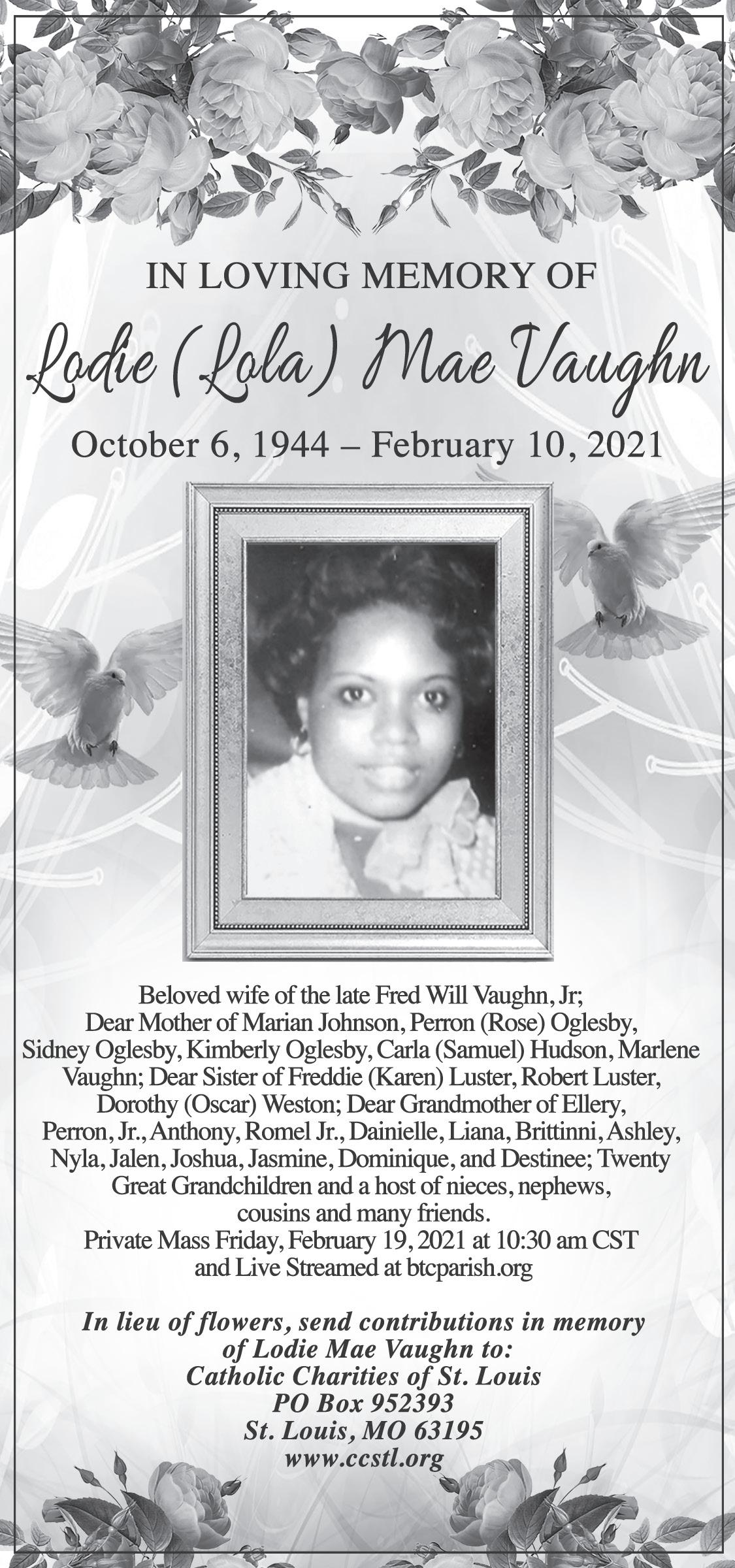
“I’m going from being responsible for 70+ schools and a large teaching population to a much smaller, more intimate district, which I am truly looking forward to,” Knight said.
“I’m really looking forward to this. It is a tremendous, humbling opportunity.”
If you or someone you know is 55 or older and a smoker or former smoker, take action. Get Screened.

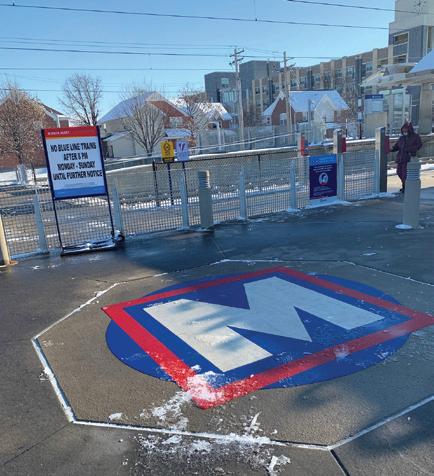
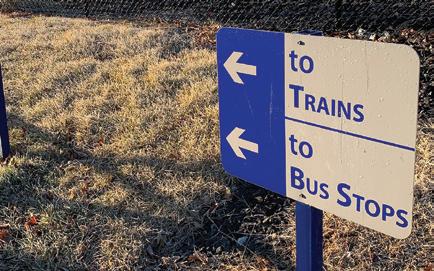
We are looking for your feedback for our Emerson Park Transit Stop Transformation Project. The St. Clair County Transit District, Citizens for Modern Transit, AARP St. Louis, and Metro Transit have partnered to transform this space into an active, creative, playful environment for riders and community members. Do you have a vision for the space? Collaborate virtually to give us your thoughts on how to turn the existing space into an urban oasis that reflects the rich cultural heritage of East St. Louis. We want your input!





By Corinne Ruff St. Louis Public Radio
American Airlines plans to furlough nearly 1,200 employees at St. Louis Lambert International Airport starting in early April when federal aid for airline workers expires.
In a letter to the state on Friday, the airline also said it would permanently lay off three employees in St. Louis.
That’s part of a larger plan to temporarily furlough 13,000 employees across the country, according to a letter executives sent to employees last week.
American Airlines Chairman and CEO Doug Parker and President Robert Isom said in the letter that the company is in for another summer of reduced flights, despite hopes of a turnaround.
“We are nearly five weeks into 2021, and unfortunately, we find ourselves in a situation similar to much of 2020,” they said. “The vaccine is not being distributed as quickly as any of us believed, and new restrictions on international travel that require customers to have a negative COVID-19
n American Airlines Chairman and CEO Doug Parker and President Robert Isom said in the letter that the company is in for another summer of reduced flights, despite hopes of a turnaround.
test have dampened demand.”
The executives said federal payroll support helped them keep workers employed last year and they’re supporting union efforts pushing to extend aid until September.
American Airlines is the second-largest airline at Lambert after Southwest, accounting for 16% of passenger traffic last year.
A Lambert spokesperson declined to com-
ment on how the announcement may impact the airport.
The airline industry continues to deal with major losses caused by a drop in passengers due to the COVID-19 pandemic. Industry sources say air travel plunged 95% last year, although it has improved slightly in the last few months.
According to industry sources, domestic air carriers had about 133,000 employees last fall. That total is expected to dip to fewer than 100,000 by this spring.
In addition to St. Louis, other airline hubs have announced plans to furlough or permanently let go of thousands of employees in the coming months.
According to Forbes magazine, Dallas-Fort Worth Airport is expected to furlough 2,700 employees in the coming weeks. Both Philadelphia and Miami are each planning to lay off 1,000 employees, while Charlotte airport has indicated that it will furlough about 700.
Corinne Ruff is the economic development reporter for St. Louis Public Radio, a media partner of The St. Louis American.
By Marissanne Lewis-Thompson St. Louis Public Radio
Leslie Christian-Wilson,
owner of Diversity
Gallery hair salon and boutique in St. Louis, has worked hard to keep her business going in the past year. Since the coronavirus pandemic began, she’s seen appointments canceled and lost 60 percent of her revenue. Selling natural hair care products and business from the boutique have helped. But she’s been able to keep her head above water with the help of the non-profit Habitat for Neighborhood Business, which helped her find grants and other resources to stay open.
Since 2006, the nonprofit has paired entrepreneurs of color with professional mentors in their field. It also brings in St. Louis University students from the Richard A. Chaifetz School of Business to assess their business and how to improve it.
“The executive directors, they are really like our aunties,” Christian-Wilson said. “They’re really out there ‘auntying’ for us. They’re making sure that, OK, do you know about this program? They’re bringing in bankers, like Enterprise Bank, so that we can sit with them and talk through our issues. Because our issues are not like issues of these conglomerates. We don’t have the resources to come in and put collateral down.”
Habitat For Neighborhood Business works with 40 minority-owned businesses, all of which have managed to stay open during the pandemic, said its executive director, Linda Jones.
The non-profit helps entrepreneurs of color secure grants and other financial assistance and helps them shift their businesses to online business models.
Jones said that turned an event planner’s busi-

ness around after the company’s events were canceled.
Thinking outside the box
“It’s not over yet,” Jones recalled telling the
owner. “Let’s think about this. People are using Zoom. They need backdrops. They need setups. There are other industries that need your services. What you do and how you do it, we just have to think outside of that box.”
Part of the non-profit’s approach is making sure the entrepreneurs it works with support each other.
“We took one caterer and two restaurants and provided meals for our business owners,” Jones said. “We provided them with tickets so that they can get help from that.”
Christian-Wilson said having people in her corner during the pandemic has kept her spirits up.
“They don’t leave you hanging,” she said. “They’re vested in you succeeding. And they really from their heart want you to succeed. Some people get these programs, but it’s a job for them. ‘Well, OK, you didn’t qualify. Sorry, check next time.’ No. They’re attached to the outcome of your success, and they show it.”
Christian-Wilson has been an entrepreneur for more than two decades. In that time, she’s experienced a recession and now a pandemic. Despite the obstacles she’s faced, she’s optimistic her business will bounce back.
“I was able to persevere due to the loyal St. Louis customer base that I have aligned myself with and call my customer friends,” ChristianWilson said. “They’re very supportive. They’re very loyal, and they want to see us succeed. They want to see us make it.”
A helping hand
Jones understands the stress firsthand. She owned a real estate company for 26 years and felt
See Minority, A10
Comptroller Green sponsors free virtual tax prep service
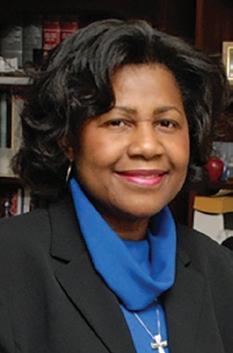
St. Louis Comptroller Darlene Green, in partnership with the National Association of Black Accountants Inc., and St. Louis Community College, is sponsoring free 2020 income tax return preparations for low-to-moderate wage earners, senior citizens and individuals with disabilities. Due to the coronavirus pandemic, the accountants group will be preparing tax returns virtually. Interested taxpayers are asked to schedule an appointment and the tax session will be held by a ZOOM conference. The free services will be offered from 4:00 to 7:00 pm on Feb. 17 and 24, and March 3, 10 and 17. To schedule an appointment, taxpayers should visit nabavitastl.org and complete the form. For more information, call 314-657-3435.
University City announces $700,000 in forgivable loan programs
University City has announced a fourth forgivable loan — small business assistance program to help provide relief for local businesses that have experienced economic hardship as a result of the COVID-19 pandemic. Eligible local retail, service and creative for-profit businesses can use the money for short term financial operation needs such as payroll and utilities or for payments to suppliers or service providers.
The loan fund may not be used for capital expenditures or rent. In addition, although businesses that received funding less than $2,000 in Rounds 1 or 2 are eligible to receive Round 4 funding up to $2,000 minus funds already received, other businesses that received funding in a previous round of the program are not eligible to receive funding in Round 4. Money for University City’s Forgivable Loan Small Business Program comes from a special quarter-cent, economic development retail sales tax the city has assessed since August 2006, which is invested in projects that encourage redevelopment. Applications will be accepted until April 30. Interested businesses should contact Clifford Cross, director of planning and development, 314-505-8516, or email ccross@ucitymo.org or Jenny Wendt, jwendt@ucitymo.org. Applications may be made at https://www.ucitymo.org/673/ Economic-Development-retailSales-Tax.com
SLU receives $500,000 grant for early-career, female professor
St. Louis University has received a $500,000 grant from the Clare Boothe Luce program of the Henry Luce Foundation to create a tenure-track assistant professor position in robotics and autonomous systems for an early-career, female faculty member in Parks College of Engineering, Aviation and Technology. The faculty member will join SLU in the fall of 2021.
The professorship will be for five years, with SLU fully funding the position thereafter. The grant allows for professional development funds to be provided for expenses such as training, additional research support, travel or child care.
Program supports supporting diverse founders
Black PR Wire
NEW YORK — Morgan Stanley today announced the fifth cohort of the Multicultural Innovation Lab, an accelerator program for technology and technology-enabled start-ups in the post-seed to Series B funding rounds. The program, now in its fifth year and with 43 total participating companies, targets start-ups with a multicultural or woman founder, co-founder, CTO or other C-suite member that is developing innovative solutions across sectors. Following four successful years that resulted in company acquisitions and additional funding rounds, the Lab is expanding in 2021 to support twice as many companies — up to 20 annually, split into two cohorts. Through the Lab, Morgan
Stanley will make investments in these early-stage high growth companies and will support each founder’s growth and development through its ecosystem of internal and external partners.
“Our survey found that during 2020, progress was made in venture capitalists’ attitudes and actions regarding the importance of investing in women and multicultural entrepreneurs, but a lot more needs to be done to close the funding gap for this group,” said Carla Harris, vice chairman of Morgan Stanley and head of the Multicultural Client Strategy Group.
“The goal of the Multicultural Innovation Lab is to provide diverse founders with much-needed access to investors — along with the tools, resources and connec-
them know first that we care.”
Continued from C1
the blow of the 2009 economic downturn. As a Black businesses owner, she didn’t have such support when she started. That’s why she wants to help other entrepreneurs of color.
“I know what they are going through,” Jones said. “Being an entrepreneur is a lonely existence on a lot of levels. There are not enough of us in a group that’s going to help. So what we try to do is we try to let
Habitat for Neighborhood Business is looking for more business owners to serve as mentors.
The nonprofit helps entrepreneurs of color secure grants and other financial assistance and helps them shift their businesses to online business models.
Jones said that turned an event planner’s business around after the company’s events were canceled.
“It’s not over yet,” Jones recalled telling the owner.
“Let’s think about this. People are using Zoom. They need backdrops. They need setups.
tions they need to grow and thrive — in order to transform the investing landscape.”
The Lab is designed to help drive positive economic outcomes for entrepreneurs of color and women by providing content, visibility, technical support and connectivity with important stakeholders who might be essential in accelerating the growth of their businesses, as well as access to an ecosystem of best-in-class global partners providing a variety of resources.
“We are excited to kick off the first cohort of 2021 to support talented, diverse entrepreneurs on their journey to success,” said Alice Vilma, managing director and co-head of the Multicultural Innovation Lab. “
The curated curriculum will introduce proven tactics to grow and scale each company’s business and, as with the previous cohort, will be sure to address COVID- related management and operational decisions that founders are facing
There are other industries that need your services. What you do and how you do it, we just have to think outside of that box.”
Part of the nonprofit’s approach is making sure the entrepreneurs it works with support each other.
“We took one caterer and two restaurants and provided meals for our business owners,” Jones said. “We provided them with tickets so that they can get help from that.”
Christian-Wilson said having people in her corner during the pandemic has kept her spirits up.










during this difficult time.”
The companies participating in the program, selected out of a record of over 700 applications received, began the program on Feb. 16 and will operate in a virtual environment, using online video platforms to facilitate the Lab curriculum.
The entrepreneurs receive support from a dedicated Morgan Stanley team delivering tailored experiences to help each company grow.
The program will run through July, culminating in the fifth Multicultural Innovation Lab Showcase and Demo Day that will present the companies to potential investors.
The companies that have been selected for the winter 2021 cohort include the following:
• ABF Creative is a B2C podcast network that produces original and multicultural focused podcasts for diverse audiences.
• Abode Technologies is a nationwide real estate platform that allows property sellers to
“They don’t leave you hanging,” she said. “They’re vested in you succeeding. And they really from their heart want you to succeed. Some people get these programs, but it’s a job for them. ‘Well, OK, you didn’t qualify. Sorry, check next time.’ No. They’re attached to the outcome of your success, and they show it.”
Christian-Wilson has been an entrepreneur for more than two decades. In that time, she’s experienced a recession and now a pandemic. Despite the obstacles she’s faced, she’s optimistic her business will bounce back.
easily list, market and sell their homes at a flat fee.
• Cognitive ToyBox is an early childhood learning assessment platform that combines inperson observation with research-driven game-based assessments to evaluate students for kindergarten readiness and support early childhood development.
• Elly Health is a digital health care app which helps chronically ill patients manage their illness and improve their quality of life with motivational messages, exercise videos, meditation practices, symptom management, clinician classes and patient stories.
• Fashion Bomb Daily Shop is a fashion marketplace that sells pieces designed by multicultural designers to multicultural customers.
• Kanarys is a Diversity, Equity and Inclusion focused SaaS platform that delivers companies clear metrics to diagnose, prioritize and optimize DEI efforts.
• Lillii RNB is a boutique IT
“I was able to persevere due to the loyal St. Louis customer base that I have aligned myself with and call my customer friends,” Christian-Wilson said. “They’re very supportive. They’re very loyal, and they want to see us succeed. They want to see us make it.”
Jones understands the stress firsthand. She owned a real estate company for 26 years and felt the blow of the 2009 economic downturn. As a Black businesses owner, she didn’t have such support when she started. That’s why she wants to help other entrepreneurs of color.
consultancy whose signature software product “Freeing Returns” enables retailers to seamlessly integrate their pointof-sale systems with return management applications, saving both time and money.
• Second Keys is a property management platform that enables property managers and tenants to seamlessly facilitate rent payments, track maintenance requests, and communicate real time, in order to keep tenants happy and save costs.
• Support Pay is a payment platform that enables parents who live apart to manage child support and share expenses directly with each other.
• Virtual i Technologies is a risk underwriting analytics platform that allows insurers and brokers to have real-time visual data and professional assessment on inspection properties without having to travel.
“I know what they are going through,” Jones said. “Being an entrepreneur is a lonely existence on a lot of levels. There are not enough of us in a group that’s going to help. So what we try to do is we try to let them know first that we care.” Habitat for Neighborhood Business is looking for more business owners to serve as mentors.
Marissanne Lewis-Thompson is a reporter for St. Louis Public Radio, a media partner of The St. Louis

After nearly a year of a devastating pandemic, hope and optimism are growing as the COVID-19 vaccines become available to more and more people.
While many people welcome the arrival of the vaccine as the beginning of the end of COVID-19, others remain uncertain or uneasy. BJC HealthCare, Mercy, SSM Health and St. Luke’s Hospital want to ensure that everyone in the St. Louis metro area and beyond has access to the most up-to-date vaccine information to make informed decisions about their own health.
Even though the science tells us the vaccines are safe and effective and side effects overall have been minor — some of our own Health Care Heroes also have struggled with questions about the vaccines. In the end, they made their own decision about vaccination based on what they believe is best for themselves, their loved ones and their communities.
Here, those Health Care Heroes — who have worked tirelessly caring for others throughout the pandemic — share their personal stories of choosing to get the vaccine. They hope their words will inform, educate and inspire others as they make their decision about COVID-19 vaccination.
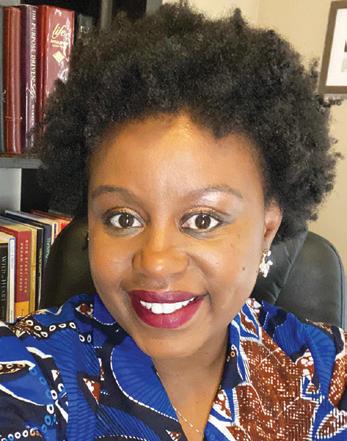
Matifadza Hlatshwayo Davis, MD, MPH Washington University Infectious Diseases Physician at Barnes-Jewish Hospital and the John Cochran VA Medical Center
Member of the St. Louis City Board of Health
“I am a physician, and my area of specialty is infectious diseases. Today, I am fully vaccinated. I say that with the understanding this is a difficult topic for many in the Black and brown communities, who have a lot of mistrust about getting a vaccine and even accessing care. We have to be honest about why that is.
And that is because of years and years, dating back to slavery in the Black community, when we were treated unfairly. In the cases of Henrietta Lacks or the Tuskegee experiments, there were clear and documented cases of abuse, and this has resulted in mistrust that is valid and understandable.
So I don’t say you shouldn’t feel this way. I humbly say I completely understand. But I trust the science, and come to you today as a scientist, as a person who has dedicated her life to medicine and to public health, who is deeply passionate about Black and brown communities, the communities that have raised me and supported me.
We are getting the coronavirus at rates much higher than other groups and are dying at rates much higher than other groups. We need to look at the science. I have been looking at the science since the beginning.
I know some people have found it very worrisome that the vaccine came out so quickly, but the coronavirus comes from a family we had studied for many years. And all governments across the world, academic institutions, research institutions and pharmaceutical companies stopped what they were doing to literally focus on this virus and vaccines to answer it. We have clinical trials that have sound data, data that have been reviewed by diverse external review boards, that show this is highly efficacious and safe.
For myself and my family, I considered the risk or benefit of me taking the vaccine, versus the risk or benefit of me getting coronavirus and possibly dying from it. It is clear to me that the vaccine is one of the most important tools in our toolbox.
This has been an incredibly difficult year. I am exhausted, this work has been hard, losing people along the way has been taxing. But as a person who has received the vaccine, I have hope and incredible gratitude for the science that has brought us here.
This is a time to consider this vaccine because it is literally a matter of life or death.”

Damian Findlay, DMD, MD, FACS Division Chief
of Oral and Maxillofacial Surgery at Mercy Hospital St. Louis
“Like many health care workers, I have both treated COVID-19 patients and battled it myself. It was beyond the sickest I have ever been and I don’t wish it upon anyone. The pandemic has altered our way of living and has had severe psychological implications. Now, with vaccination, we have a chance to emerge from the pandemic.
As a graduate of Tuskegee University, I worked as a research assistant and met survivors of the Tuskegee Syphilis Study and their family members. They were extremely vocal about their hesitation to participate in any type of research because they felt betrayed by the scientific community. That study, along with many other heinous and unethical occurrences throughout history, has led many to mistrust our health care system.
As someone who shares the same skin color as the participants in the Tuskegee Syphilis Study, I understand their position. In fact, people of all races and ethnicities are skeptical of the COVID-19 vaccine. Though, with my scientific background, I’m a vaccine advocate and did choose to be vaccinated.
Over the last 200 years, some of the most brilliant scientists contributed to vaccine medicine. From the small pox era to the flu, groundbreaking advancements in vaccine development continue daily. My decision was based on the literature full of evidence showing the vaccines’ effectiveness and safety.
For those with trepidation, I ask you to be cautious of conspiracy theories and opinions on social media platforms. I implore you to speak with your physician and look to evidence-based platforms (CDC, NIH, state/local health departments) to educate yourself.
I am one month out from having received my second dose. I see vaccination as a selfless act we can do for each other to prevent the spread of the virus. As Americans, we are an amalgamation of people of different races, ethnicities, religions, political ideologies and cultures. This is what makes America wonderful. Despite our differences, we all have a common enemy in COVID-19. I ask you to strongly consider vaccination because our most valuable capital is at stake — our human capital. Not knowing our worth as a people could be the greatest price we ever pay.”

Beverly Stith Chaplain at SSM Health St. Joseph Hospital - St. Charles
“At first, I was skeptical about getting the COVID-19 vaccine. I had reservations because it had been developed so quickly. My mind was not settled when it was first offered to me, so I declined. I began researching it for myself, which caused me to alter my way of thinking. I asked my colleagues who had been vaccinated about their experiences. My husband and I had spirited conversations on the issue. He was ready to get it immediately, whereas I wasn’t quite there yet. This pandemic has brought me to the realization that either we trust God, or we don’t. People often ask me how I’ve come to trust God. I go by what He’s done for me. He’s never failed me, never let me down. Every morning before work I read Psalm 91, which reminds me that even when things aren’t going my way, He will never forsake me. God, who created heaven and earth, is certainly capable of taking care of us.
After a period of deep prayer, I decided to get the vaccine. I’m normally fearful of shots, but my nurse made me feel comfortable and at ease. I was at peace because I believe in scripture and concluded it was the right thing to do.
We must have the courage to face our challenges in proactive ways. While the vaccine does not negate the need to continue social distancing or practice good hand hygiene, it’s a preventative measure to help curb a pandemic that has wrought unspeakable death and despair.
Yet, the pandemic has also given us a new appreciation for our families, our health care workers who put their lives on the line every day, and the little things in life we may have previously taken for granted. We may never completely return to the way things were, but together we can help restore economic prosperity to minority communities across the St. Louis region simply by doing our part to keep each other safe and healthy.”
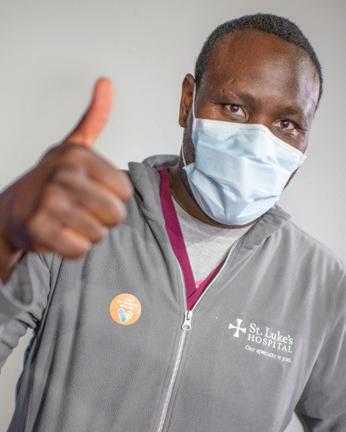
Shawn Rodgers Patient Care Technician in the Cardiovascular Intensive Care Unit at St. Luke’s Hospital
“In my role, I have seen firsthand the devastating impact of COVID-19. I have watched even the most healthy, young individuals have their bodies damaged by COVID-19. It’s heartbreaking.
Yet, my decision to get vaccinated was not a simple one.
I had some hesitations at first, and you may, too. I had concerns about the timeline of the vaccine development and the inclusion of minorities in the vaccine trials. After talking with colleagues and other medical professionals I trust, I learned how mRNA works and about the rigorous safety and testing protocols followed throughout the vaccine process. I also discovered that minorities accounted for more than one-third of trial participants in the Moderna and Pfizer trials, according to each developer’s results.
There’s a lot of misinformation out there about the vaccine. If you’re struggling with your decision once you become eligible, I encourage you to:
• Have one-on-one conversations with people working in health care who see firsthand the destruction of the disease and its impact on patients and their families.
Hear personal experiences from those who have recovered from the disease who can shed light on how it can affect you.
• Keep doing your research. Use credible sources such as the Centers for Disease Control and Prevention (CDC) and the Food and Drug Administration (FDA), and talk with your health care provider.
Pray about it. I believe in a higher power, and if you are also someone who is guided by faith, pray about it.
This disease has taken us all by storm, especially in the minority community where death rates are disproportionately larger. After considering all of the information available, why would I take a chance and not receive the vaccine? I did it for my family, for my love of my neighborhood and for the community.
Let’s do all we can to help each other. We’re all in this together.”
The Urban League of Metropolitan St. Louis, Inc is partnering with the State of Missouri and the Missouri National Guard to get COVID-19 vaccinations to senior citizens in areas of the city most impacted by coronavirus. Senior citizen facilities where the Urban League is currently providing Food, Masks, Gloves, PPE, and other senior programs, were selected for the first round of vaccinations. The first vaccine event was held at the Macler Shepard Senior Apartments. Staff in the buildings worked to identify residents who met the prioritized criteria and are currently on a waiting list. The Guard set up the vaccination stations, administered the vaccines and provided staff to help monitor seniors after their initial dose. The Urban League and the Guard will provide those receiving the first dose with a second dose in 28 days. Additional vaccine clinics will be continued through March.
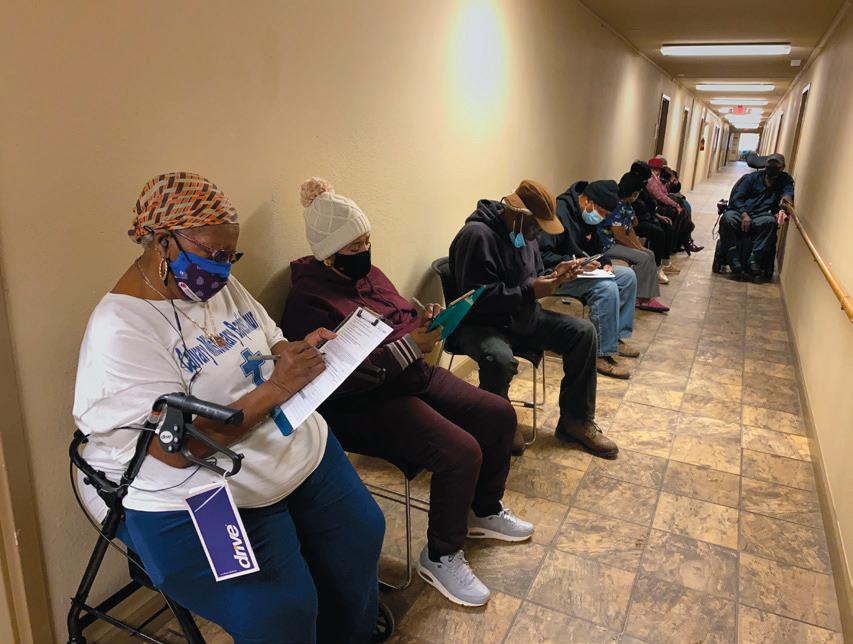

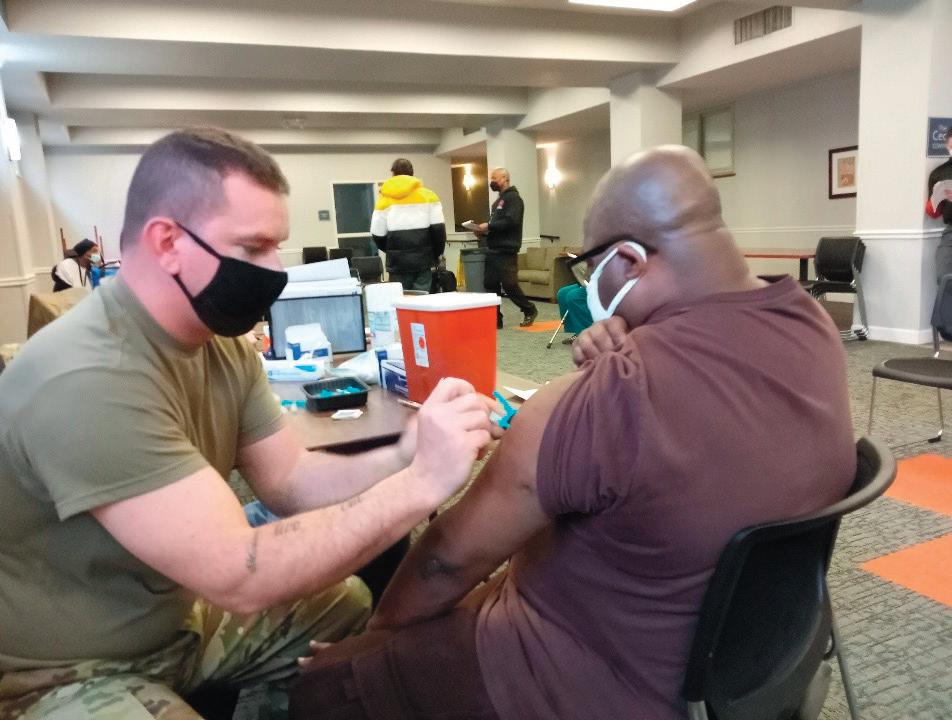
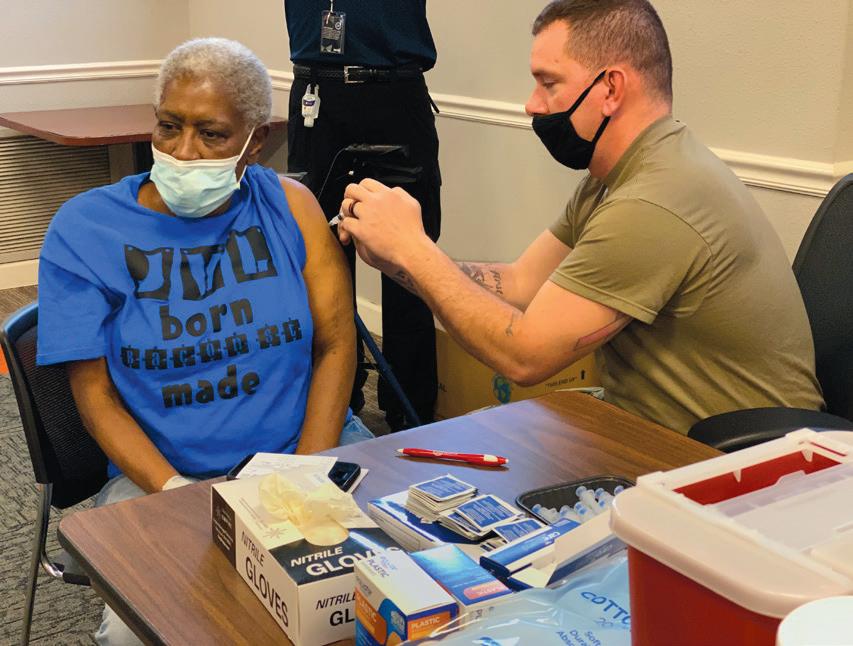





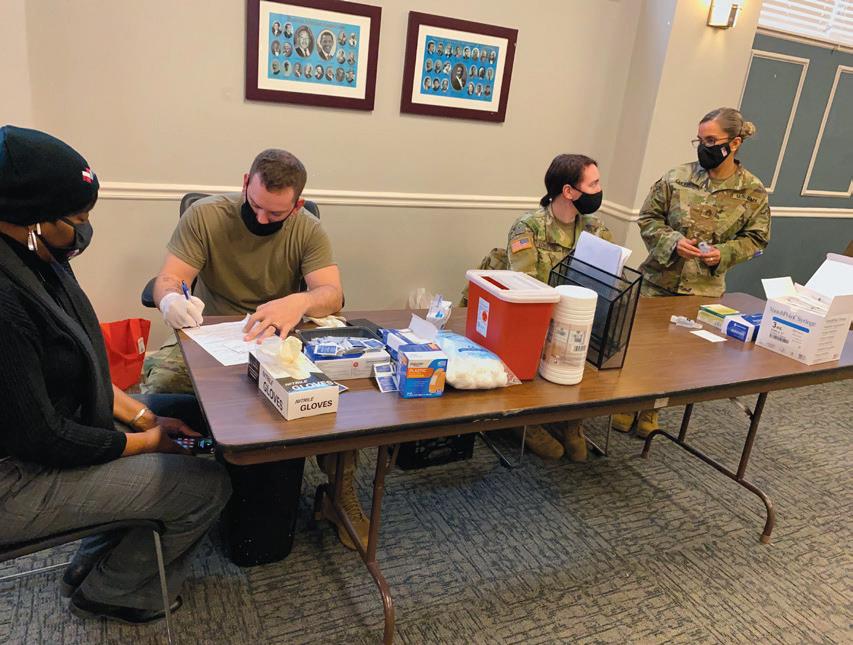
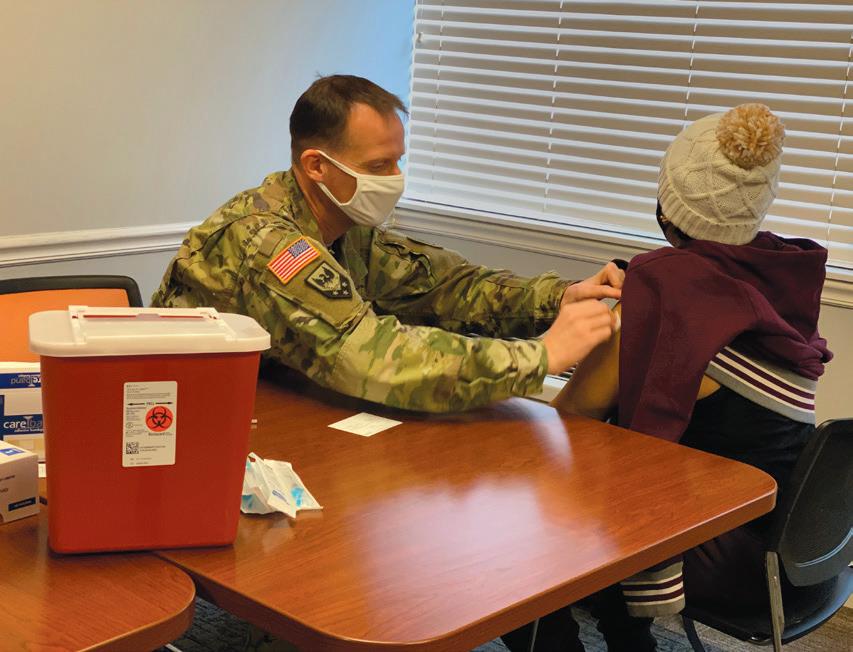


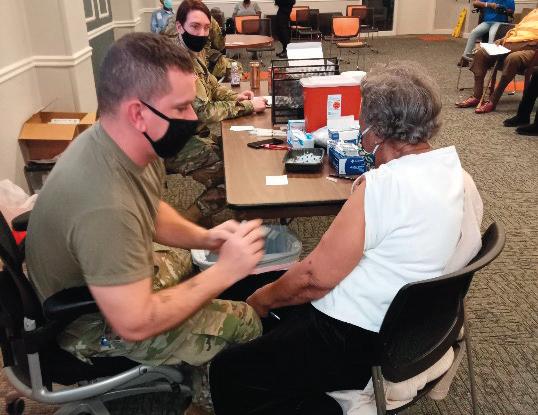
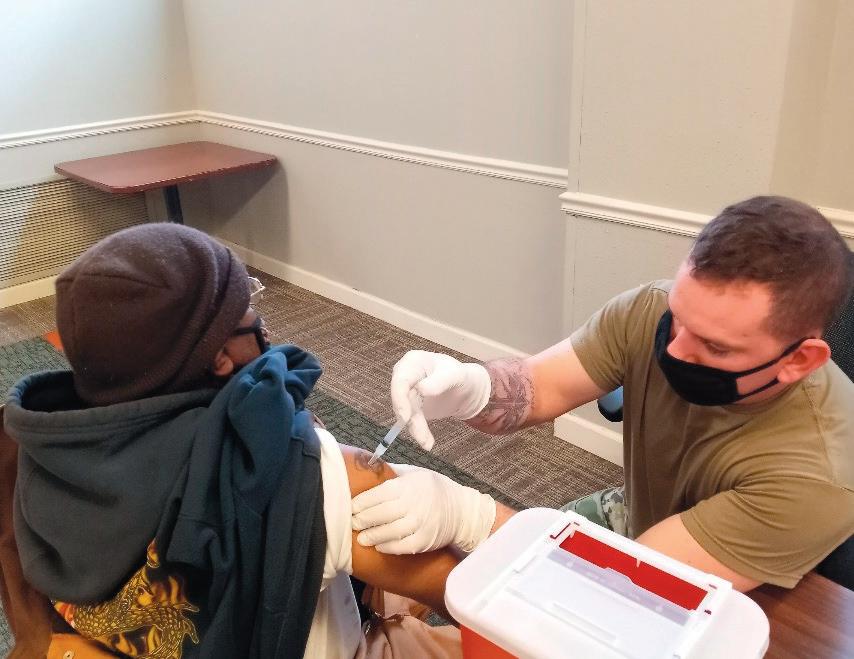
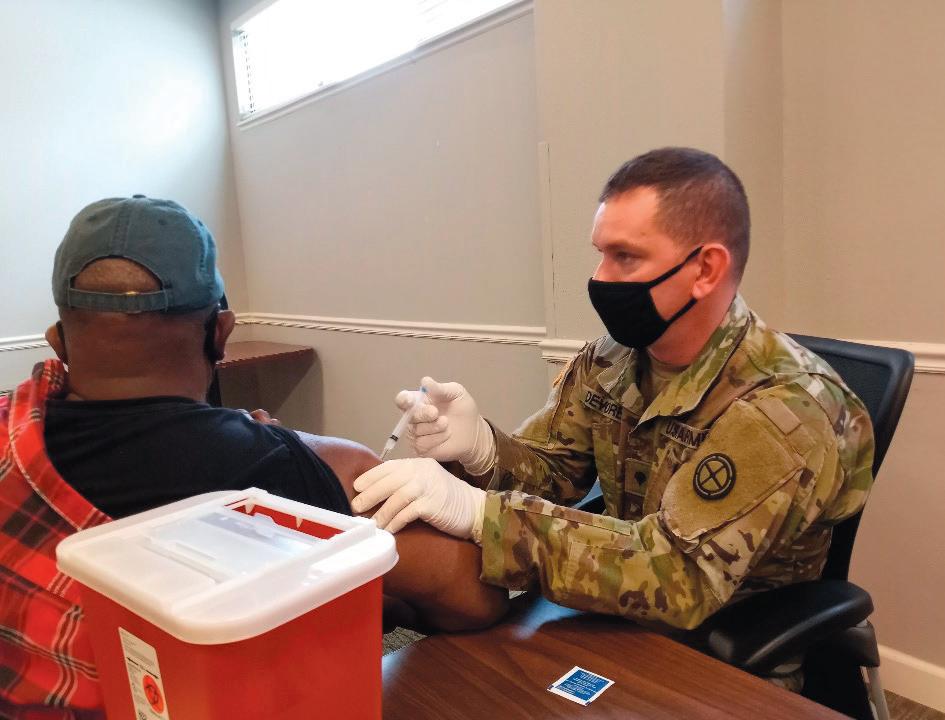


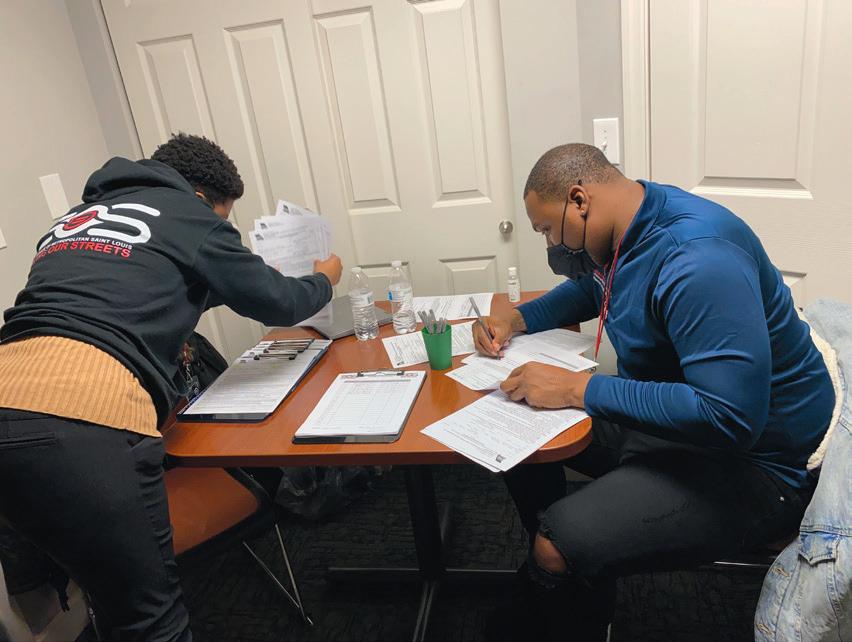
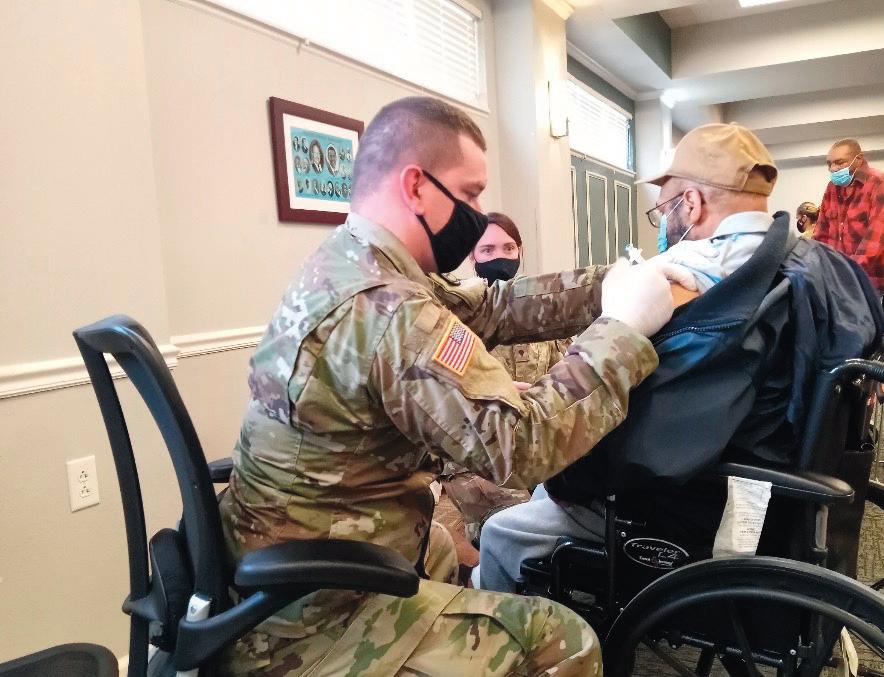
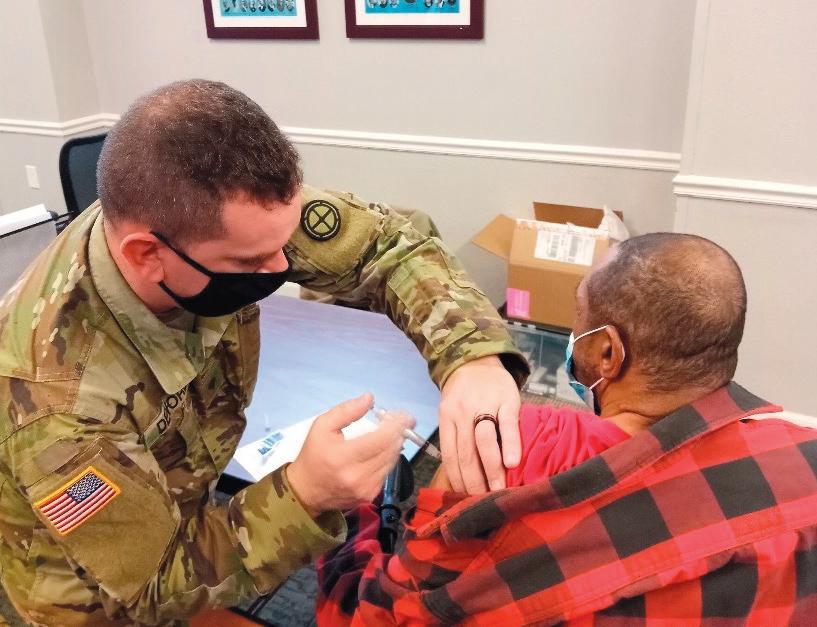
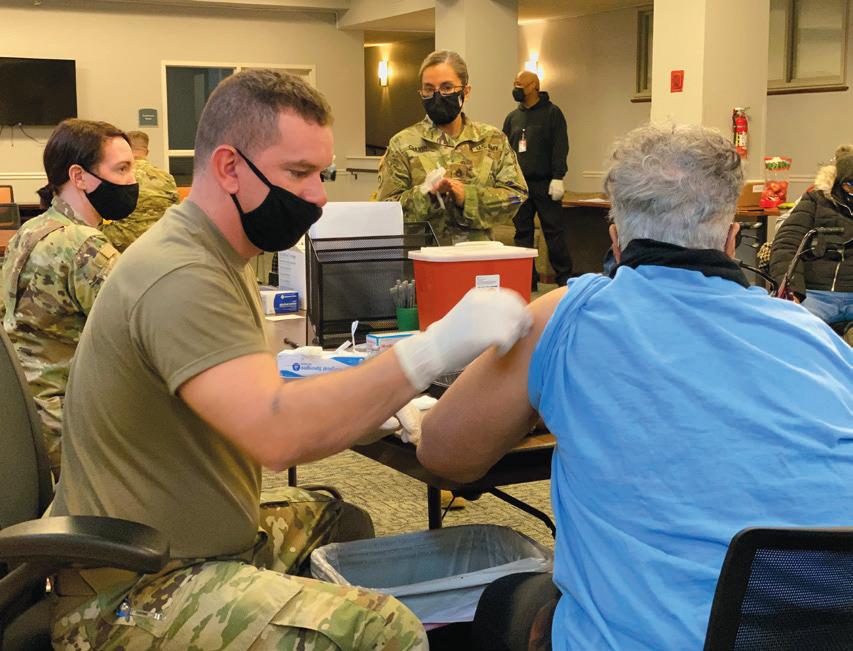
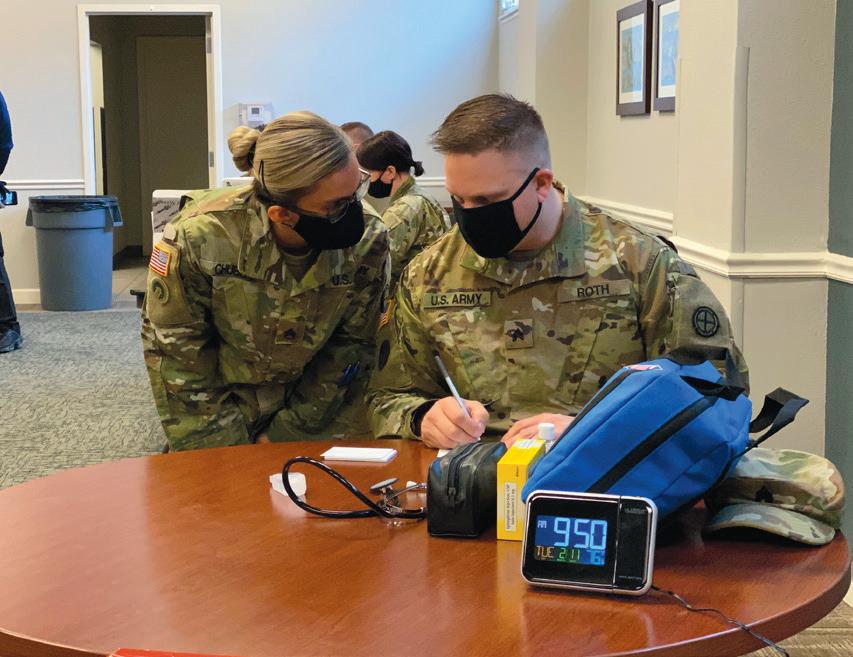
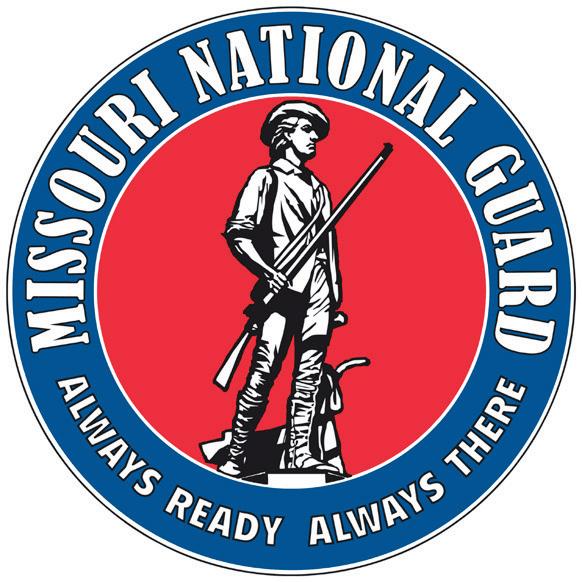


By Sandra Jordan
Of The St. Louis American
With over 280,000 on its waiting list at the end of last week, COVID vaccine availability to meet the demand continues to be an issue in the St. Louis area, however, St. Louis County announced more doses are coming from the state.
“We are pleased now to have a commitment from the state to provide St. Louis County with 3,000 doses per week of vaccine, and we’ll be getting our next shipment of vaccine to St. Louis County Dept. of Public Health on Tuesday,” County Executive Sam Page said during a media briefing held at a fire station in Affton, which is one of five vaccine locations set up in the county.
“This gives us the assurance we need to keep vaccinating folks in St. Louis County, along with our partners,” Page said. “In St. Louis County, our department has vaccinated 11,000 of our residents and those who work in St. Louis County, and we have given 1,100 second doses of the vaccine.”
Groups currently receiving the vaccine are 1A and 1B, tiers 1 and 2.
“When more vaccine is available, we will be able to open more sites and get even more vaccine into arms,” Page said.
The county’s health department is partnering with area fire districts in Eureka, Pattonville, Mehlville, Affton, and Richmond Heights, and with the St. Louis County Police Department Office of Emergency Management to administer the COVID-19 vaccine to about 1,000 residents and staff in group homes and other housing facilities that have not yet received vaccinations.
Missouri says more vaccine is on its way
The state of Missouri promised more doses of COVID-19 vaccine in the weeks ahead during a virtual chat with reporters on Wednesday. Moderna is expected to supply an additional 60,000 doses of its vaccine.
Dr. Randall Williams, director of Missouri Dept. Health and Senior Services, Adam Crumbliss, director of Community and Public Health at DSSS, along with Robert Knodell, deputy chief of staff for Gov. Mike Parson, addressed media questions emailed in advance or submitted via chat during the session on Feb. 10.
At age 30, professional dancer and former Black Jack resident Megan Corbin had a heart attack in 2020. Corbin said had she known that women tend to feel a heart attack in their chest and back rather than their heart, and that nausea, diarrhea, numbness, cold sweats, difficulty breathing are all signs of a heart attack, she would have gone to the hospital sooner.

Residents
In response to the criticism that the state has been getting vaccine out to the rural areas rather than the urban areas, where the state’s largest populations have been hardest hit by illness and deaths from COVID-19, they said rural areas have a lot of elderly, and urban top 50 hospital systems got the bulk of earlier vaccine supply (which went to health care workers, not other vulnerable populations). Urban hospitals also
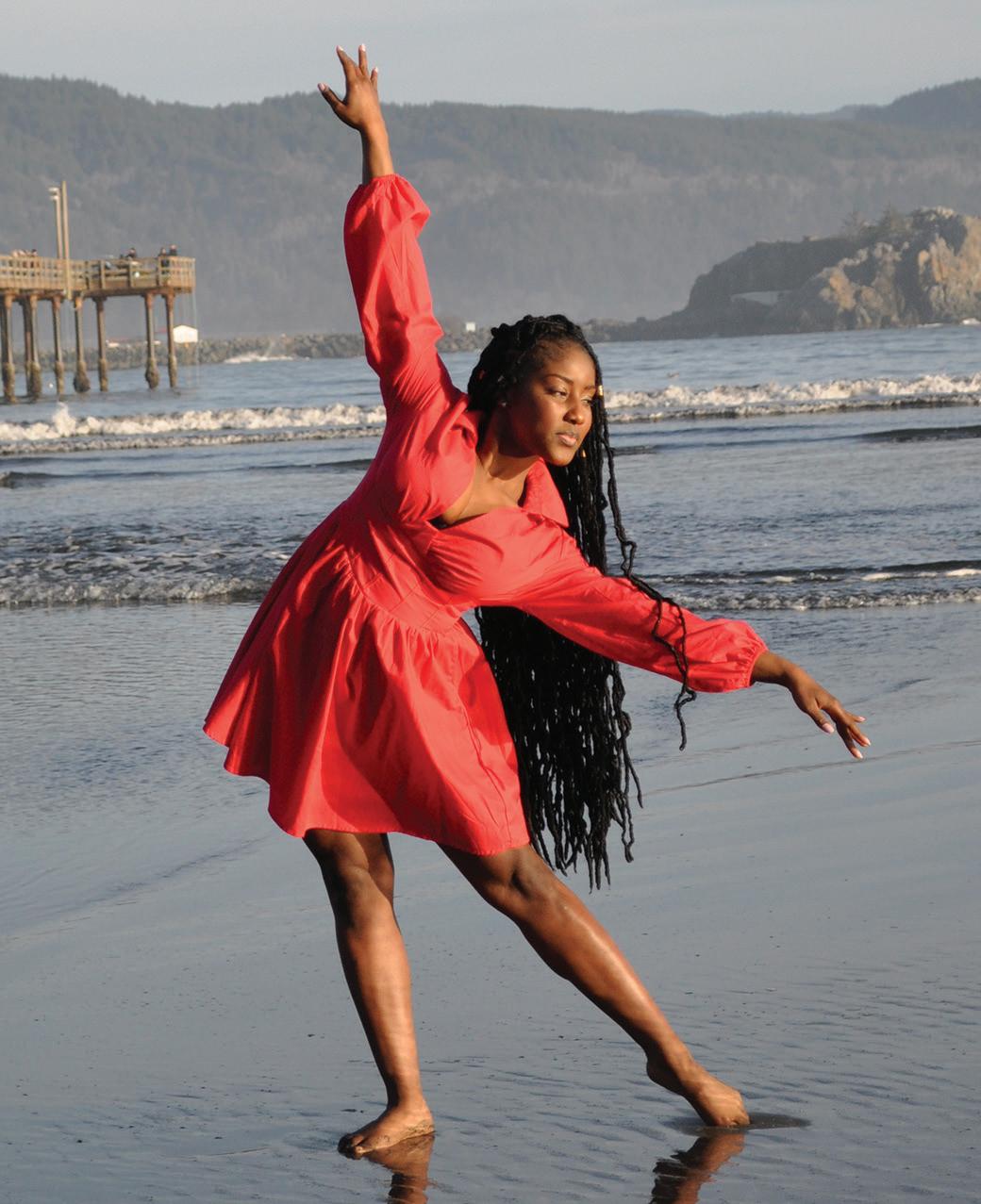
have been taking care of rural COVID-19 patients during the pandemic.
Knodell said COVID vaccines from the feds will go to retail pharmacy chains, including Walmart and Healthmart, beginning Feb. 12 and other chains will be added.

Here’s what you need to now
By Michelle Andrews Kaiser Health News
For people who’ve been without health insurance during the coronavirus pandemic, relief is in sight.
In January, President Joe Biden signed an executive order to open up the federal health insurance marketplace for three months so uninsured people can buy a plan and those who want to change their marketplace coverage can do so.
Consumer advocates applauded the directive. Since 2016, the number of Americans without health insurance has been on the rise, reaching 30 million in 2019. The economic upheaval caused by the coronavirus has made a bad situation worse, throwing millions off their insurance plans.
The move is in stark contrast to the Trump administration’s approach. As COVID-19 took hold last spring and the economy imploded, health experts pleaded with the Trump administration to open up the federal marketplace so people could buy insurance to protect themselves during the worst public health emergency in a century. The administration declined, noting that people who suddenly found themselves without coverage because they lost their jobs were able to sign up on the marketplace under ordinary rules. They also cited concerns that sick people who had resisted buying insurance before would buy coverage and drive up premiums. The Biden administration is promising to

By Sandra Jordan Of The St. Louis American
Megan Corbin has everything going right in her life and her career as a professional dancer. Getting her start at Dance Plus studio, the Hazelwood Central High School graduate went on to college to study dance and performed on stages from one coast to the other. Now living in northern California, Corbin said she always wanted to open a dance school. And 2020 turned out to be the year she would do it, despite the COVID-19 pandemic and despite having a heart attack in July, just a few months after her 30th birthday.
Corbin said she actually had been feeling pressure in her chest for about a month. She had been doing live workouts on Facebook every day. One morning, everything changed.
“Eight o’clock in the morning, I had a heavy feeling in my chest like it was just pain – front and back. I tried to deal with it on my own for
about 10 to 15 minutes, and then I finally woke my husband up,” Corbin said. “He carried me to the bathroom, and I thought that I had to vomit … and I was having cold sweats, so I literally laid across the bathroom floor, because I was cold, but I was hot, and the floor was cool. Me, I kept saying, maybe ‘I need a ginger ale,’ because it felt like gas.”
She said it felt like very intense gas, right in the chest area.
“It was when I told him my arm was numb and I could not feel my arm, he said, ‘You have to go to the hospital,’” Corbin said.
Her husband drove her to a nearby medical facility. Due to COVID restrictions he could not go in with her at first. After an EKG confirmed she was having a heart attack, her husband was allowed to be with her for a short time, before
See Heart, A15
By Kayla Drake St. Louis Public Radio
Nearly every year, someone in St. Louis dies from the cold, local providers of homeless services say. The coronavirus pandemic has made the issue more dire this winter. Social distancing measures have reduced capacity at area homeless shelters, and the economic crisis has put more people at risk for homelessness.
Propelled by the freezing weather this month, a group of St. Louis nonprofits worked together to make additional room for around 250 people in the past two weeks by extending shelter hours and paying for people to stay in motel rooms.
“I’ve never seen a coalition come together like this before,” said Teka Childress, a longtime homeless advocate and founder of St. Louis Winter Outreach.
Downtown temporary shelter
St. Patrick Center, Horizon North Housing and Tent Mission STL also helped open a 24-hour shelter downtown in the St. Patrick Center’s staff lounge and shuttered cafe on Feb. 7.
Continued from A14
Corbin was airlifted to a hospital in Medford, Oregon where cardiac specialists could immediately provide the lifesaving care she needed.
“The team was waiting for me outside the hospital. They put a beta blocker in to open up the blood clot in my artery, and they said the blood was actually not flowing to my heart,”
Continued from A14
spend $50 million on outreach and education to get the word out about the new special enrollment period. That’s critical, experts said. Although the number of people signing up for Affordable Care Act plans has generally remained robust, the number of new consumers enrolling in the federal marketplace has dropped every year since 2016, according to KFF, corresponding to funding cuts in marketing and outreach. (KHN is an editorially independent program of KFF.)
“There are a lot of uninsured people who even before COVID were eligible for either hefty marketplace subsidies or for Medicaid and not aware of
Continued from A14
FQHCs are expecting more vaccine Knodell said federallyqualified health centers across the state are reportedly getting more COVID vaccine shipments from the federal government, although the quantity and
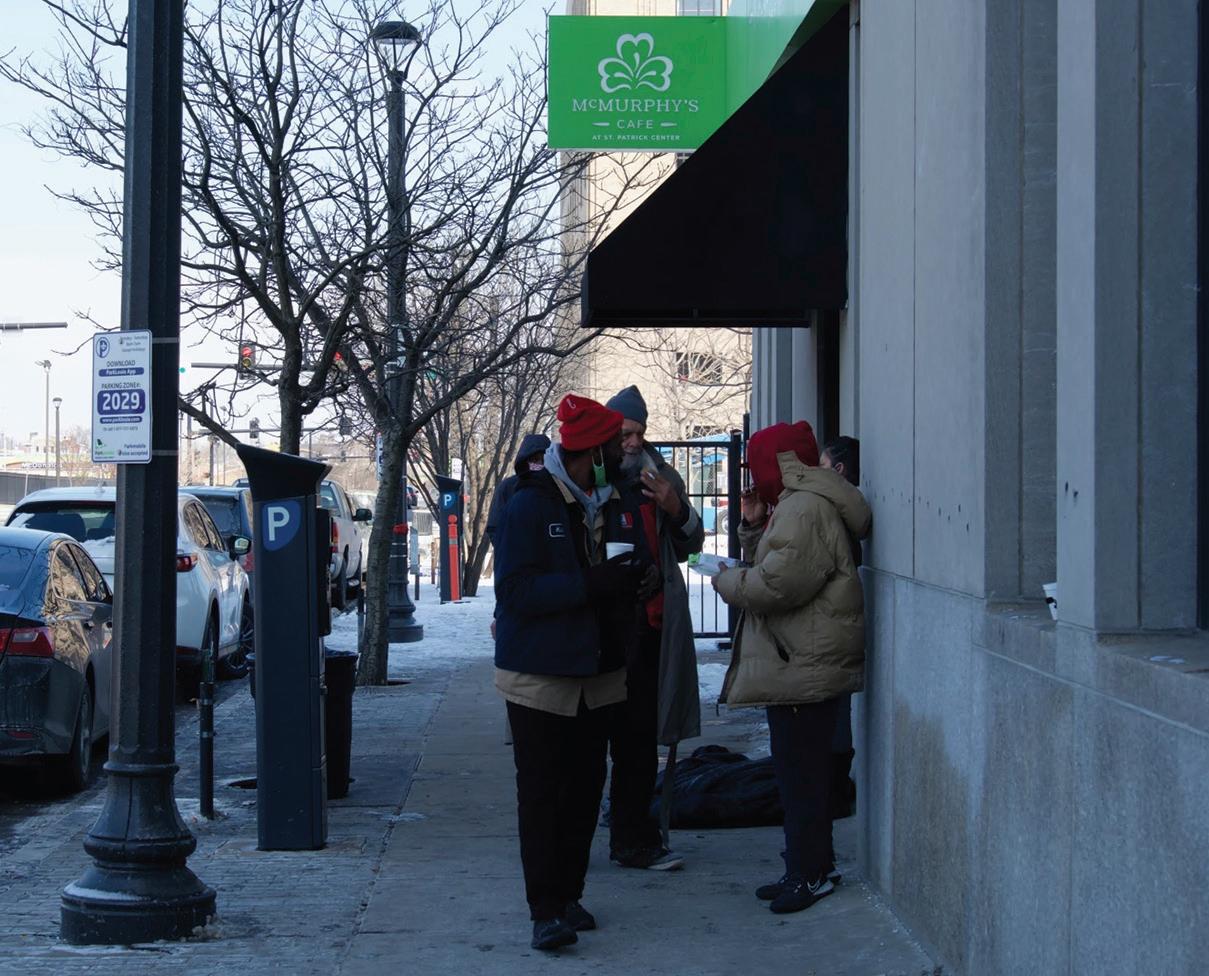
The temporary shelter is referred to as a safe haven site because it doesn’t have any requirements and accepts anyone. Many shelters have curfews, limit entrance to certain genders or restrict people from
Corbin said. The health care team at both facilities were amazed that this young woman who by appearance was the healthy picture of youth was anything but.
The doctor explained to her that they needed to put a stent in the artery. Corbin said, “Once he got done, I said, ‘Well, I don’t plan on dying today, so let’s just do what we got to do.’”
Corbin was hospitalized for 10 days after her heart attack and surgical procedure.
The doctor told her she had
it,” said Sabrina Corlette, a research professor at Georgetown University’s Center on Health Insurance Reforms. Here are answers to questions about the new enrollment option.
Q: When can consumers sign up, and in which states?
The sign-up window will be open for three months, from Monday through May 15.
Uninsured residents of any of the 36 states that use the federal healthcare.gov platform can look for plans during that time and enroll. States and the District of Columbia that operate their own marketplaces are establishing special enrollment periods similar to the new federal one, though they may have somewhat different time frames or eligibility rules. In Massachusetts, for example, the sign-up window remains open until May 23, while in Connecticut,
locations were not yet known.
“They will be sending a dedicated allocation to FQHCs across the state to reach vulnerable populations and medically underserved communities and regions,” Knodell said. “That will interface a little bit with our state allocation to FQHCs.”
Betty Jean Kerr People’s Health Centers reports it was able to vaccinate its frontline healthcare workers after receiving its first shipment of COVID vaccine early last week. “We are prepared to begin providing
staying if they have substance abuse or behavioral issues. St. Louis hasn’t had a safe haven shelter since 2016. “It doesn’t matter what someone has done or what someone is doing,” the St. Patrick
“extremely high cholesterol and high blood pressure,” neither of which runs in her family.
“Had I known certain signs, such as 1) women tend to feel a heart attack in their chest and back rather than their heart, or 2) nausea, diarrhea, numbness, cold sweats, difficulty breathing (all symptoms that I felt) are all signs of a heart attack, I would’ve gone to the hospital sooner,” Corbin said.
The American Heart Association chose Corbin as one of its 2021 Real Women, to share her story and to encour-
it closes March 15. Q: Can people who lost their jobs and health insurance many months ago sign up during the new enrollment period?
Yes. The enrollment window is open to anyone who is uninsured and would normally be eligible to buy coverage on the exchange (people who are serving prison or jail terms and those who are in the country without legal permission aren’t allowed to enroll).
People with incomes up to 400% of the federal poverty level (about $51,500 for one person or $106,000 for a family of four) are eligible for premium tax credits that may substantially reduce their costs. Typically, people can buy a marketplace plan only during the annual open enrollment period in the fall or if a major life event gives them another opportunity to sign up, called a
vaccines to our broader underserved community, according to the state approved eligibility standards, next week as soon as we receive additional promised doses,” People’s CEO Dwayne Butler said.
National Guard vaccinates seniors in the St. Louis area
Retired healthcare workers, medical students and the National Guard have been de-
Center’s Anthony D’Agostino said. “They’re a human being, they have dignity, and they don’t deserve to be on the streets when it’s negative zero temperatures.” People without housing are
age and empower women to become more aware about heart disease in women.
“I’m extremely excited and beyond grateful to be a 2021 Real Woman with the American Heart Association. Before working with them, I had no idea of the risks of heart disease and stroke amongst women; especially women of color,” Corbin said. “One-inthree women will die from heart disease and one woman is killed every 80 seconds. Unfortunately, too many of us don’t know what to look for.
special enrollment period. Losing job-based health coverage is one event that creates a special sign-up opportunity; so is getting married or having a baby. But usually people must sign up with the marketplace within 60 days of the event.With the new special enrollment period, how long someone has been uninsured isn’t relevant, nor do people have to provide documentation that they’ve lost job-based coverage.
Q: What about people who are already enrolled in a marketplace plan? Can they switch their coverage during this new enrollment period? Yes, as long as their coverage is through the federal marketplace. If, for example, someone is enrolled in a gold plan now but wants to switch to a cheaper bronze plan with a higher deductible, that’s allowed. As mentioned above,
ployed by the state to administer COVID vaccines to individuals.
On Thursday, National Guard members vaccinated senior citizens at four centers identified by the Urban League of Metropolitan St. Louis.
“The Urban League was recruited by the Governor’s office to partner with the Missouri National Guard to deliver COVID-19 vaccinations in areas in St. Louis that have had disproportionate impact and populations that are most vulnerable,” Patricia Washington, V.P. of
People staying at the downtown shelter in St. Patrick Center take a smoke break on Friday morning.
three times as likely to have a chronic illness, D’Agostino said, which can make them more susceptible to developing a serious case of COVID-19, should they contract the virus. Horizon North Housing, St. Patrick Center, Tent Mission STL and many volunteers got the safe haven shelter running in three days. It can accommodate 28 people during the day and sleep 20 at night. D’Agostino estimated the safe haven site will be open until next week, but said the timeline is flexible.
‘Safe haven’ from dangerous cold
The shelter also acts as a hub to connect people to housing services and gives out meals, bus tickets and lots of coffee.
Kevin Johnson said he appreciates the shelter being open. If it wasn’t, he said he might be
Knowing the signs and symptoms can make a huge difference.”
Corbin also wants women to focus on their health.
“I want women to start paying attention to their bodies, keep track of their numbers (blood pressure, blood sugar, cholesterol) and make better diet and lifestyle choices,” Corbin said. “Small steps like this today can save a life tomorrow.”
Corbin opened her dance studio three months after having her heart attack, surgery and
however, some state-operated marketplaces may not make that option available.
Q: Many people have lost significant income during the pandemic. How do they decide whether a marketplace plan with premium subsidies is a better buy for them than Medicaid? They don’t have to decide. During the application process, the marketplace asks people for income information. If their annual income is below the Medicaid threshold (for many adults in most states, 138% of the federal poverty level, or about $18,000 for an individual), they will be directed to that program for coverage. If people are eligible for Medicaid, they can’t get subsidized coverage on the exchange. People can sign up for Medicaid anytime; there’s no need to wait for an annual or special
Communications at ULSTL said. “We immediately identified four centers. The centers selected residents based on strict criteria including being over 65 and in the priority tiers. The National Guard provided staff to help set up the sites, deliver the vaccine and administer the shots. We have 500 initial doses of the Moderna vaccine. We will return to the centers in 28 days to give the second shot.”
St. Louis first
trying to keep warm near the steam vents outside the downtown Hilton hotel. Instead, he was at the shelter Friday morning helping volunteers by opening doors and carrying in supplies. Johnson has been living without stable housing for five years.
He’s seen firsthand that freezing weather can cause lifeor-death situations. Last winter, he saw someone sleeping outside near Union Station die in the cold.
“He laid down, I came back, and he was blue,” Johnson said. Any churches that typically open up to shelter people during the coldest stretches of winter have declined to do so this year because of the pandemic, said Tim Huffman, a St. Louis University professor who helped launch the temporary shelter.
The eventual goal is to open a permanent safe haven shelter that doesn’t have any barriers for people to stay at, D’Agostino and Huffman said. The City of St. Louis has converted the Cherokee and Tandy Recreation Centers into shelters as well. St. Louis County also opened a warming shelter that can take 20 people at the Salvation Army off Page Avenue near Overland, according to a county spokesperson.
going through cardiac rehab.
“All of my doctors know about the studio and that I’m dancing , and they’re happy for me,” Corbin said. “I think that things lined up the way they did for a reason, for me to be in the position that I am in now. Even though I had a heart attack, it was a blessing in disguise, because it actually pushed me to do what it is that I’ve always talked about. I realize you only get one life to live.”

enrollment period. Those already enrolled in a marketplace plan whose income changes should go back into the marketplace and update their income information as soon as possible.
Q: What about people who signed up under the federal COBRA law to continue their employer coverage after losing their job? Can they drop it and sign up for a marketplace plan?
Yes people in federal marketplace states can take that step, health experts say. Under COBRA, people can be required to pay the full amount of the premium plus a 2% administrative fee. Marketplace coverage is almost certainly cheaper. Michelle Andrews is reporter for Kaiser Health News, a media partner of The St. Louis American.
responders get second vaccine dose First responders in the city of St. Louis who received their first dose of the Pfizer vaccine three weeks ago received their second dose on Friday, Feb. 12. St. Louis residents are highly encouraged to sign up online at stlouis-mo.gov/covid-19/vaccine. If they do not have internet access, they should contact the Department of Health’s COVID-19 hotline at 314-657-1499.
Planting the Seeds for Success!
Am I Eating?

PRESENT:
A good healthy habit to start is to eat only when you’re hungry. While this might sound obvious, very few of us actually do it.
In our “Super-Size” world, we can easily lose track of what an actual serving size means. When reading labels on a food or drink product, you can determine the nutrients, sodium, fiber, sugar and calories of a serving size. But be careful; just because it looks like one small bottle


Keep an Eating Journal for a week to see when and why you ate. Was it because you were bored?
Did you eat when you were sad or upset? Or maybe you ate just because it’s what you always do.
(Perhaps you usually eat a snack when you sit down to watch a movie.)
of soda — it may not be considered one serving size. For example, a 20-oz bottle contains 2.5 servings. So if the bottle states “110 calories per serving,” that means the entire bottle contains a total of 275 calories! Remember to watch those serving sizes and you’ll have better control over what you’re eating and drinking.
Now try to make it a habit to wait until your stomach tells you that you’re hungry before you eat. You’ll eat a lot less junk food… and you’ll be healthier!
Learning Standards: HPE 2, HPE 4, HPE 5, NH 1, NH 2, NH 3, NH 5
Learning Standards: HPE 1, HPE 2, HPE 5, NH 1, NH 5
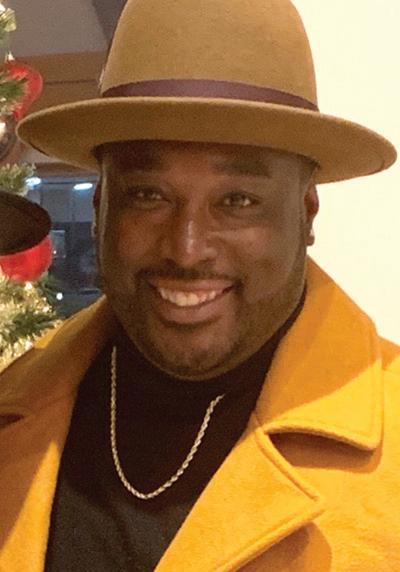
David Swingler, Ms
Deborah Edwards, School Nurse
Where do you work? I am a school nurse at Monroe Elementary School.
Where do you work? I am a PCAC Youth Service Director at the People’s Community Action Corporation.
It’s important that before you embark on any kind of exercise to remember two things: warm up and cool down. Start with some slow stretches and movement (like walking) to increase your heart rate a little. Warm up for a good five minutes before increasing your heart rate.
Walking is one of the best ways to stay active. Throughout the day you can look for ways to increase the amount of steps you take. You can walk around the living room while watching TV. You can take the
> NEVER walk on a “frozen” pond, lake, river or any other body of water. Just because it looks frozen does not mean it is safe.
While animals can be cute and furry, we should all be careful anytime we are around any kind of animal (especially if it isn’t your own pet). A dog you see while walking down the street might seem friendly, but if it doesn’t know you it could be afraid and jump up on you, or bite. When you see someone walking a dog,
> If you are with someone that falls through the ice, first run (or call) for help. Do not try to go out onto the ice to help your friend. You can fall through the ice too.
> When walking on icecovered roadways or sidewalks, take baby steps. Walk carefully and slowly.
stairs instead of an elevator, or maybe you can walk to a nearby store instead of riding in a car.
Secondly, when you are finished with any kind of strenuous (very active) exercise, take some time to cool down. You can slowly stretch your arms and
Some studies show that kids that take about 12,000 steps per day are healthier. Consider purchasing a pedometer. This small,
> Also — remember to look up! Icicles injure numerous people every year. If you see large icicles forming over your front steps, ask your parents to use a broom handle to knock them off to the side before they break loose from your gutters.
it’s always a good idea to ask the dog’s owner if it’s ok to pet the dog. And finally, if you see an unleashed dog (or any kind of wild animal) wandering around, do not approach the animal or attempt to pick it up. Wild animals are scared of you and may lash out at you in fear.
> What other ice hazards are there?
Learning Standards: HPE 5, NH 5
Learning Standards: HPE 2, HPE 5, HPE 7, NH 5, NH 7
legs again, and continue with reduced speed movements until your heart rate begins to slow down.
inexpensive device clips onto your waistband and measures how many steps you take a day.
Challenge yourself to increase the amount of walking you do. Try adding in more and more walking each and every day.
Learning Standards: HPE 1, HPE 4, NH 1
This warm-up and recovery period is important for your heart health. It also helps to reduce the amount of muscle pulls and strains.
Learning Standards: HPE 2, HPE 5, NH 1
Beet Chips Ingredients:
Ingredients:
3 Med Beets
1 Tbsp Olive Oil Salt and Pepper to taste
1 Tbsp Honey (optional)
Directions: Preheat oven to 375 degrees. Slice beets very thin, drizzle with oil and put in a single layer on a baking sheet, sprinkle with salt/pepper. Bake 15-20 minutes, until crisp.
Directions: Spread peanut butter on four of the crackers and top with sliced strawberries. Drizzle with honey and top with the other crackers to make four cracker-wiches.


Where did you go to school? I graduated from Jennings High School. I then earned a Bachelor of Science in Psychology from Tennessee State University, and a Master’s degree in school and professional counseling from Lindenwood University, St. Louis.
Where did you go to school? I graduated from Sumner High School. I then earned Associate Degree in Nursing from Forest Park College and a BS in Business Administration from Columbia College.
What does a school nurse do? I assess the concerns of students who are ill, injured or experiencing alterations in their normal health. Nurses screen daily staff, students and visitors for safety. Monroe School is a pilot school for Covid-19 test sites in partnership with the city.
What does a youth service director do? With the pandemic, I lead a food drive every other Friday in the community. We do a lot of mentoring and counseling for St. Louis City youth. We have a camp called Camp Discovery for eight weeks each summer to teach and show the students different life skills. I also take low-income students on college tours, because I noticed that a lot of students might not otherwise have that opportunity.
Why did you choose this career? I love nursing because there are many opportunities in hospitals, schools, clinics and offices, insurance, legal and research. My passion is working in the schools with students, parents, staff and community partners.
Why did you choose this career? I was an average student. When I was in high school, my counselor always catered to the A+ students. I chose this career to help and educate our youth: the average and the struggling students.
What is your favorite part of the job you have? It feels nice when I run into former students just out on the street, and they excitedly approach me to talk about the impact I had on their educational experience.
What is your favorite part of the job you have? I enjoy when a child tells you, “I want to be a nurse.” And best of all, I love the smiles, hugs and “thank-yous”.
Learning Standards: HPE6, NH3
Learning Standards: HPE6, NH3
“Questions or comments? Contact Cathy Sewell csewell@stlamerican.com or 314-289-5422
“Questions or comments? Contact Cathy Sewell csewell@stlamerican.com or 314-289-5422

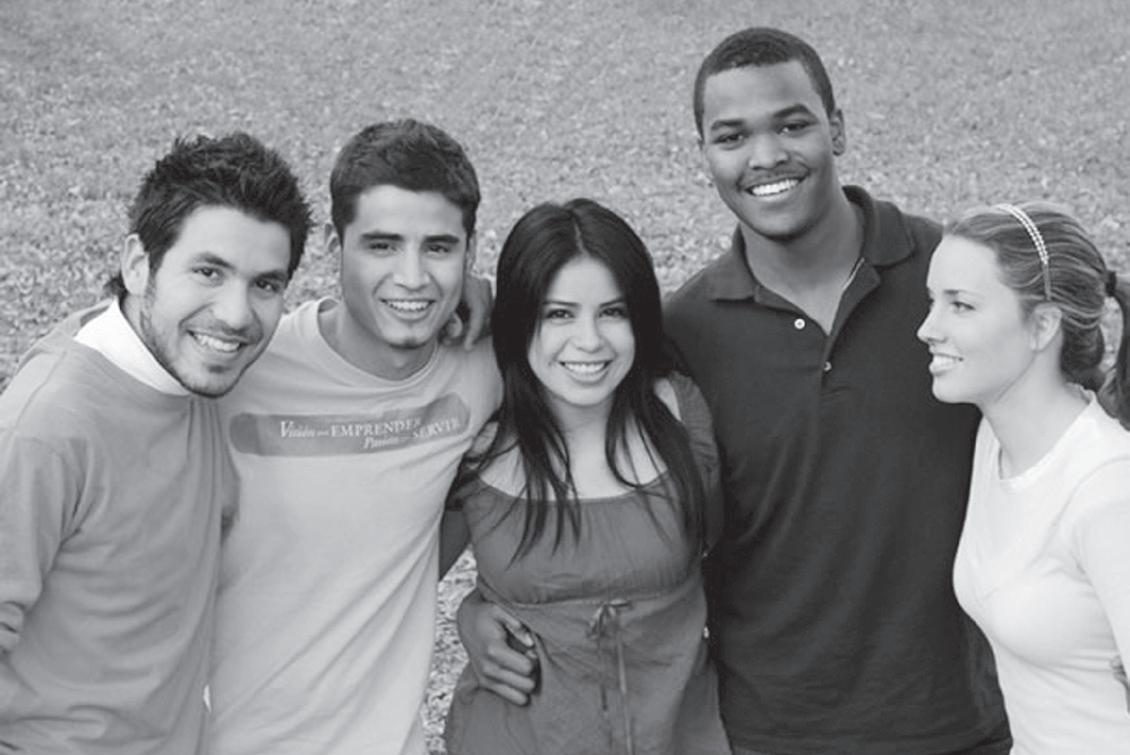
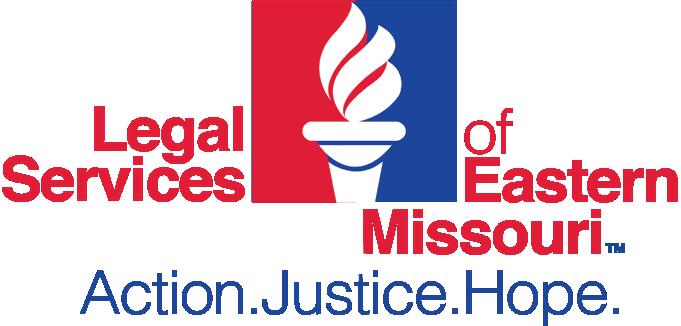
The St. Louis American’s award winning NIE program provides newspapers and resources to more than 8,000 teachers and students each week throughout the school year, at no charge.
Questions or comments? Contact Cathy Sewell csewell@stlamerican.com or 314-289-5422

Teacher and mom, Katie, watches over her children Emery, 13, and Sienna, 8, as they build a robot in a lesson inspired by The St. Louis American’s educational STEM series.
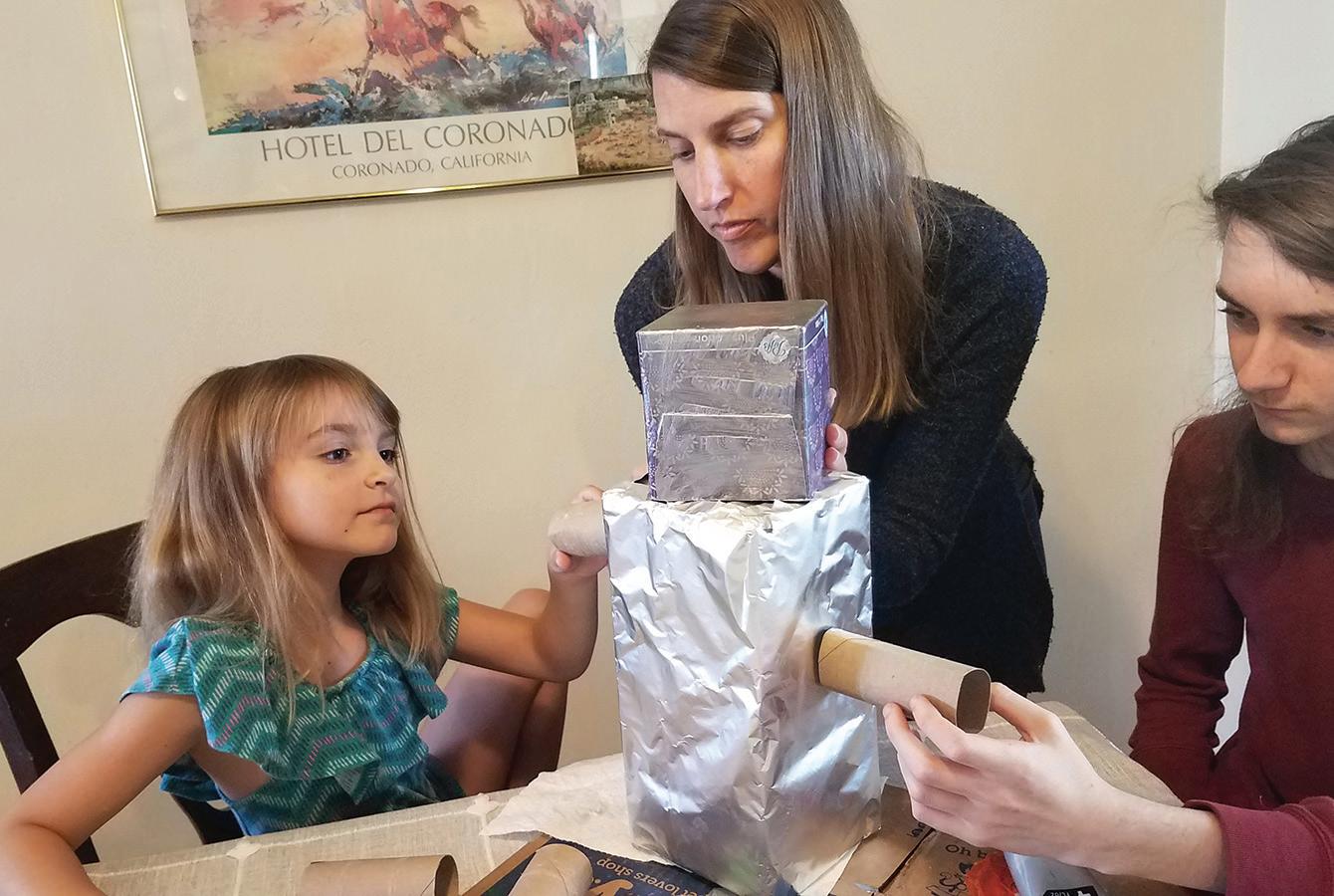
SCIENCE CORNER

Snow is a form of precipitation. When the temperature drops to 32 degrees Fahrenheit, water can freeze. Snow is formed when water vapors freeze into ice crystals. Most snowflakes are formed from over 200 tiny ice crystals! Snow can be light and powdery or it can be heavy and wet. Heavy snow is referred to as a snow storm. Blizzards are formed when there is snow with high wind. Sleet occurs when water droplets freeze on the way to the ground. “Thundersnow” occurs when there is thunder and lightning with the snow. This usually results in a higher snowfall.

Although snow can be a lot of fun, it can also be dangerous. Slips and falls are common, so walk with caution. Hold on to hand rails when possible. Cover any skin to protect it from the cold. Wear layers, so you can remove wet clothing. Snow reflects UV rays. Be sure to wear sunglasses or goggles.
For more information, visit: http:// easyscienceforkids.com/how-is-snow-made/. Learning Standards: I can read nonfiction text for main idea and supporting details. I can make textto-text and text-to-world connections.
In this experiment, you’ll be creating your own form of snow.
Materials Needed:
• 2 16oz. Boxes of cornstarch
• 1 Can of shaving cream
• Silver glitter • Large bowl
Process:
q Pour both 16-oz. boxes of cornstarch into a large bowl.
w Add a small amount of shaving cream into the bowl and stir gently. Repeat this process until you have added all shaving cream.

STEP ONE: Create a winter scene on a piece of construction paper. This will be placed on the floor as a target.
STEP TWO: Use a cotton ball to represent a snowball.
STEP THREE: Each person will take turns dropping the “snowball” onto the target 20 times.
STEP FOUR: Use a grid to record which target the snowball hits, or gets the closest to.
STEP FIVE: Calculate ratio. Example: 3 out of 20 throws landed on the tree.
DID YOU KNOW?

e Continue to knead the shaving cream into the cornstarch until well blended.
r Add silver glitter into the mixture.
Final product should be fluffy, and similar to the consistency of freshly fallen snow.
Learning Standards: I can follow sequential directions to complete an experiment.

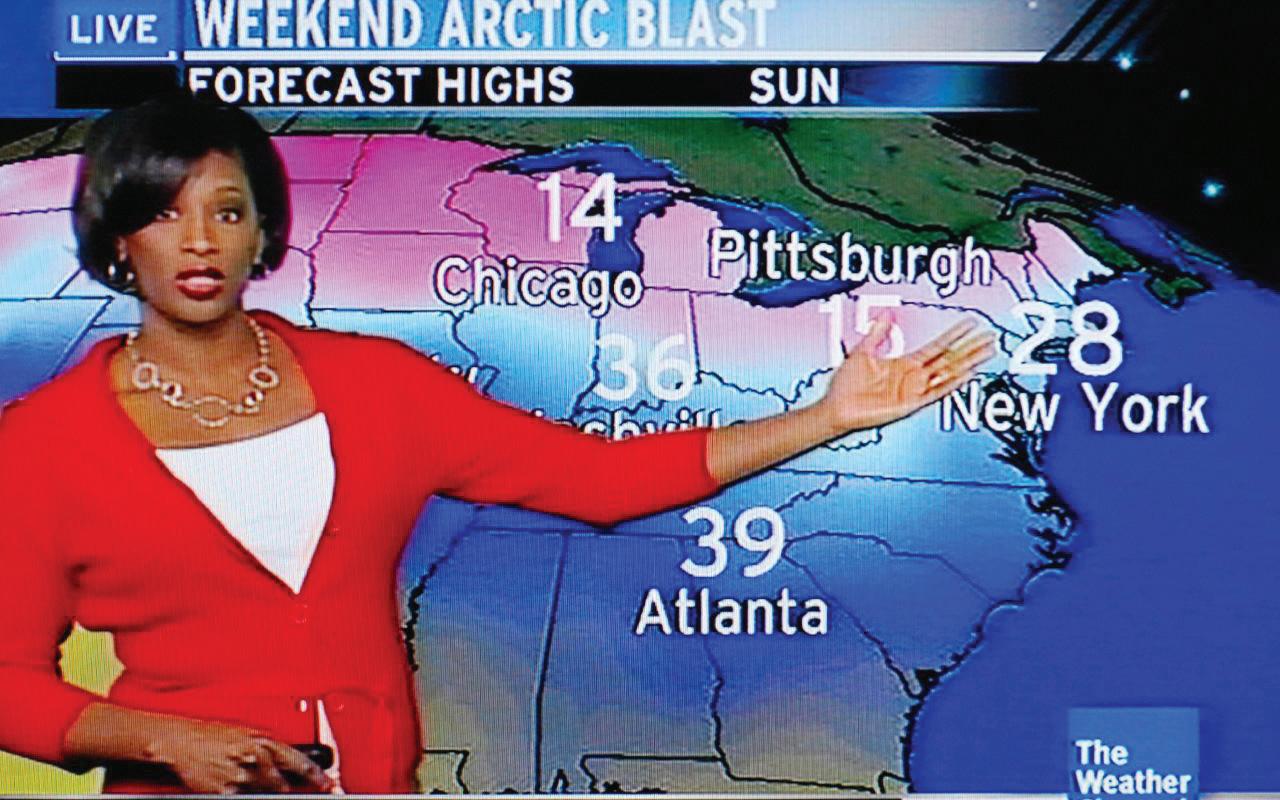
As a young child, Vivian Brown was fascinated by the weather. She wondered how it could be so drastically different from day to day. As she got older, she became interested in cloud development and weather patterns.
Brown earned a degree in Meteorology from Jackson State University and graduated in 1986. In an interview with Ebony magazine, Brown said that college was difficult because she didn’t have many people she could identify with, and she was a minority in meteorology as an African-American female. Brown worked as an intern at Georgia Tech. She decided to take a chance and contacted The Weather Channel to seek a job. The Weather Channel hired her as a forecaster, working behind the scenes. She began studying and preparing to work as an on-air personality. This presented new challenges as she had to learn how to think on her feet, as well as memorize information. Brown said the hardest part of her job at The Weather Channel was reporting on Hurricane Katrina and watching the damage via satellite. She has also hosted other shows, such as Afternoon Outlook (2003-2006), PM Edition Weekend (2006-2010), and Day Planner (2010-2013). Brown offers the following advice, “You have to follow your heart and your passion. You just have to stick with it.” She hopes to develop a scholarship or mentor program to help encourage students who are interested in science and meteorology.
Learning Standards: I can read a biography about a person who has made contributions to the fields of science, technology, engineering, and math.
STEP SIX: Use decimals and percentages for each target. Example: 25% of the snowball throws hit the scarf. 25% = .25
STEP SEVEN: Calculate the mean, median, and mode for your snowball throws.
STEP EIGHT: Choose a graph style (line, bar, plot, pie) to display your data.
Learning Standards: I can add, subtract, multiply, and divide to solve a problem. I can create graphs to represent data.

Enjoy these activities that help you get to know your St. Louis American newspaper.
Activities —
Seasonal Sales: There are many increases in sales during the winter. Look at the advertisements in the newspaper. What items are for sale? Place all sale items into a “category” and create a graph to represent those categories.


Front Page
Verbs: On the front page of the newspaper, circle in red all forms of the verb “to be,” and in blue, all forms of the verb “to have.”

Learning Standards: I can use the newspaper to locate information. I can classify items into a category. I can identify verb forms.
This shouldn’t be how we say hello...or goodbye.
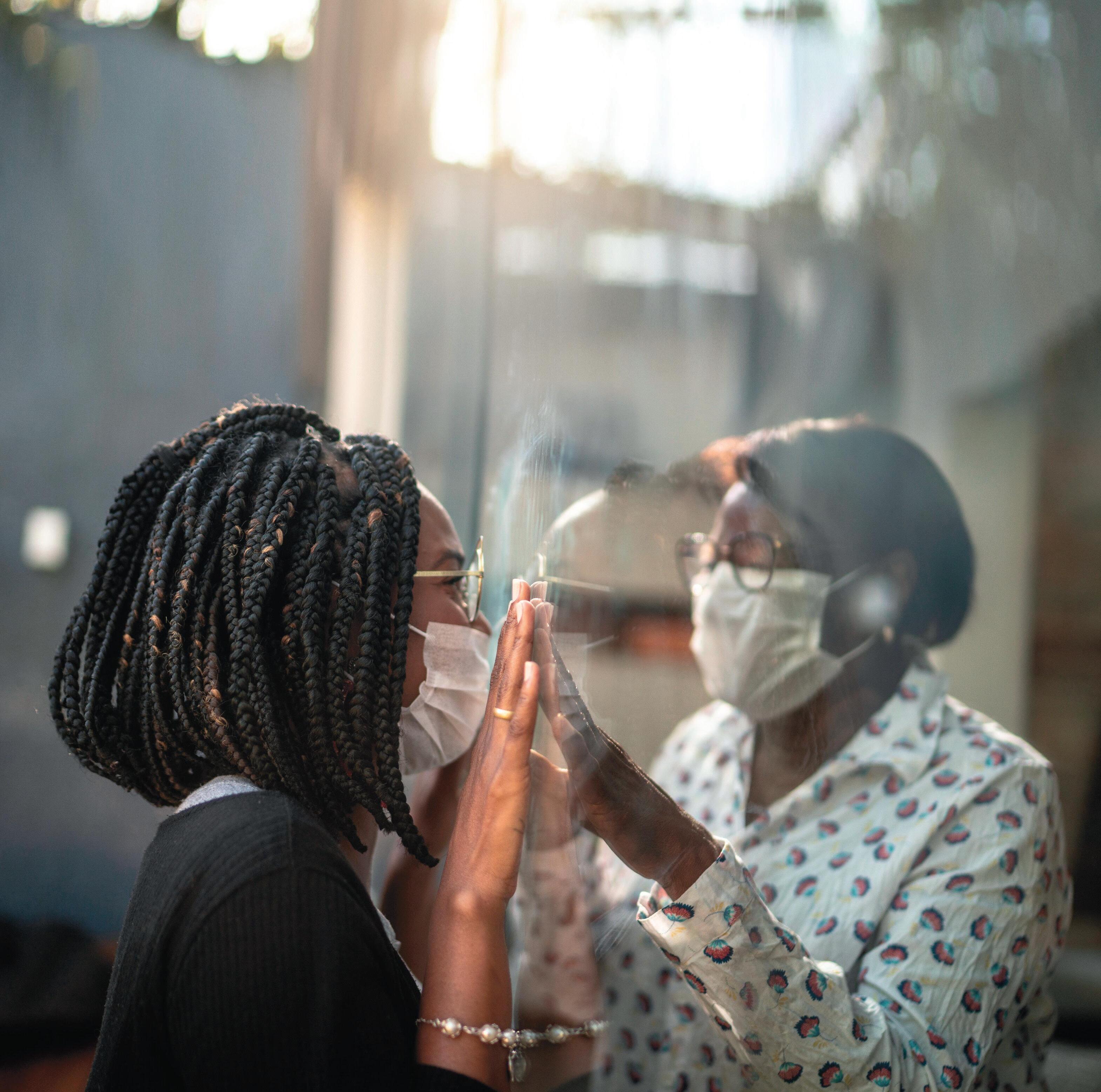
It’s our reality right now. But it won’t be if we do what it takes to beat COVID-19. Vaccines are coming, but until enough of us are vaccinated, we all still need to wear our masks, stay at least six feet from others, and avoid indoor social gatherings. The more we slow the spread, the faster we’ll return to normal hellos … and fewer goodbyes.
Learn more about vaccines and slowing the spread at cdc.gov/coronavirus
Brought to you by the U.S. Department of Health and Human Services

By Danielle Brown Of The St. Louis American
Mary Eliza Mahoney’s name might not be well-known, but it should be — especially to African American nurses. In 1879, she became the first Black person in the United States to earn a nursing degree.
Mahoney, who lived and died in Boston, was the daughter of freed slaves who moved to Boston from North Carolina. She learned about the importance of racial equality at a young age as she attended Phillips School, one of the first integrated schools in the country.
She was admitted in 1878 to The New England Hospital for Women and Children, one of the first nursing schools to operate in the U.S. She was one of four out of 42 students who had enrolled to complete the program.
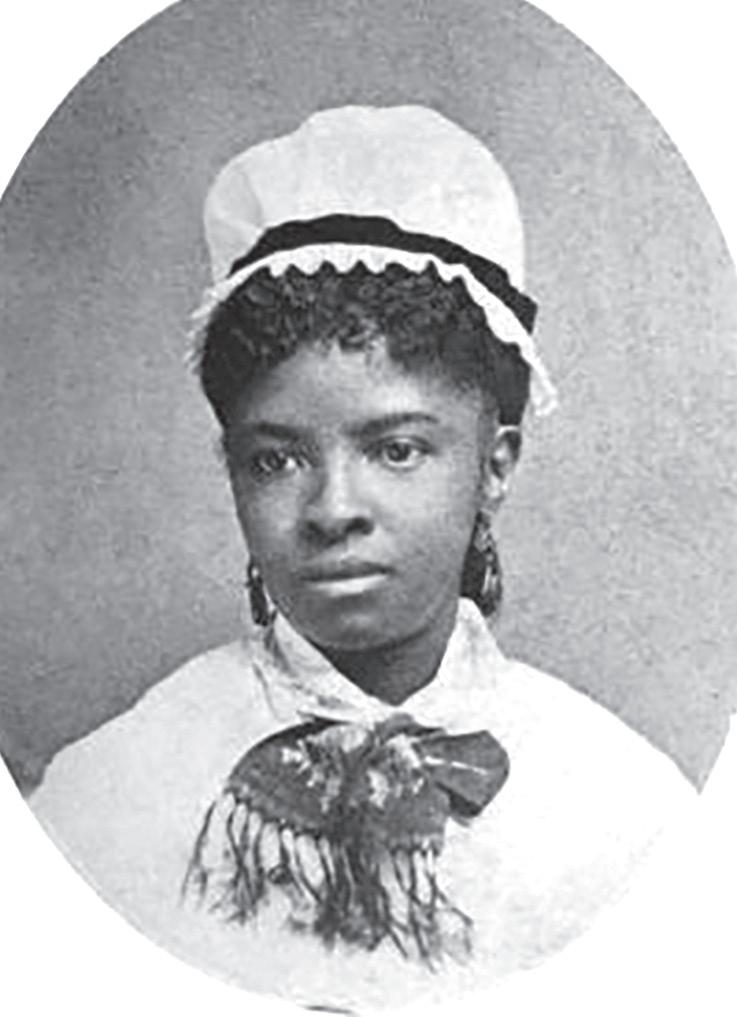
“The thing about Black folks is, we have to have somebody to look up to and say they’ve done something,” said Dr. Leonora Muhammad, president of the Black Nurses Association of Greater St. Louis.
“If Mary got her nursing degree then we can too. Since then, so many Black nurses have grown from the seed she planted.”
The National Black Nurses Association Inc. organized in 1971, aligns with the imprint Mahoney spearheaded when she paved the way for nursing professionals who look like her. Today association membership includes 200,000 Black nurses from the United States,
Canada, Eastern Carribean and Africa, with 115 chartered chapters worldwide. The Black Nurses Association of Greater St. Louis is one of them, founded in 1973 and incorporated in Muhammad joined the local chapter in 2016 and was named president in January. With her new rank, she’s adamant about increasing membership, remaining visible in the community and being a champion for patients. She also wants the organization to maintain its presence on a national level.
“What’s going on in Washington, D.C., affects not only St. Louis, but it also impacts the state,” Muhammad said. “I want nursing leaders here to represent on a national level so they can obtain information and have that voice to make changes locally.”
Throughout the current coronavirus pandemic, the chapter has persevered.
Members have visited homeless shelters throughout the city with educational fact sheets with information aimed to help slow the spread of the virus. They also distributed kits with gloves, masks and hand sanitizer.
“We’ve given out coats, meals and supplies to Gateway 180 Homeless Services and St. Louis Transitional Hope House,” Muhammad said.
“We received a donation through [drug manufacturer] Pfizer, where we can also distribute bus passes to people who work at the nursing home so they don’t have to worry about costs, since they have to get COVID tested on a weekly basis.”

In addition to her professional responsibilities, Muhammad is the associate vice president of Patient Care Services at Corizon Health, a correctional health care company aiding in mental, dental and behavorial health services for people who are incarcerated.
Afshanti Hunter, a registered nurse at St. Louis
By Olivia Riggio DiversityInc
Rosa Parks famously refused to give up her seat on a Montgomery bus in December of 1955, but months earlier, a younger woman whose name is less often featured in history books did the same. Claudette Colvin was 15 when she refused to give up her bus seat to a white passenger. She was arrested and became one of four plaintiffs in Browder v. Gayle, a case that ruled Montgomery’s segregated bus system was unconstitutional. Colvin grew up in one of Montgomery’s poorer neighborhoods. She was a dedicated student, and in her segregated school that month, students had been learning about Black figures like Sojourner Truth and Harriet Tubman, she said in an interview on NPR in 2009. She said she and her classmates were also talking about forms of racism and discrimination they faced under segregation in the South. Keeping her seat
On March 2, 1955, Colvin was riding home from school on a city bus when the driver demanded she give up her seat to a white passenger. Though she later shared with NPR how
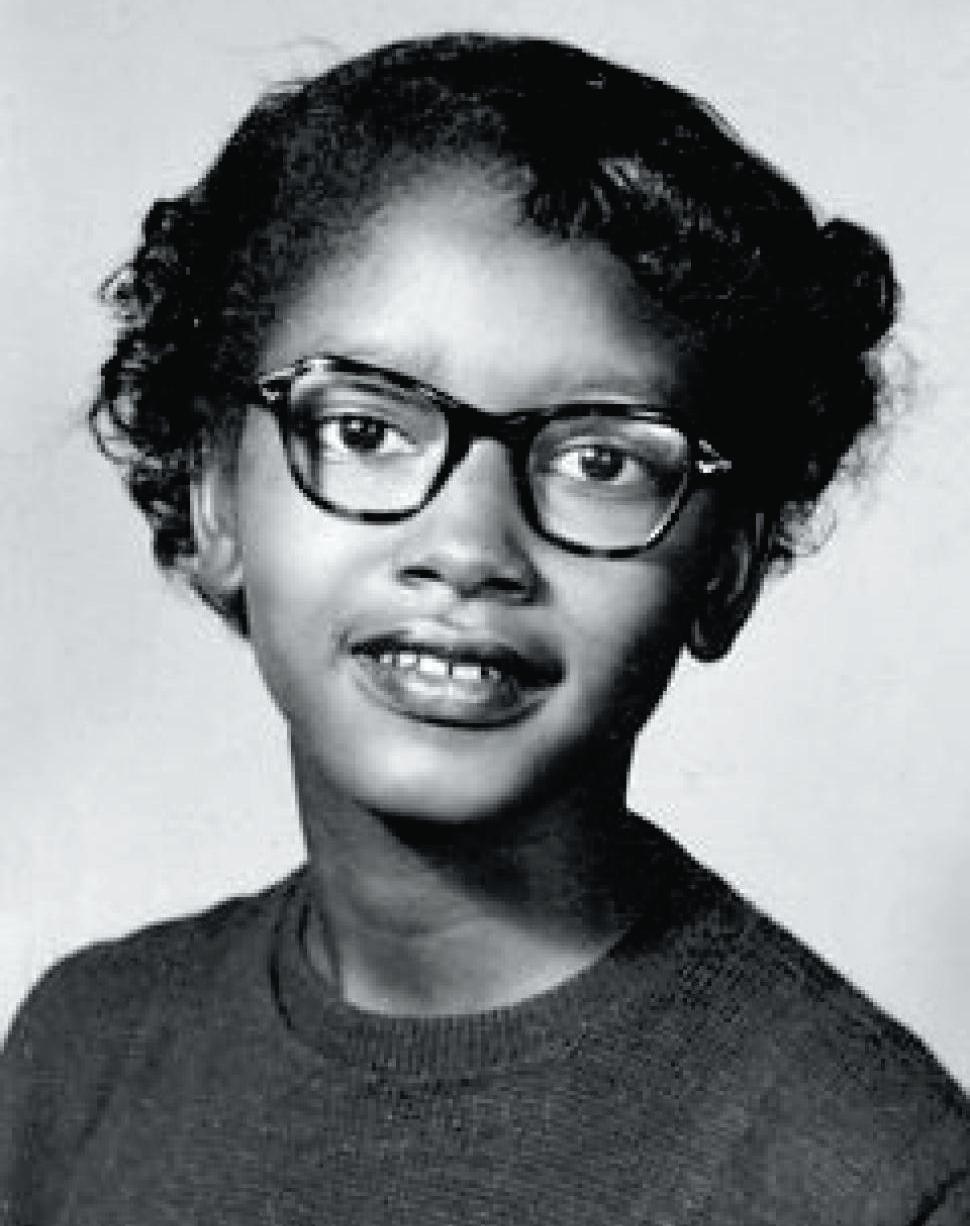
scared she was, she stood her ground.
“It just so happens they picked me at the wrong time — it was Negro History Month, and I was filled up like a computer,” Colvin said in
Claudette Colvin may be less well known than Rosa Parks, but her effort in 1955 to keep her seat on a bus rather than give it to a white person make her just as important.
Photo courtesy of DiversityInc
an interview with Newsweek in 2009.
“I felt like Sojourner Truth was pushing down on one shoulder and Harriet Tubman was pushing down on the other, saying, ‘Sit down girl!’ I was glued to my seat.”
Police dragged Colvin away in handcuffs, arresting her on several charges, including violating Montgomery’s segregation laws. They brought the teenager to jail where she stayed until the reverend at the church her family attended paid her bail. In Phillip Hoose’s 2009 biography of Colvin, “Claudette Colvin: Twice Toward Justice,” Colvin recounts the officers harassing her and calling her names.
She also described the fear she and her community felt after the incident, saying her family
Children’s Hospital, has been with BNA-STL for a year. She said she joined as a way to step out of her comfort zone.
“I decided to join because I find I don’t speak

Barbara Jordan, a Texas Congressional Democrat, was a powerful orator and a no-nonsense legislator whose political career was meteoric. She honed her vibrant, eloquent voice in brilliant dissertations before huge television audiences pleading that justice should not be exclusively for the elite and the powerful. Lawyer, educator and politician who was a leader in the Civil Rights Movement, Jordan was the first African American elected to the Texas Senate after Reconstruction and the first Southern African American woman elected to the United States House of Representatives. She was best known for her eloquent opening statement in 1974 at the House Judiciary
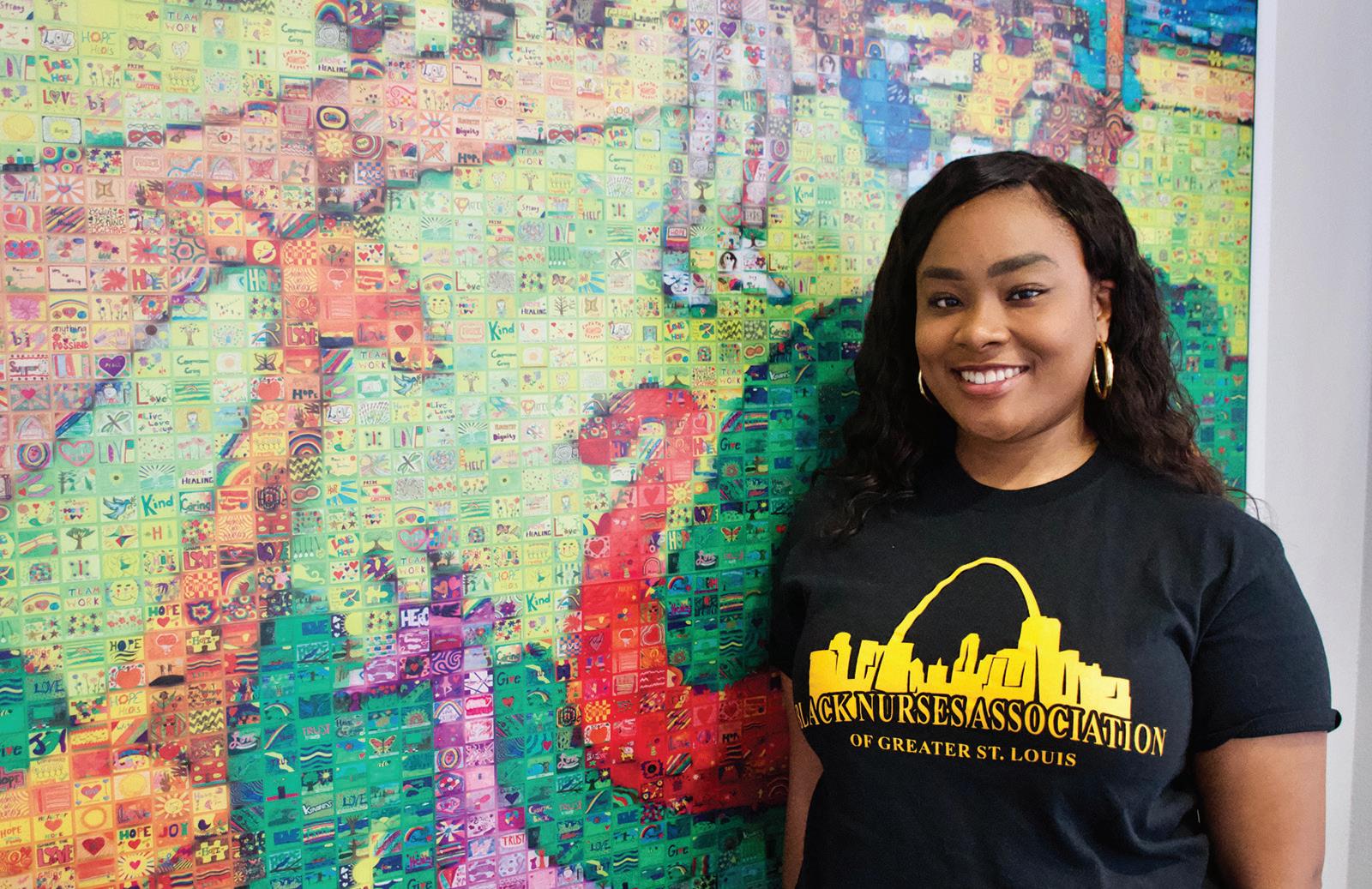
Photo by Wiley Price/St. Louis American
Afshanti Hunter is a registered nurse at St. Louis Children’s Hospital and a member of the Black Nurses Association of St. Louis.
up as often as I should and I wanted to change that,” Hunter said. “I’ve been enjoying my time so far in the organization because it feels like I’m at a family gathering.”
Like Muhammad and many others, Hunter has found herself having to adjust to the pandemic. Her work as a registered nurse on the pulmonary floor looks much different from what it did before.
“When I wear my masks the kids want to pull my mask down to see my face, but I can’t do that,” Hunter said. “So instead I have to come up with innovative ways to make them feel more comfortable like
n “I want nursing leaders here to represent on a national level so they can obtain information and have that voice to make changes locally.”
— Dr. Leonora Muhammad, president of the Black Nurses Association of Greater St. Louis
singing them songs or making animal noises.”
Since Mahoney’s time, the scope of the profession has made tremendous strides.
Today there are many career choices.
“If you don’t have the funds to go to a four-year school, you can go to community college and still become a registered nurse,” Hunter said.
“Everybody’s like, ‘I wanna be a nurse.’ Well, you gotta go to school to become a nurse, but you have multiple avenues to go through.”
More than a century ago, Mahoney chose nursing as her passion to encourage better quality health care for women and African Americans. She worked as a private nurse until she retired. She died at 80 in 1926, after a three-year battle with breast cancer.
Her legacy lives on.
Learn more about BNA-STL, here: http://www.bna-stlouis. org/
Continued from B1
and neighbors stayed up all night to keep watch against retaliation.
“I had stood up to a white bus driver and two white cops,” she said in the biography. “I had challenged the bus law. There had been lynchings and cross burnings for that kind of thing.”
Colvin’s community may have been on her side that night, but her story did not gain as much traction as it could have. A number of women had been doing the same thing Colvin and Parks did but were typically just fined and did not make headlines.
The NAACP, however, considered using Colvin’s story to challenge segregation laws.
The organization ultimately did not because of her youth and because she became pregnant shortly after her arrest. They believed an unwed teen mother would attract too much public criticism.
Parks was more acceptable
Nine months later, Rosa Parks became the face of the fight against Montgomery bus segregation. Parks’ image and age, Colvin told NPR, were more palatable and easier for Black organizations to bolster.
“Her skin texture was the kind that people associate with the middle class,” Colvin told NPR. “She fit that profile.”
Legally, Colvin continued to challenge her charges. The court ruled against her and put her on probation, which, along with her unplanned pregnancy, left her open to public ridicule. She later had to drop out of college and had trouble finding a job.
She became one of four plaintiffs in the Browder v. Gayle case in 1956. The other plaintiffs included Aurelia S. Browder, Susie McDonald and Mary Louise Smith — all Black women who had faced discrimination on city buses.
Attorneys Fred Gray and Charles Langford filed the case on the women’s behalf. Defendants included Montgomery Mayor William A. Gayle, the city’s chief of police, representatives from Montgomery’s Board of Commissioners, Montgomery City Lines, Inc., two bus drivers, and representatives of the Alabama Public Service Commission.
The case decided Montgomery’s segregated bus system was unconstitutional.
Colvin later moved to New York City with her son, had a second son and worked as a nurse’s aide.
Colvin’s legacy may have been left out of mainstream discourse about the civil rights movement, but she still left an impact. In addition to Hoose’s biography about her, Colvin was also the subject of Rita Dove’s poem, “Claudette Colvin Goes to Work,” which later became a song composed by folk musician John McCutcheon.
Claudette Colvin Goes to Work”
A poem by Rita Dove
Menial twilight seeps the storefronts along Lexington as the shadows arrive to take their places
among the scourge of the earth. Here and there
a fickle brilliance — light bulbs coming on

in each narrow residence, the golden wattage of bleak interiors announcing Anyone home?
or I’m beat, bring me a beer. Mostly I say to myself Still here. Lay my keys on the table, pack the perishables away before flipping the switch. I like the sugary look of things in bad light — one drop of sweat is all it would take to dissolve an armchair pillow into brocade residue. Sometimes I wait until it’s dark enough for my body to disappear; then I know it’s time to start out for work.
Along the Avenue, the cabs start up, heading Toward midtown; neon stutters into ecstasy as the male integers light up their smokes and let loose a stream of brave talk: “Hey Mama” souring quickly to “Your Mama” when there’s no answer — as if the most injury they can do is insult the reason you’re here at all, walking in your whites down to the stop so you can make a living.
So ugly, so fat, so dumb, so greasy — What we have to do to make God love us?
Mama was a maid, my daddy mowed lawns like a boy, and I’m the crazy girl off the bus, the one who wrote in class she was going to be President. I take the Number 6 bus to the Lex Ave train and then I’m there all night, adjusting the sheets, emptying the pans. And I don’t curse or spit or kick and scratch like they said I did then I help those who can’t help themselves, do what needs to be done . . . and I sleep
Whenever sleep comes down on me.
Committee hearings during the impeachment process against President Richard Nixon. In the impeachment hearings, she said, “My faith in the Constitution is whole, it is complete, it is total, and I am not going to sit here and be an idle spectator to the diminution, the subversion, the destruction of the Constitution.”
She was the first African American and the first woman to deliver a keynote address at the Democratic National Convention in 1976, where she electrified delegates and held the nation watching television spellbound in her fiery address. She was a member of the
Bessie
February 15
1848 — Sarah Roberts is barred from white school in Boston. Her father, Benjamin Roberts, filed the first school integration suit on her behalf.
1851 — Black abolitionists invade a Boston courtroom and rescue a fugitive slave.
1968 Henry Lewis becomes the first Black conductor to lead a symphony orchestra in the United States.
February 16
1857 Frederick Douglass is elected president of Freedman Bank and Trust.
1923 — Bessie Smith makes her first recording, “Down Hearted Blues,” which sells 800,000 copies for Columbia Records.
1951 — New York City Council passes a bill prohibiting racial discrimination in city-assisted housing developments.
February 17
1870 — Congress passes a resolution readmitting Mississippi on condition that it would never change its constitution to disenfranchise Black people.
1963 — Michael Jeffrey Jordan, famed basketball player and former minor league baseball player, is born in New York, N.Y.
1997 — Virginia House of Delegates votes unanimously to retire the state song, “Carry Me Back to Old Virginia,” a tune that glorifies slavery.
February 18

1688 — First formal protest against slavery by organized a white group in English America made by Germantown Quakers at monthly meeting.
1865 — Rebels abandon Charleston. First Union troops to enter the city included 21st U.S.C.T., followed by two companies of the 54th Massachusetts Volunteers.
1931 —
Chloe Anthony Wofford), who will win the Pulitzer Prize for her novel “Beloved,” was born on this day in Lorain, Ohio.
February 19:

Photo

February 20 !895 - Death of Frederick Douglass, the leading Black spokesman for almost 50 years. He was a major abolitionist, lecturer and editor.
February 21

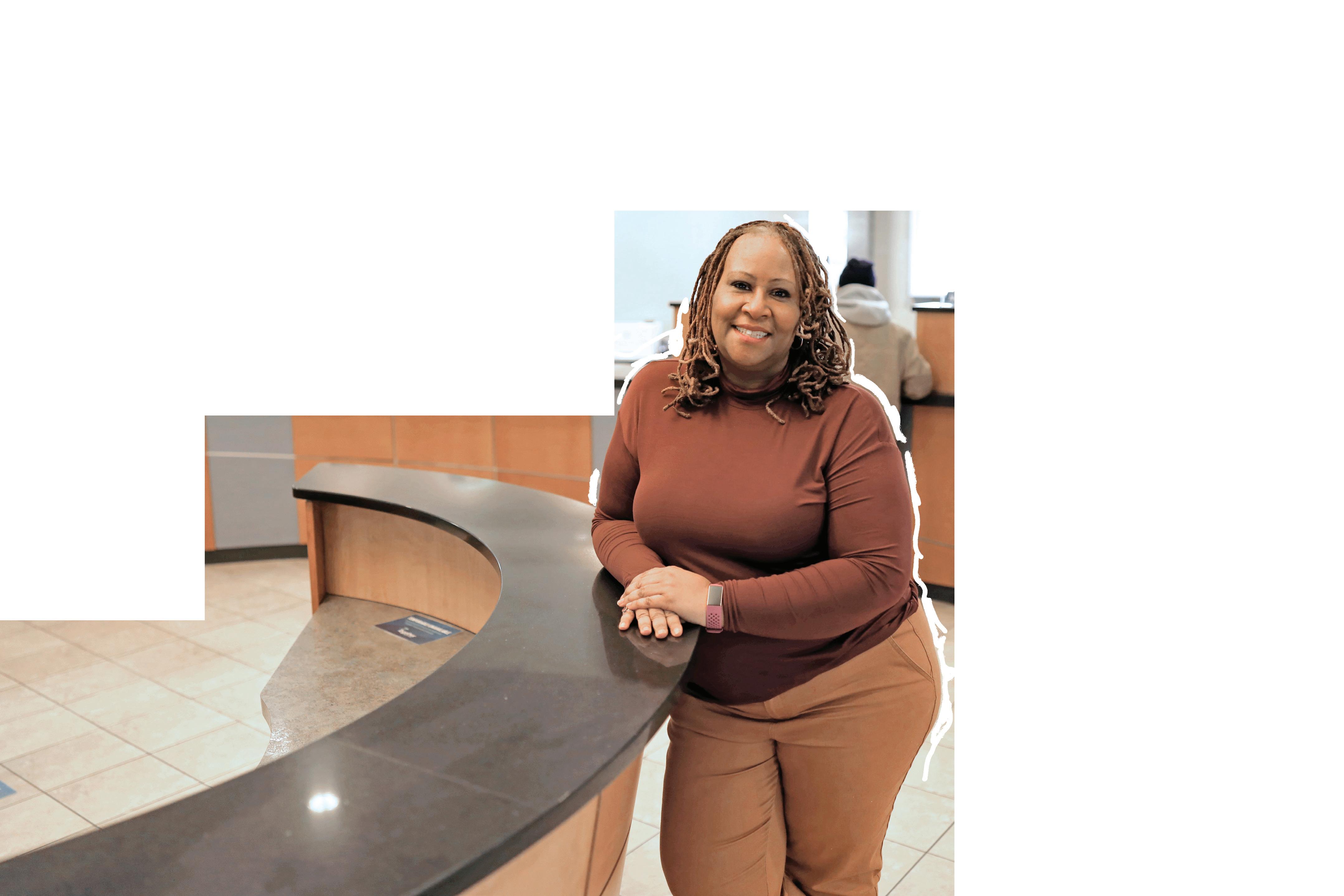
To learn more about Mocha Tea, visit maryville.edu/mochatea


By Mike Jones
For The St. Louis American
America has made only one unique cultural contribution to the world, that’s jazz. Jazz is to America what democracy is to Greece.
If you talk to jazz musicians or jazz historians there’s a consensus on one thing, Louis Armstrong is the most important musician in American history, and by extension one of the most important musicians in the world.
Nobody invents an artistic genre, but all art has a point of origin, if you say jazz was born from our American experience, then Louis Armstrong was the midwife.
the purpose of Black History Month without knowing and understanding who Carter G. Woodson is. He is to Black History what Armstrong is to jazz, the place you start. An activist and scholar, Woodson was no ordinary brother, a contemporary and intellectual peer of W.E.B. Du Bois, he was the second Black American to earn a Ph.D. from Harvard, Du Bois being the first. In 1915 he founded the Association for the Study of Negro Life and History, which included would become the Association for the Study of African American Life and History.

To understand why, we have to go back to the 1920s. In Chicago from 1925-28, Armstrong formed a band solely to record, Louis Armstrong Hot Five, and made recordings that revolutionized jazz and would become the foundation of and provide the architecture for the music that’s played today. Armstrong solidified the concept of the solo as an integral part of jazz. Arguably the creator, and definitely master of the extended jazz solo, he played in higher registers, longer and faster, while improvising with more all-around virtuosity than anyone had done before.
So if you’re serious about being a jazz musician or just want to be an informed listener, it’s essential that you know and understand who Louis Armstrong is and what he’s doing in Chicago in the 1920s. Just as Armstrong is essential to understanding jazz. You can’t know and understand
What motivated Woodson was his belief that he (and others) had no future in the whitedominated historical profession, and to work as a Black historian would require creating an institutional structure that would make it possible for Black scholars to study history. In addition, his interest went beyond the geographical confines of the United States and extended to all of the African Diaspora.
Also, like Armstrong, he produced a historical norm defining work. For Armstrong it was his Hot Five recordings that produced the shape of what jazz was to become, For Woodson it was his 1933 seminal work,The Mis-Education of the Negro.
His thesis was Black Americans of his day were being culturally indoctrinated, rather than educated. This indoctrination was the reason that causes Black people continue to be dependent and to seek out inferior places in the

greater society.
Or, as he put it, “No systemic effort toward change has been
n If you’re serious about being a jazz musician or just want to be an informed listener, it’s essential that you know and understand who Louis Armstrong is and what he’s doing in Chicago in the 1920s.
possible. For taught the same economics, history, philosophy and literature which have estab-
lished the present code of morals, the Negro’s mind has been brought under the control of his oppressor.”
While a severe critic of the existing education provided
Black America, he had an aspirational vision for what an education designed to meet the needs of Black people could accomplish,
“Real education means to inspire people to live more abundantly, to learn to begin with life as they find it and make it better,” and “Those who have no record of what their forebears have accomplished lose the inspiration which comes from the teaching of biography and history.”
What should not pass without notice is that Woodson and Armstrong, along with a sizable collection artists,
intellectuals and writers who would come to be known as the Harlem Renaissance, were all part of that first generation of Black Americans born after Emancipation, who came of age at the beginning of the 20th century and had the freedom, in spite of the racial terrorism of that era, to create and define a Black identity and ascetic that’s the foundation of our collective understanding of who we are today.
To understand how we’ve gotten so far from the vision Woodson had for Negro History Week, we need to understand the difference between a tradition and a habit.
A tradition is the transmission of customs or beliefs from generation to generation. A habit on the other hand, is a routine of behavior that is repeated regularly and tends to occur subconsciously. We have permitted the tradition founded by Woodson to become just a habit of contemporary Black American life.
We treat Black History Month like Jeopardy, we’ll spend 28 days posing random questions and giving factoid answers, where neither the question nor the answer has any contextual reference or relevance, kinda like Black Heroes for $200.
For Woodson, and by extension us, Black history was the effort to answer the existential questions posed by 19th century Danish philosopher and theologian Soren Kierkegaard (someone I’m sure he had read), “Where am I? Who am I? How did I come to be here? ...” What every February does is challenge us to continue the tradition started by Carter G. Woodson, to ask and struggle to answer these existential questions.
Katrina
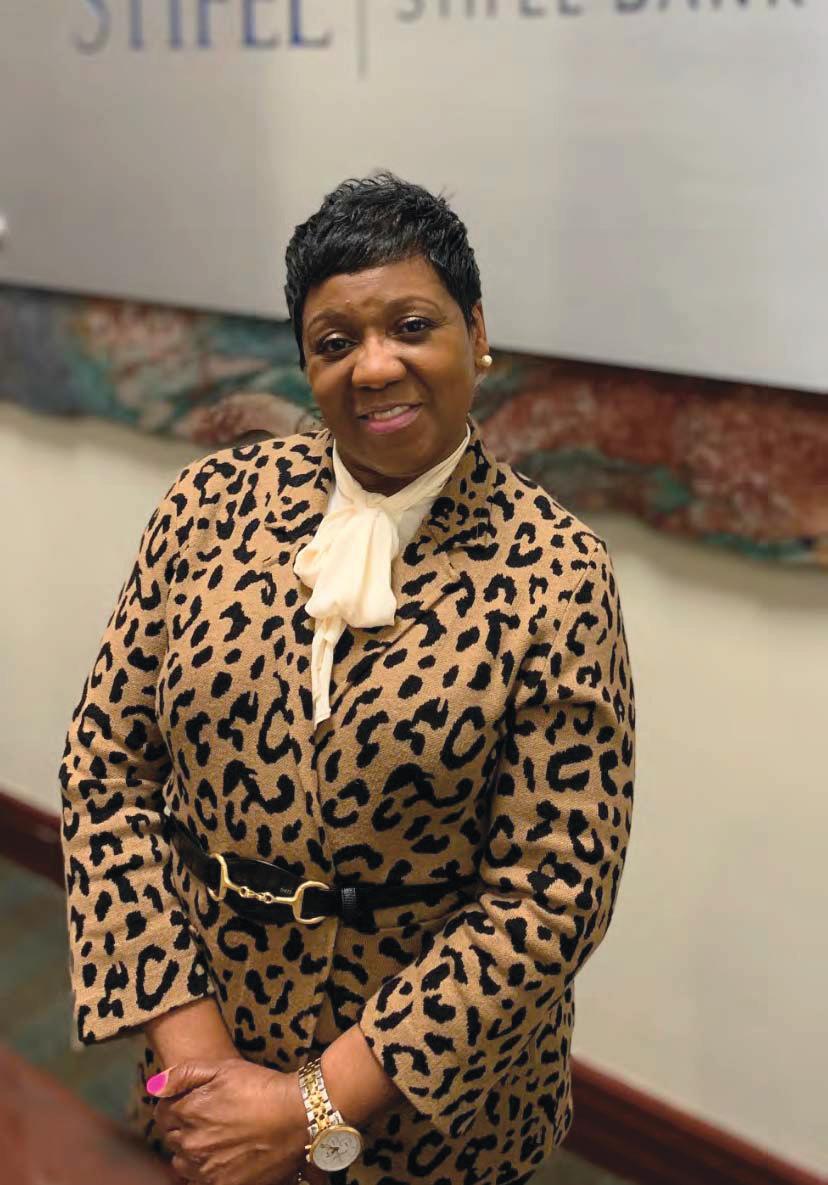

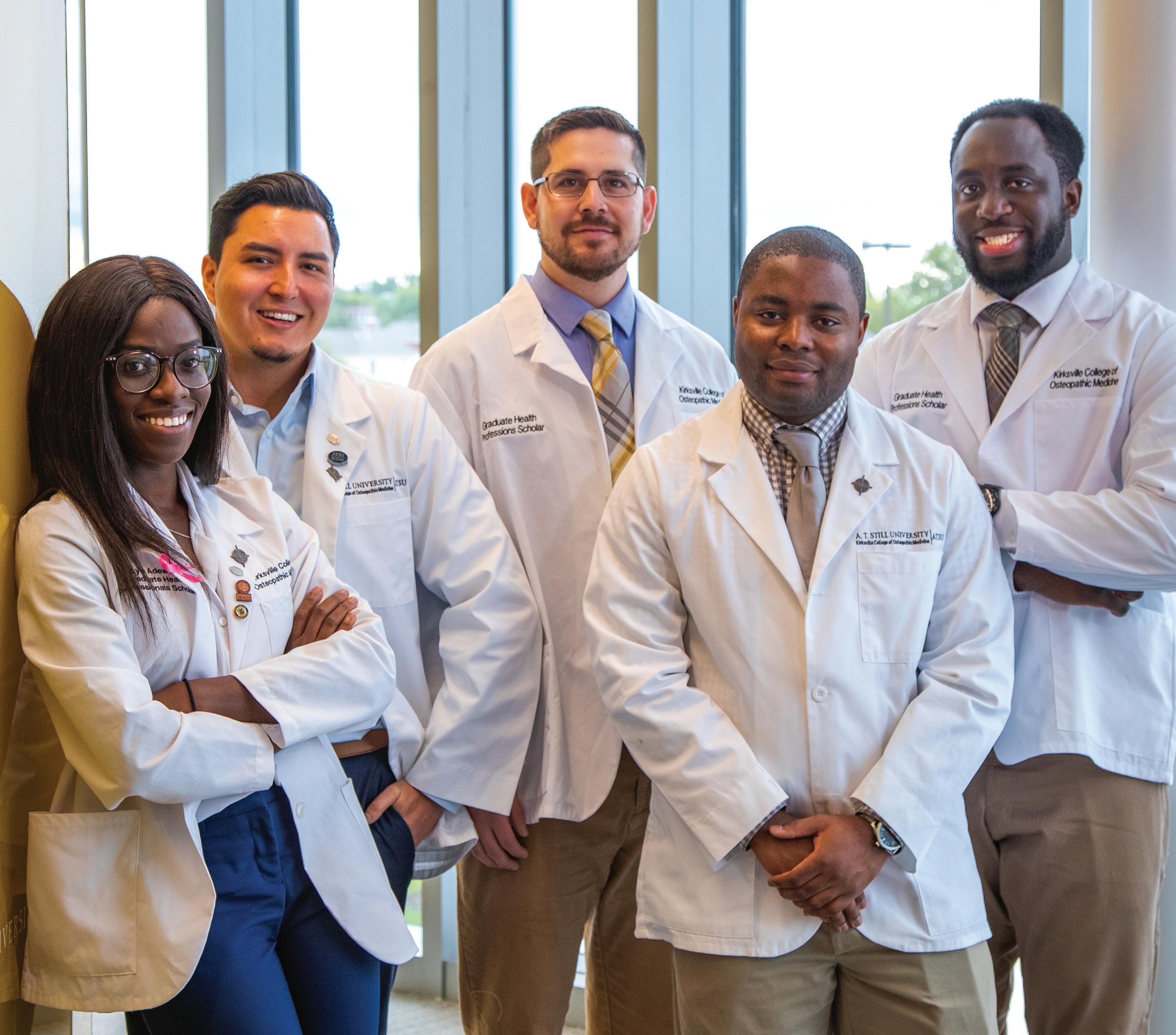
A.T. Still University celebrates Black History Month in recognizing, valuing, and celebrating global contributions from the Black community.
Founded in 1892, A.T. Still University (ATSU) has a history of inclusion as the founding school of osteopathic medicine. We are proud to continue that history as a recipient of the HEED award for the fourth consecutive year.
ATSU offers an array of health professions degrees in medical, dental, and allied health programs, on campus and online.
• Athletic training
• Audiology
• Biomedical sciences
• Dental medicine
• Health administration
• Health education
• Health sciences
• Kinesiology
• Nursing
• Occupational therapy
• Osteopathic medicine
• Physical therapy
• Physician assistant studies
• Public health
In the past 12 months, searches for Black-owned businesses have increased 600%. So we’re making it easy for businesses to proudly self-identify as Black-owned on Google Search and Maps. Companies with a verified Business Profile on Google can now add a Black-owned business attribute to their profile, so they can easily be found by customers who are looking to support them.
Learn more at g.co/blackowned

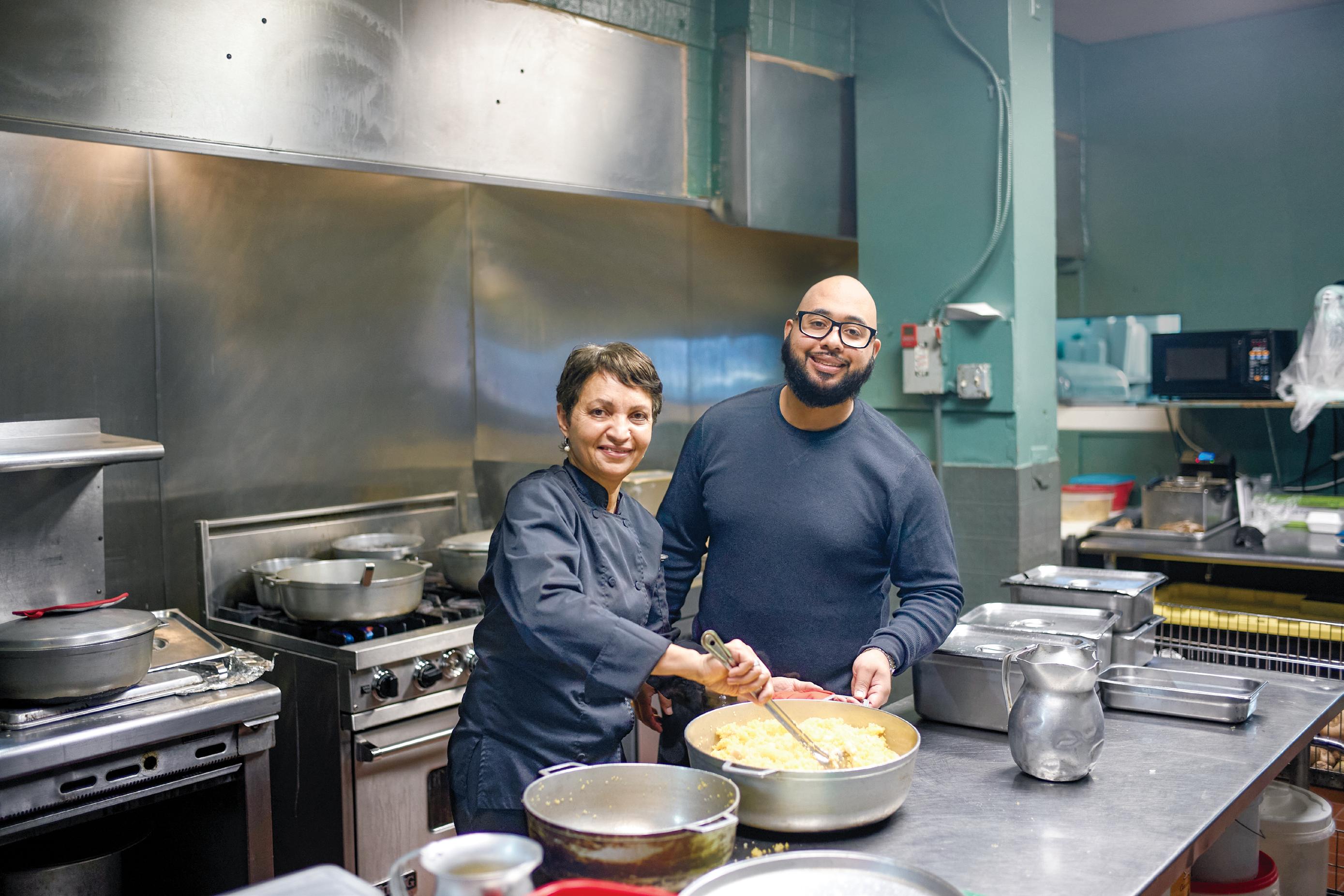

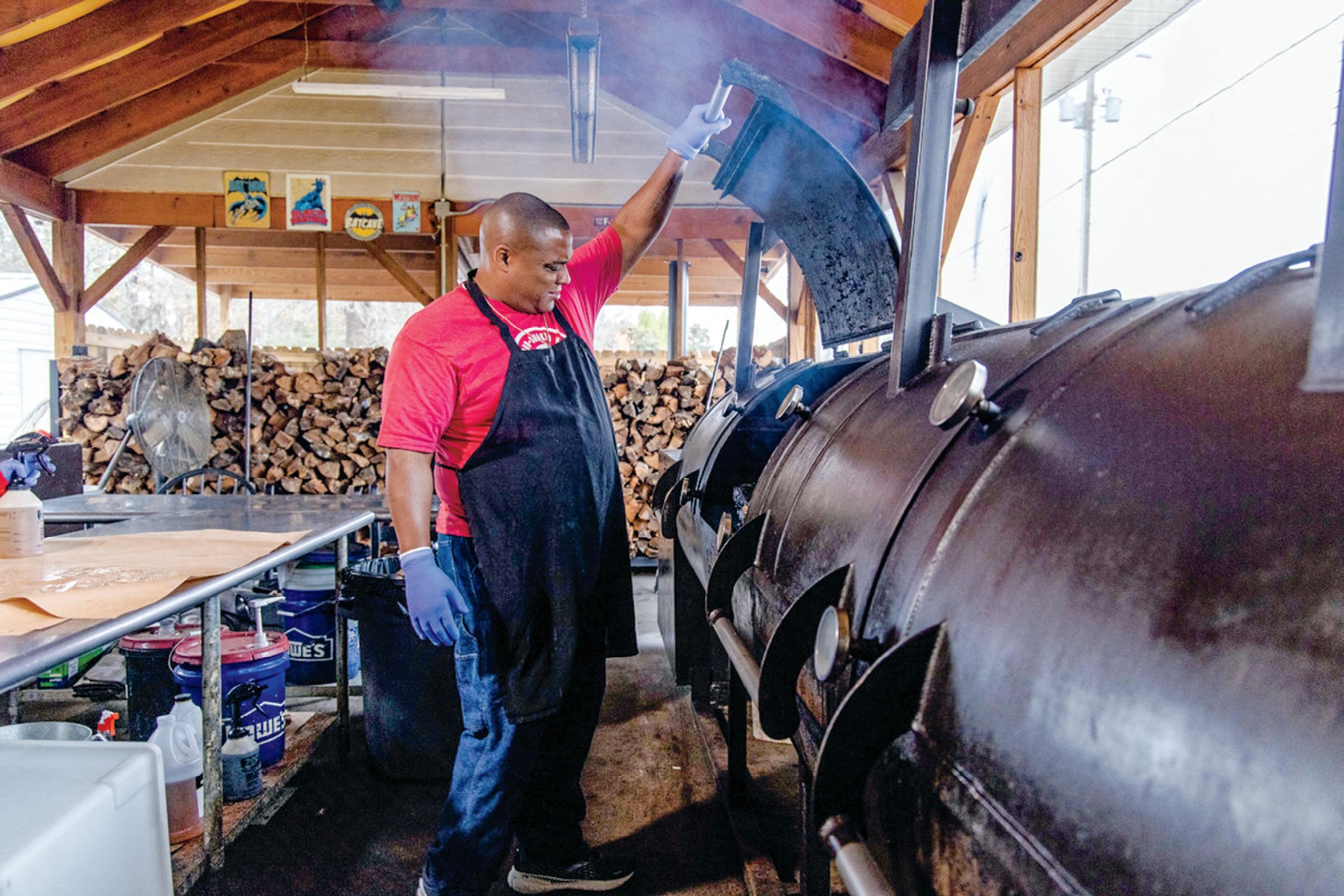


Saint Louis Art Museum
The Saint Louis Art Museum has acquired a ceramic vessel signed and dated by David Drake (c.1801–1870s), an enslaved artist who is recognized as one of America’s most important 19th-century ceramicists. The museum purchased the work in December for $155,000.
Drake is known for his skill as a potter, and for his ability to read and write at a time when anti-literacy laws were common in states where slavery was legal. He often inscribed ceramics with signatures, dates and even rhyming verse. Today, these inscriptions are seen as defiant expressions of literacy, authorship and creativity in the face of slavery.
Ceramics made by Drake, also known as Dave the Potter, are significant artworks in their own right, and they are increasingly valued for their rich, interpretive potential in museum collections.
Acquiring such a work has been a priority for many years, said Brent R. Benjamin, the Barbara B. Taylor Director of the Saint Louis Art Museum.
“The acquisition of this extraordinary vessel underscores the Saint Louis Art Museum’s ongoing commitment to acquire exceptional works of art by African American artists,” Benjamin said. “This work will enrich our galleries, and it will allow us to present an expanded history of early American art.” Drake was born into slavery in South Carolina about 1801. Over his lifetime he labored in several potteries in the area around Edgefield, S.C., then a center of stoneware production. Drake produced utilitarian stoneware jugs, pitchers and jars that were used to store

plantation-produced liquids and foodstuffs like beef, pork and lard.
The largest known vessels made by Drake measure more than 2 feet in height, with thick walls, and capacities greater than 20 gallons. The museum’s jar is compelling in size and form, with robust handles and a rich brown surface marked with splashed and dripped pale ochre-colored alkaline glaze.
While the jar’s clay was still damp, Drake inscribed his name below the date of June 6,

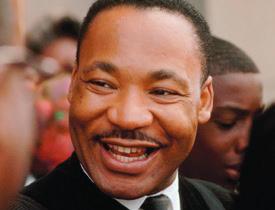
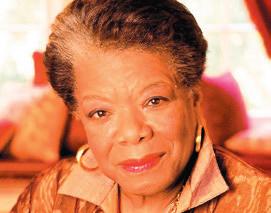

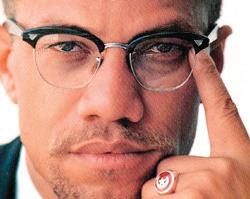
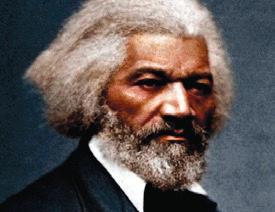
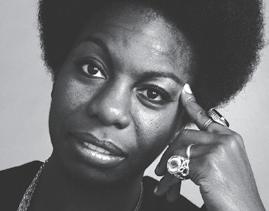



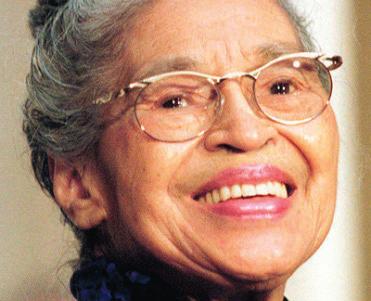

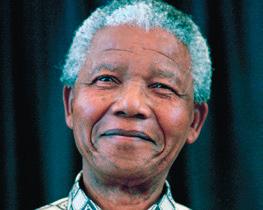
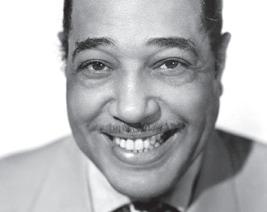






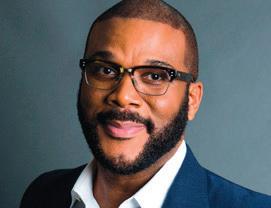

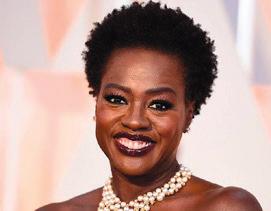
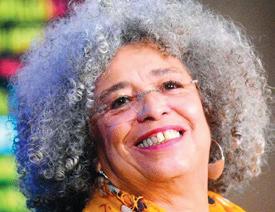

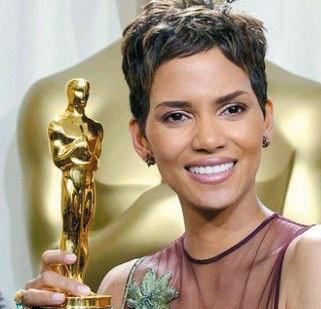

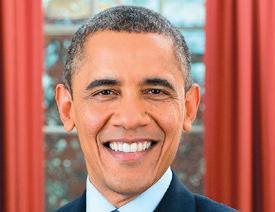



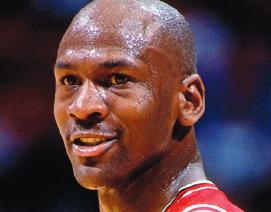
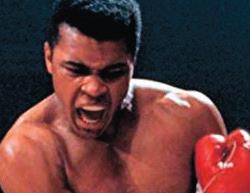


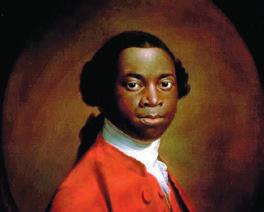
1857, and 10 dots to indicate its 10-gallon capacity.
Evidence of the maker’s hand is palpable where his fingers gripped the base and the rim as he coated the vessel with glaze.
The initials “Lm” near the rim indicate Lewis Miles, Drake’s enslaver and the proprietor of the Stoney Bluff Plantation, where Drake labored daily from 1849 until Emancipation.
The jar will go on view later this year in the Museum’s galleries devoted to 19th-century American art.




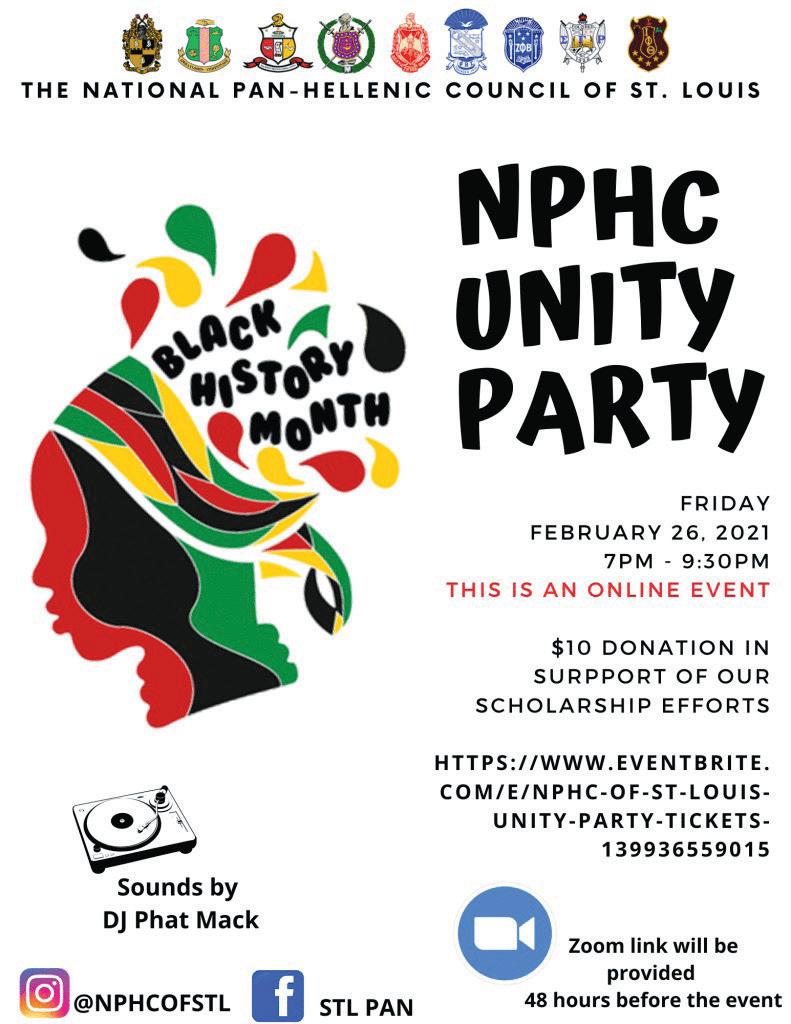
Centene Corporation presents

Dorothy Lavinia Brown was born January 7th, 1919, in Philadelphia, Pennsylvania. When she was just five months old her mother, Edna Brown, placed her in an orphanage, where she would grow to
the age of thirteen before seeing her again. Shortly after her mother reclaimed her on her birthday, Dorothy Brown began returning to the orphanage, running away from her mother five times. After having her tonsils removed, she resolved to have a career in medicine. Determined to get an education, fifteen-year-old Brown ran away to attend Troy High School and graduated top of her class. Her efforts were noticed and she was awarded a four year scholarship.

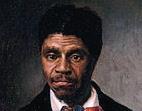







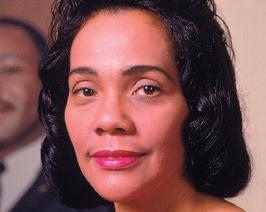



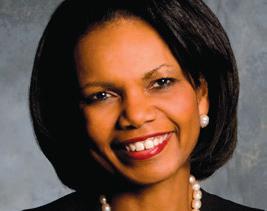


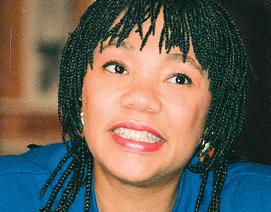




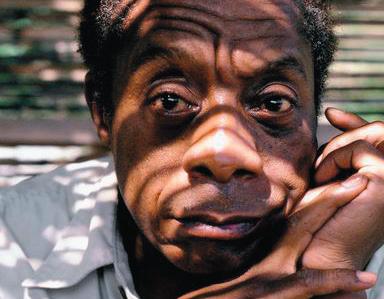
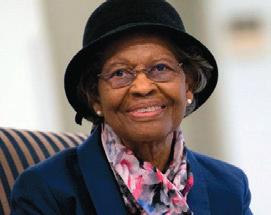
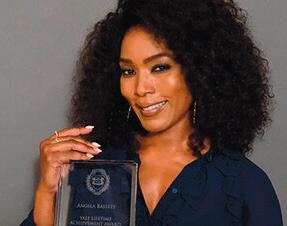
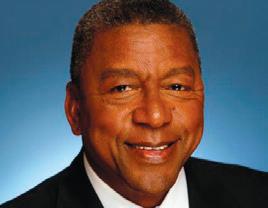



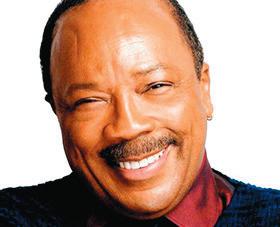
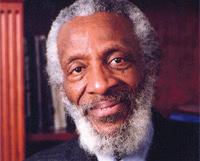


In 1941, she earned her B.A., graduating second in her class from Bennett College in Greensboro, North Carolina.
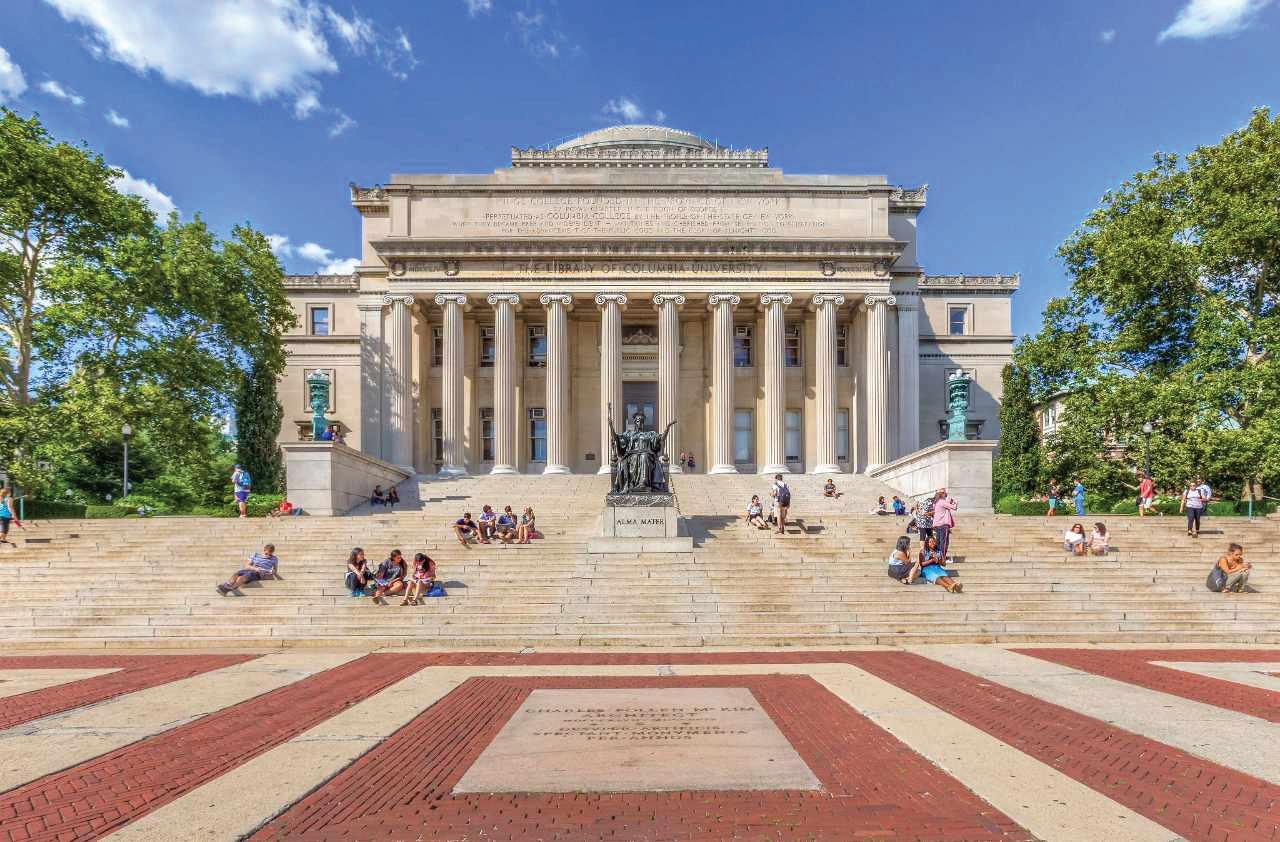
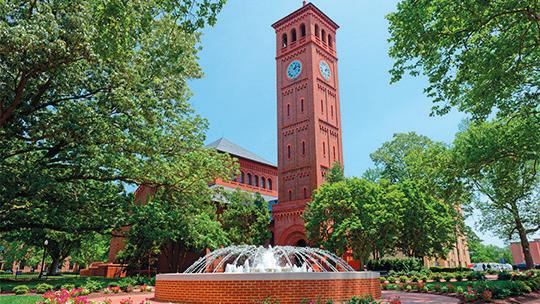
After time spent aiding as an inspector in the war effort, Brown finished her schooling graduating from Meharry Medical College, in 1948. She was beset on all sides by heavy discrimination as she grew into her role as the first African-American female surgeon in the south.

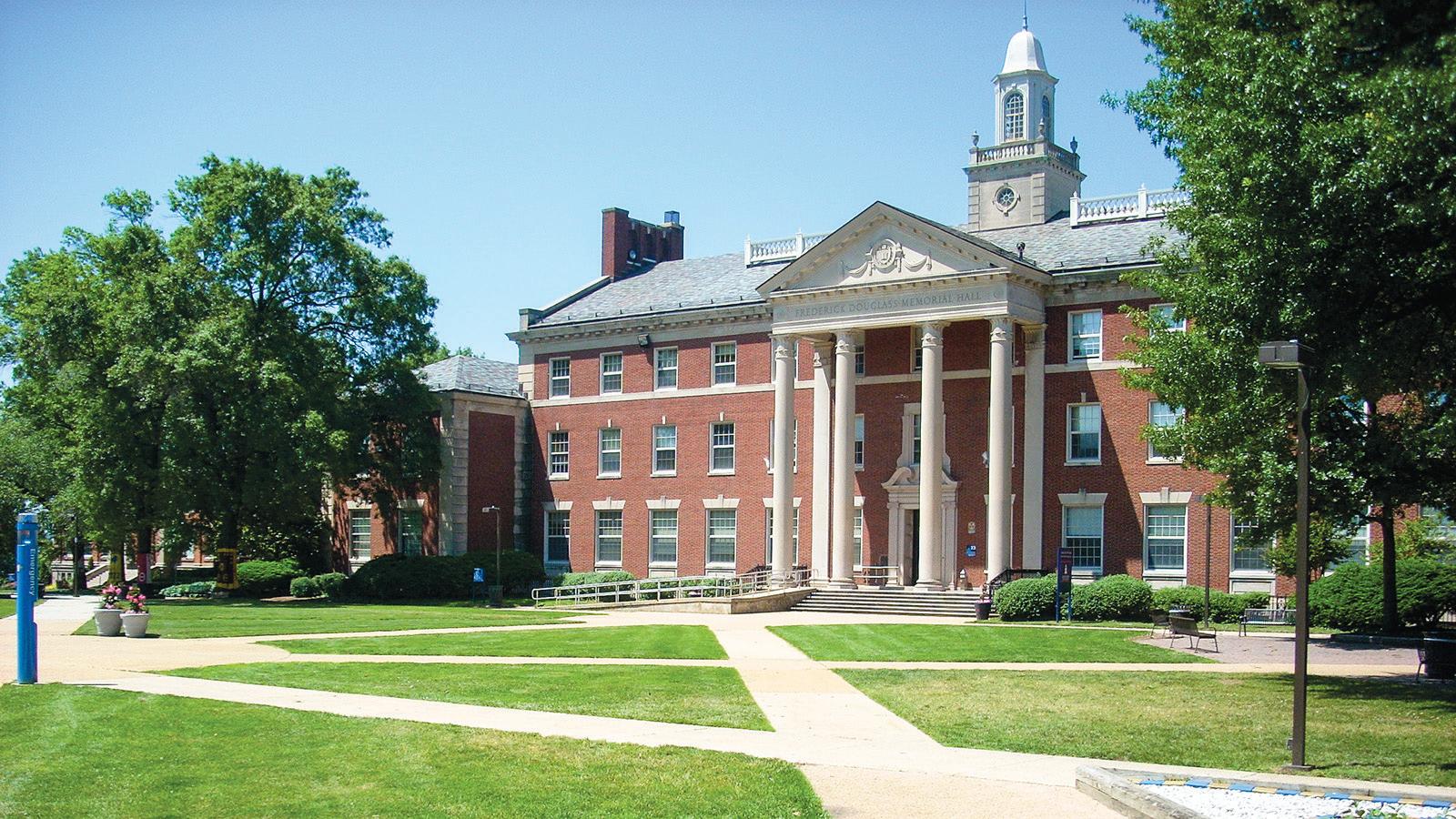

Dorothy Brown spent her life defying barriers. Once an orphan herself, she became the first single woman to adopt a child in Tennessee. In 1966, Brown ran for state legislature and won, becoming the first black woman representative in Tennessee. Later in life she said she was proud to be a role model, “not because I have done so much, but to say to young people it can be done.”

Special to The American
To commemorate Black History Month, Black-owned media companies Rolling Out and BlackBookStore.com, in collaboration with Penguin Random House, have launched a historic content partnership called #AmplifyBlackStories.
Company representatives said the initiative’s mission is to introduce more stories written by Black authors to a diverse group of readers.
“As our content and media partner, Rolling Out has developed a full slate of programming throughout the year,” said Anthony Key, director of multicultural marketing at Penguin Random House. “Our collaboration will allow us to propel the awareness of Black literary excellence and introduce more stories by Black authors to a diverse group of readers.”
#AmplifyBlackStories will give power to the truth and testimonies of a wide array of Black voices through deep-dive discussions and thoughtful insight sharing from the book selections. This collective will include authors across the spectrum of gender identities, multigenerational writers, faith-based thought-leaders, and creatives in the LGBTQIA+ community. The partnership between Rolling Out, BlackBookStore.com, and Penguin Random House will undoubtedly help inject more pivotal Black stories into the American literary canon.
“This partnership and cultural collaboration with Penguin Random House will herald Black creativity and promote cultural understanding by amplifying Black storytelling and Black voices,” said Munson Steed, CEO at Rolling Out. “We
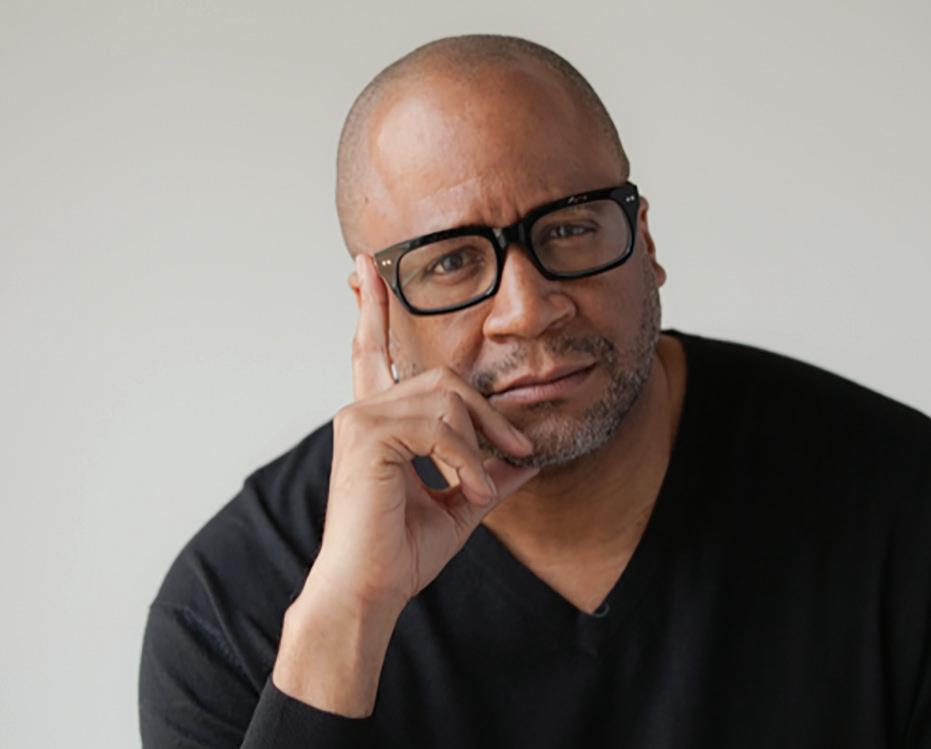
are on a mission to celebrate Black authors, both familiar and new, who are helping to tell a more complete cultural story ––from social justice and betterment to romance and sci-fi.”
#AmplifyBlackStories kicked off in February with Rolling Out’s Meet the Author series featuring renowned writer Kevin Powell talking about his long career telling Black stories, including his intriguing journey from reality show pioneer to a congressional candidate.
#AmplifyBlackStories will continue to pay homage to Black authors with a roster of virtual programming throughout the month, including:
- The Rolling Out Book Club (February selection is A Promised Land by President Barack Obama)
- The Children’s Club (Febru-
ary selection is I Am Every Good Thing by Derrick Barnes)
- The Sunday Read (authors read favorite excerpts and reveal stories of inspiration)
- Black Book Brunch (a virtual sip and dine while uplifting our favorite Black authors and their journeys)
- Modern Manual (relevant thought-leadership books, beginning with The Purpose of Power by Alicia Garza)
- Literally Speaking (smart and layered talks of Black literature and the writing process)
“Our partnership with Penguin Random House demonstrates the importance and impact of connecting culture and commerce,” said Steed.
“Giving content creators — our equity partners — opportunities to learn and grow with a Blackowned company produces real economic progress.”









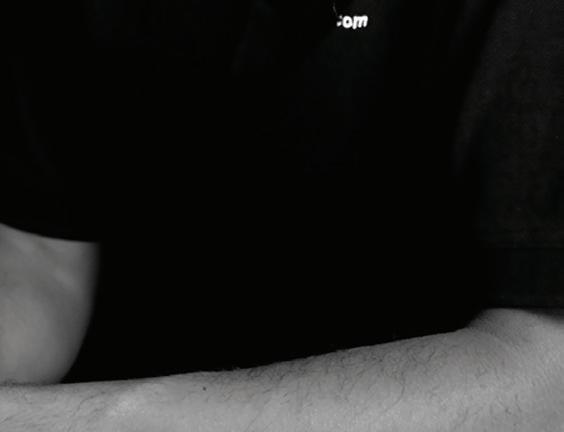


By Jamie Biesanz, Missouri Historical Society
The first African American military pilot, Eugene Bullard, never flew for the United States. Like many Americans, he joined World War I before his country did, fighting for France as part of the French Foreign Legion until he was wounded and pulled out of action. He was awarded the Croix de Guerre and the Médaille Militaire for his bravery, but he wasn’t done fighting. He joined the French Air Service and earned a reputation for flying with his mascot, Jimmy the rhesus monkey. He won two unconfirmed aerial victories against a Fokker Triplane and a Pfalz D.III. When the United States joined the war in 1917 he applied to join the US Air Service but was rejected because the US Army did not admit Black pilots. In fact, the US military tried to limit African Americans to non-combat roles, and the only Black divisions, the 92nd and 93rd, were placed under French command. By World War II, civil rights advocates had been fighting for more inclusive policies for decades, but military discrimination and segregation continued. In 1941 the US Army Air Corps began training the first Black cadets at the Tuskegee Institute in Alabama. At the time this was called the Tuskegee military experiment because many white leaders in the military didn’t believe Black service members would make good leaders or serve well in combat roles. They were wrong. A total of 355 graduates from the Tuskegee Institute joined the 332nd Fighter Group, which escorted Allied bombers in North Africa and Europe in Bell P-39 Airacobras, Republic P-47 Thunderbolts, and the P-51 Mustangs with which they are most associated. The 332nd painted the tails of their P-51 Mustangs
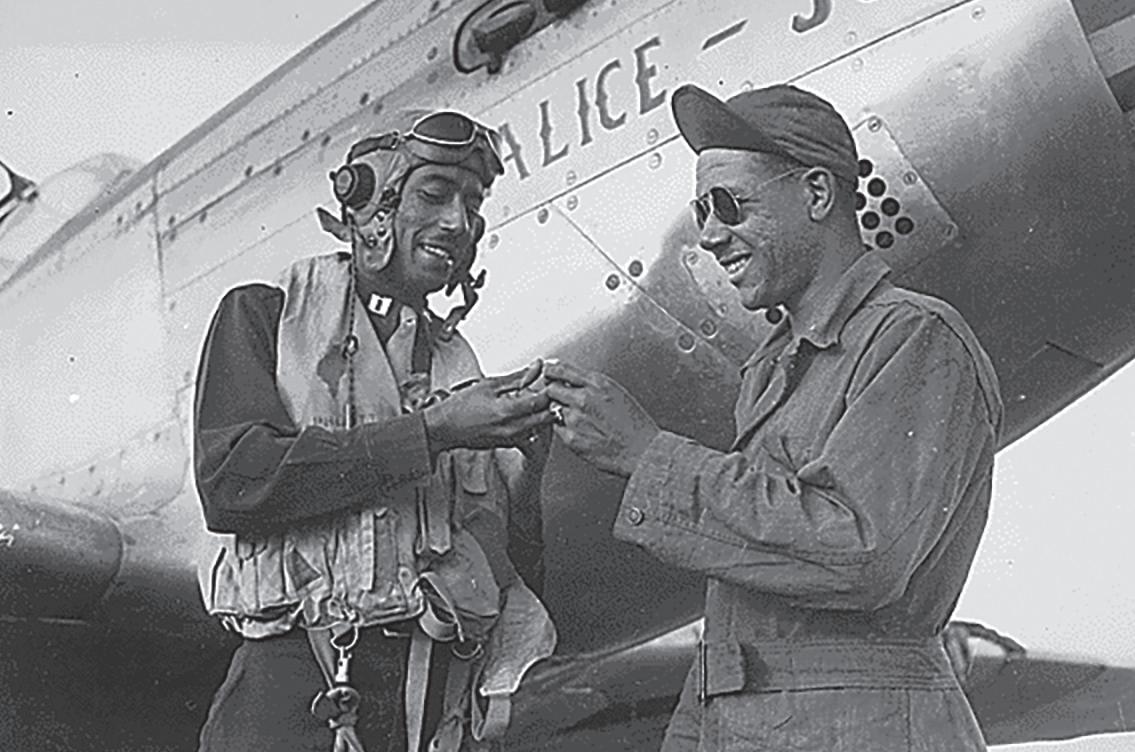
participate in the Civilian Pilot Training Program at Lincoln University after a brief time at Stowe Teachers College (now Harris-Stowe State University). He flew 70 combat missions during the war. In his most famous exploit, he participated in disabling the German destroyer TA-27 with 0.50-caliber rounds. The pilots’ fire hit the ship’s magazine, causing an explosion that made the crew think they were being bombed. Pruitt’s hometown recognized this action with Captain Wendell O. Pruitt Day on December 12, 1944. The occasion was marked with a parade and a ceremony in the city hall rotunda, where Pruitt received a watch from St. Louis American editor and publisher Nathaniel A. Sweets. Pruitt continued to serve by training new cadets. Tragically, he died along with a cadet in a training accident only months after he was honored by the city, on April 20, 1945. At the Soldiers Memorial Military Museum, his name is listed on the World War II memorial in the Court of Honor, and a reproduction of a poster commemorating Captain Wendell O. Pruitt Day is on display in the St. Louis in Service exhibit.
In 1972, Tuskegee Airmen, Inc. (TAI), was founded in order to preserve the legacy of the original Tuskegee Airmen. One of TAI’s biggest ongoing projects is the development of scholarships, especially for students of color in aviation and STEM fields.
red, earning them the nickname “Red Tails.” They performed so well that it was widely believed they hadn’t lost a single bomber. While that doesn’t appear to be true, their record was exceptional. They won 112 aerial victories, were awarded 96 Distinguished Flying Crosses in total, and earned three Distinguished Unit Citations. Tuskegee Airmen also formed the 477th Bom-
bardment Group, although the war ended before they were deployed.
White military leaders pointed to a 1925 Army report claiming African Americans were mentally inferior, weak in character, and incapable of taking initiative under pressure as a justification for segregation and discrimination. The Tuskegee Airmen made a major contribution to the

advancement of civil rights by demonstrating that claim to be unequivocally false. Their success contributed to the end of racial segregation in the military in 1948.
Several Tuskegee Airmen were from St. Louis. Perhaps the most famous is Wendell Pruitt, who grew up in the Ville neighborhood, graduated from Sumner High School, and went on to
On Tuesday, February 23, at 11am, local TAI chapter president Yolandea Wood will present a Zoom program on the legacy of the Tuskegee Airmen in partnership with Soldiers Memorial. The program will be recorded and posted to the Missouri Historical Society’s YouTube channel. Visit mohistory.org/events for the Zoom link and to learn about other Missouri Historical Society virtual events.
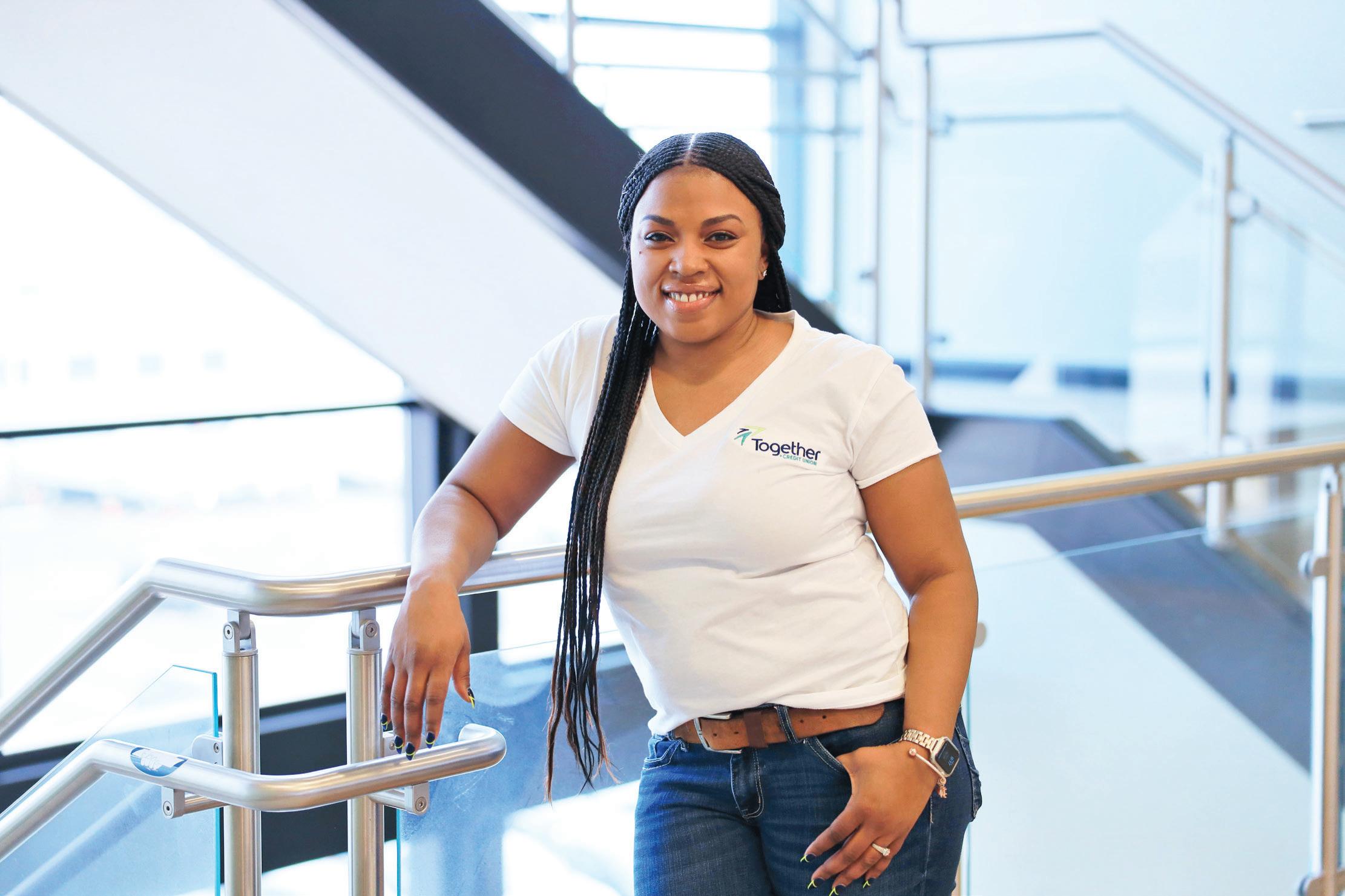


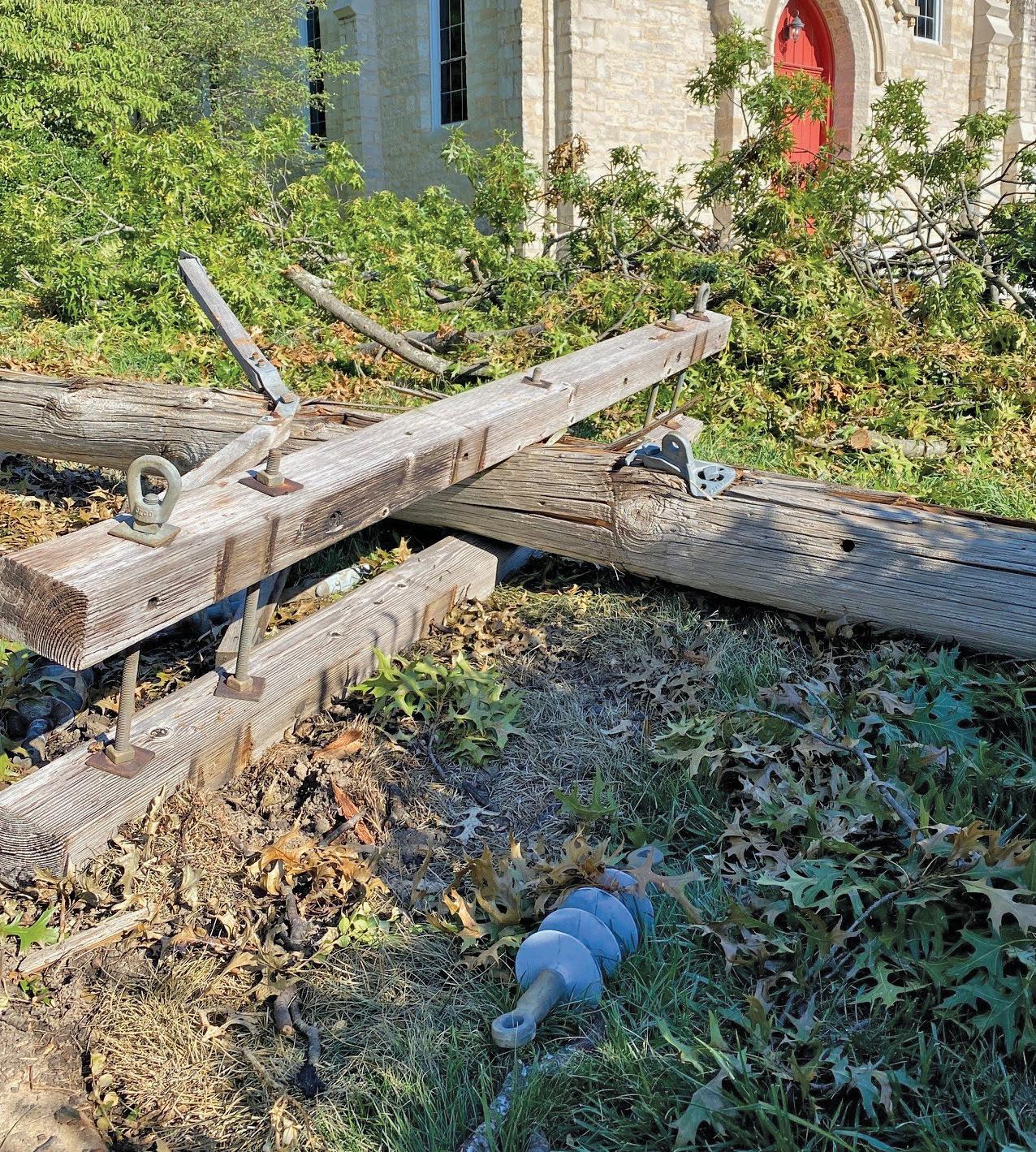

It takes courage to restore service to a community after a storm. It also takes courage to inclusively work across differences. At Ameren, courage is the foundation of diversity, equity and inclusion and in all the work we do.



By Chad Davis St. Louis Public Radio
Kenny DeShields thought he knew what love was when he married his wife, Christia, nearly a decade ago. At the time, he planned to release his debut album to celebrate his new life.
But DeShields said he needed to grow as a man before he could express himself.
In the past 10 years, DeShields focused on being a husband and father, a life that taught him about love. That prepared him to finish his album, “The Real Love Project,” the recording he had long yearned for, one that draws on difficult experiences and faith to express how everyone needs love.
“I think the biggest part of the process has been my maturity,” DeShields said. “I had to go through some hills and valleys and some really dark nights and some really amazing shining moments I think to be able to capture the different sides, the sides of what love is.” Now, DeShields is ready. After a string of singles and the release of the music video for his song, “How I Feel,” the gospel artist is showing the world how he’s changed. The video for the song features DeShields, his wife and his three children.
n “The Real Love Project” includes contributions from an ensemble of St. Louis musicians, among them, Theresa Payne, Russ Mohr, Anita Jackson and singer/songwriter Courtney Orlando, who helped produce the album.
“That love has inspired my love for my wife and for our kids, so in the video you see Christia there, the boys are in there,” DeShields said. “A couple months ago, I was just like, I don’t know if it’s the right time to release this, a lot of people have been going through a whole lot and Christia, she encouraged me, she was just like, ‘I think people are ready to smile and want to laugh and have fun again.’”
DeShields’ musical roots trace back to his childhood in the Mississippi Gulf Coast, where he was raised in a musical family and a missionary Baptist church. His mother taught him how to play piano, and his father’s collection of soul and R&B music led DeShields to want to explore all kinds of music and collaborate with artists from various backgrounds.
“The Real Love Project” includes contributions from an ensemble of St. Louis musicians, among them, Theresa Payne, Russ Mohr, Anita Jackson and singer/songwriter Courtney Orlando, who helped produce the album.
“Bringing Courtney Orlando as the producer has helped take this to a whole ‘nother level,” DeShields said. “He’s been able to bring that soulful side and then stretch me even vocally in terms of production quality, while still holding very true to the message.”
But it’s DeShields’ wife, author Christia, who serves as his true partner in music and in life.

Husband and wife Kenny and Christia DeShields
and record.
They co-wrote at least five of the album’s songs. During the coronavirus pandemic, they’ve used their time in isolation to write and record. Christia DeShields said many of the songs touch on their relationship and the troubles they see others going through.
“So many of our friends are struggling in their marriages,” Christia DeShields said. “This pandemic just like exposed anything that was going on, you know, you’re stuck in the house with
your spouse, and usually you’re probably not, you’re at work doing whatever, but it’s exposed a lot of cracks and relationships.” Songs like the yet-to-be-released “I Won’t Let You Be Lonely” and “Fight For Love” speak directly to those challenges, Christia DeShields said. The couple said they hope the songs pro-
10 years strong: Rapper proclaims 2021 to be his breakout year
Anthoney “A-Game”
Ellis’ took an unconventional road to success
By Danielle Brown Of The St. Louis American
An abrupt turn of events propelled 30-year-old Anthoney “A-Game” Ellis into the right place at the right time — and into the opportunity of a lifetime.
As if by providence, Takamatsu, then a stranger, offered him a ride. As it happened, she was looking for an emcee to join her brother’s band. Ellis fit the bill.
“At the time my brother was in a band and they were looking for an emcee, someone who had a strong lyrical presence,” Takamatsu said. “It clicked right away, and he was hungry. I hadn’t seen a drive like that in someone that young before.”
Family problems back home cut short Ellis’ time in the City of Angels. But once home, he tapped into the local music scene.
“When I went back to St. Louis, I took all of the things that I learned in LA and applied them,” Ellis said. “I didn’t come back to St. Louis with a defeated attitude.”
music.
“He’s always been great, he’s always been somebody that I was inspired by, and I wouldn’t be the person I am today without having him around,” Erby said.

By Danielle Brown Of The St. Louis American
Josiah Hickman, a 15-year-old sophomore at Lafayette High School in Wildwood and an aspiring aerospace engineer, recently received a Frontline Workers Scholarship, worth $400. Created by the University of Pittsburgh and Outlier.org, a company that offers for-credit university-level online courses for a fraction of the cost, the scholarship supports frontline workers during the coronavirus pandemic who have an interest in continuing their education.
Josiah stumbled on the scholarship, which also lets him earn college credit, while searching the internet for information about machine learning, the study of computer algorithms and control theory, a model of engineered processes and machines.
Once he found Outlier, he applied, with a view toward enrolling in a virtual calculus class that earned college credit and brought him a little step closer to his goal of getting a degree in aerospace engineering.
“The course was actually really fun,” Josiah said. “I’m the type of person who loves learning. “It was a great experience.”
Each recipient receives a free, for-credit online college course equivalent. The university will grant three transferable credits to students who successfully complete an Outlier course.
“We launched the scholarship program in partnership with the University of Pittsburgh to award 1,000 frontline workers with an Outlier course of their choice at no cost,” Kira Tangney, senior manager of business development at Outlier.
“This is the first, we hope, of many scholarships.”
n “He’s a great worker. He’s a very fast learner. He sticks out because he’s different from the rest around his age typically. He shows up and works hard.”
— Logan Martin, shift manager, Chick-fil-A
“We’ve been learning and growing with each other from the get-go and we’ve been sharing opportunities ever since.”
Ellis stayed in St. Louis from 2012 until 2018. When he decided to return to California, he was ready to test the waters of the bigger market.
A year after hitting LA, Ellis auditioned for the REVOLT Summit, AT&T’s “Be Heard” competition — a corporate sponsorship designed to inspire and empower the next generation of musicians. Ellis won the grand prize of $5,000. “That night we got to perform in front of everybody,” Ellis said.
Outlier defines frontline, or essential workers as those in the health care field, grocery workers, restaurant workers and a range of support staff positions. Each applicant must list an occupation, answer three multiple-choice questions, and make a 60-second video explaining why he or she deserves the scholarship. Despite Josiah’s age, Tangney felt it was imperative for him to have access to the scholarship, which will help prepare him for college.
“Part of our mission is to help students enter into the traditional educational system and hopefully take those prerequisite courses early on,” Tangney said. “So now, Josiah, when he enters college, can take higher level courses specific to his degree requirements.”
Enter Rapper Louis “MC Tres” Erby, whose friendship began a decade ago. Both shared a love of basketball and

“Andre Harrell; YBN Almighty Jay; Ray J, Sickamore; and Tuo Clark
After Too Fresh for Y’all entertainment company expressed interest in meeting him, he hopped a flight to Los Angeles. While there, he met Claire Takamatsu, CEO of 20FT Bear Studios. At age 20, he had been invited to perform at Dragonfly, a 21-and-up nightclub. As an underaged performer, he had to wait outside until his performance. Once on, however, he owned the stage, so much so he was invited to hang out backstage. When the kudos subsided, he found himself without a ride. See A-Game, C6
At the end of each school day, Josiah heads to work at the Ellisville Chick-fil-A, his first job. He decided to work there because he likes the food and customer service. So far, he’s proven to be a good fit.
“He’s a great worker,” Logan Martin, shift manager said. ”He’s a very fast learner. He sticks out because he’s different from the rest around his age typically. He shows up and works hard.” Josiah’s parents, Michelle Parker and Philip Hickman, are extremely proud of their son for his
By Nicole Franklin
For The St. Louis American
Dorothy Mae Hearon Elliott, the founding assistant director of the John B. Ervin Scholars Program at Washington University, died Sunday, Jan. 24, 2021. She was 84.
Known to be the nurturer of Wash U’s Black student body, alums recall a welcoming smile, lively conversation, and a generous hug whenever they dropped by for a visit with “Mrs. E.”
“She was everybody’s rock in college,” said Sacha Coupet, Loyola University Chicago Law professor and member of the first class of Ervin scholars.
“As undergraduates you’re out from under your parents’ wings, desperately wanting someone looking out for you.”
Wilmetta Toliver-Diallo, assistant dean in the College of Arts and Sciences Washington University and Ervin Scholars interim director, 2013-2014, recalls Elliott’s “godmother” quality as a unique asset for the principle goals she, the late Dean James McLeod and the late Dean Adrienne Glore set as program founders: fostering a strong commitment to leadership and excellence among scholars and providing them ongoing support.
“Mrs. E. could call up any alum who could tell current students the story of why the legacy of the program is so important,” Toliver-Diallo recalled.
When established in 1987, the Ervin Scholars Program was on a mission to dramatically increase African American applications and enrollment in an institution that in 1912 described itself as “exclusive-

graduate admissions counselor. Two years later, Elliott coordinated the Ervin Scholars Program and served as assistant director for more than 15 years.
Often at an Ervin Scholars retreat, students could witness Mrs. E. and Dean Glore break out a deck of cards for a mean game of bid whist.
“We were nurtured by three Black educators who all had roots in the South, and who had been educated by other Black people,” Michelle Purdy, associate professor of education in Arts and Sciences at Washington University, and the first known African American woman president of the university’s student body.
ly for white students,” even though it recorded Black student enrollment in the 1880s.
As historian Ralph Morrow noted, all undergraduate programs opened enrollment to Black students by fall 1952.
The Ervin Scholars Program was the namesake of renowned educator John B. Ervin, who taught Elliott as a student at Harris-Stowe Teachers College. Elliott, a Sumner High School graduate, was a member of Harris-Stowe’s first integrated class.
Ervin supervised Elliott’s practice teaching assignment in the St. Louis Public Schools. Elliott obtained a Master’s Degree from Webster University in 1973.
During a teaching career that spanned more than two decades and included Maplewood Richmond Heights Schools, Elliott was named one of the Outstanding Elementary Teachers of America in 1972. Her introduction to higher education in 1984 began as a Washington University under-
“The Ervin Program brought in the best and brightest and countered their [Washington University’s] ideas about Black students. I didn’t attend an HBCU, but Dean McLeod, Dean Glore, Mrs. E. and, later, Laura Stephenson created our home away from home.”
When it came to any grade discrepancies, problems in student clubs, residence halls or anywhere else, ToliverDiallo recalls the following instructions: “If students got into trouble, they were to tell Mrs. E. before anybody else. She’d say, ‘This is how we’re going to deal with this situation.’ Students were not to have someone outside tell her before they could tell her.”
Elliott retired in 2002, but maintained a presence on campus and in the lives of her alums by attending numerous weddings, family funerals and making celebratory calls with the arrival of newborns.
Coupet’s husband was the first Wash U student she met because it was Mrs. E. who sent him to the airport to pick her up.
“She was the last elder left of this trio from the program. We will miss her.”
“We’ll miss her touch of class,” Toliver-Diallo said.
“Mrs. E. would say ‘Always do your best. If your best falls short that’s not a problem. Not doing your best, that’s a problem.’”
Purdy credited Mrs. E.’s “institutional care” with being a Black woman of a certain generation who could easily connect with the parents. “It’s hard to measure the impact of somebody believing in you. The impact of a friendly face — a friendly Black face.”
Elliott’s survivors include by
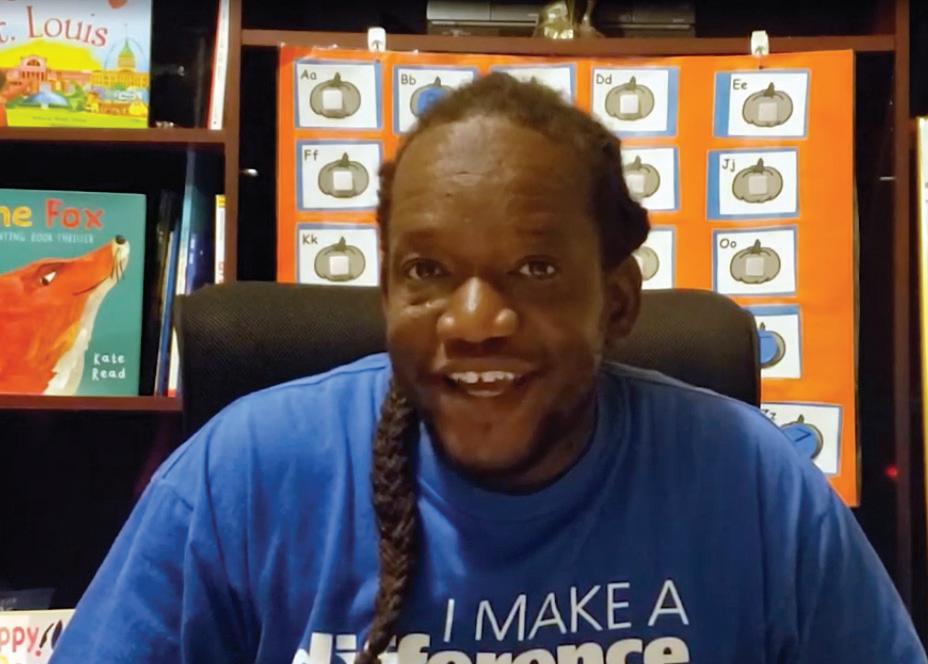
her daughter, Karla; grandson, Vernon Jr.; and siblings Marie Brown and Shedrick Hearon Jr. She was preceded in death by her husband, Jerry, and their son, Keith. A virtual service is scheduled for 4 p.m. Sunday, Feb. 21, at the Center for Spiritual Living.





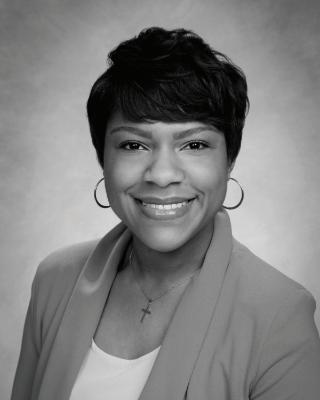


“Just running up and down the court a few times, it’s easier to get out of breath or tired a lot faster. I’ve noticed that since I’ve had COVID. It’s just something I’m working on.
- NBA star Jayson Tatum on dealing with the after effects of COVID-19
With Earl Austin Jr.

By Earl Austin Jr.
Of the St. Louis American
The Kirkwood High football program has tapped for Pioneers’ great Jeremy Maclin as its new head coach.
A 2006 graduate of Kirkwood, Maclin was one of the top wide receivers ever produced in the St. Louis metro area. He was an All-State and All-Metro performer on the football field as well as the starting point guard of Kirkwood’s basketball team that advanced to the Final Four of the Class 5 state tournament in 2006.
Maclin went on to enjoy a stellar collegiate career at the University of Missouri, where he earned All-American honors in 2007 and 2008. He played nine seasons in the National Football League with the Kansas City Chiefs, Baltimore Ravens and Philadelphia Eagles. He was selected to the Pro Bowl in 2014 while playing for the Eagles. For the past two seasons, Maclin has been on the Kirkwood High staff as an assistant coach. He becomes the second former St. Louis area prep star who played at Mizzou to be hired as a head coach at Kirkwood. The basketball program hired former Vashon High star Jimmy McKinney as its new head coach before the 2020-21 season.
RIP Leon Spinks
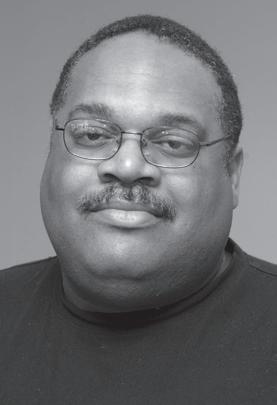
As we look back on the life and career of the late, great Leon Spinks, it was during this week in 1978 when the St. Louisan enjoyed the greatest triumph of his boxing career. On February 15, 1978, Spinks pulled off one of the biggest upsets in boxing history when he defeated Muhammad Ali to win the world heavyweight championship in Las Vegas. It was only Leon’s eighth professional fight of his career, thus making him the man who was the quickest to win the heavyweight title in his professional career. Leon Spinks was also the only man to dethrone Ali as the heavyweight champion. All of Ali’s other losses came when he was the challenger.
District Basketball Playoffs begin this weekend
The road to the state basketball tournament gets underway for small schools this weekend as the district playoffs get underway in Missouri for

sports eye
Cards’ ace Jack
The Chaminade Red Devils’ Tarris Reed Jr.(32) takes the jumper for 2 of his 23 points on the night over Hazelwood Central’s Tevin Gowins (0) and Trevin Williams (24) during game action Saturday Feb. 13, 2021. The
for Life, Festus St. Pius X and Carnahan. The semifinals will be held on Monday, February 22 with the championship game set for Wednesday, February 24. The host school is Bishop DuBourg. O’Fallon Christian received the No. 1 seed for the Class 3, District 5 tournament. The Eagles are looking for another long postseason run after advancing to the Class 5 state quarterfinals last season. They are followed in the seedings by Lutheran North, Duchesne and Brentwood. The first-round games will be held on Monday, February 22 with the semifinals to follow on Wednesday, February 24. The championship game is set for Friday, February 26 at 7 p.m. The host school is Trinity.
On the girls’ side, Lift for Life received the No. 1 seed for the Class 3, District 4 tournament. The Hawks are followed by Festus St. Pius X, Jefferson and Valley Park. The first round games will be held on Saturday at noon with the semifinals set for Monday at 7 p.m. The championship game will be held on Wednesday at 4 p.m. The host school is Bishop DuBourg. STEAM Academy received the No. 1 seed for the Class 3, District 5 tournament. They are followed by Duchesne, Brentwood, Trinity and O’Fallon-Christian. The first-round action will be held on Monday, February 22 with the semifinals set for Wednesday, February 24. The championship game will be held on Friday, February 26 at 5 p.m. The host school is Trinity.
TJ Crockett is a star at Lindenwood
Former University City basketball standout T.J. Crockett is having a stellar senior season at Lindenwood University in St. Charles. The 6’1” Crockett is averaging 26 points a game, which is among the leading scorers in the NCAA Division II ranks. He has also been named the Great Lakes Valley Conference Player of the Week on three different occasions. Crockett recently surpassed the 1,000-point mark in his career as well.
scores a big win before season gets under way
The St. Louis Cardinals had not lost a contract arbitration case in decades. Then came Jack Flaherty.
The team’s 25-year-old ace sought $3.9 million for a one-year deal and the Cardinals offered $3 million. Why the Cardinals could not comply with Flaherty’s request is beyond me. I think it shows some disrespect. So does Flaherty.
A three-member panel awarded the $3.9 million to Flaherty. He immediately let Cardinal Nation know his feelings after the triumph.
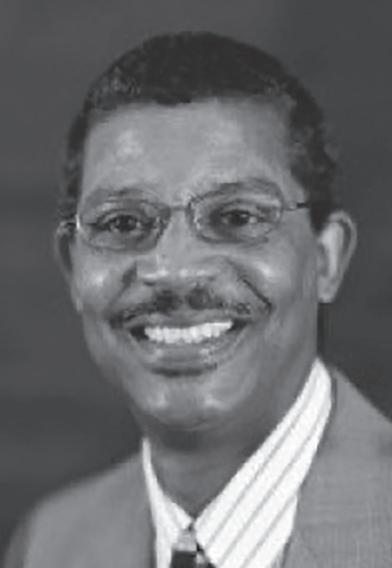
He posted a meme of Michael Jordan speaking in the mini-series “The Last Dance” with the words “and I took that personally.” Flaherty, who is at the top of any list of top, young Major League pitchers, was forced to quibble over $900,000. He did not appreciate it, that is for sure. He finished fourth in Cy Young voting after the 2019 season and recorded historic statistics. During the COVID-shortened season of 2020, Flaherty was 4-3 with a 4.91 ERA in nine starts. He recorded 49 strikeouts while walking just 16 batters 40 1/3 innings. His team certainly threw this in his face during the arbitration hearing. Flaherty’s arbitration win will only fuel the haters that blame his support of Black Lives Matter and social justice reform for very hit, walk and home run surrenders.
As written here before, Flaherty should be praised and not scorned. Too many Cardinals fans see it differently. I am sure he takes that personally. And it could lead to him taking himself elsewhere in free agency after the 2022 season. Urban blight Where was Jacksonville Jaguars owner Shahid Khan when first-year head coach Urban Meyer hired disgraced former Iowa strength coach Chris Doyle for a similar position with Khan’s Jaguars?
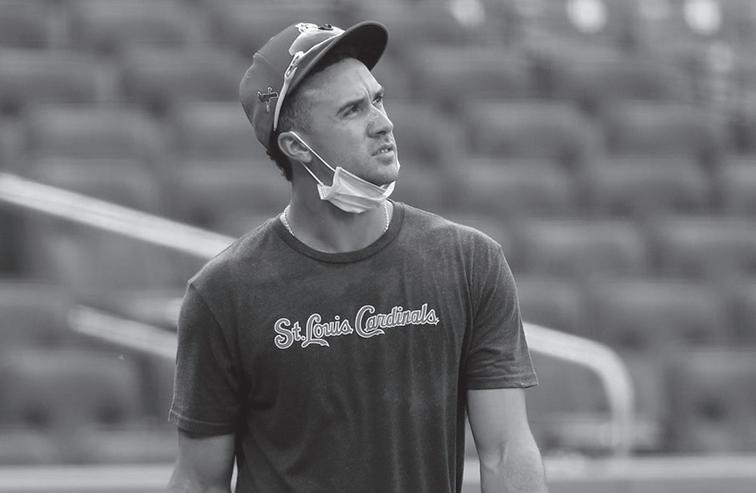
“At a time when the NFL has failed to solve its problem with racial hiring practices, it is simply unacceptable to welcome Chris Doyle into the ranks of NFL coaches,” Graves said in a statement. “Doyle’s departure from the University of Iowa reflected a tenure riddled with poor judgment and mistreatment of Black players.”
After a day passed, Doyle resigned.
Upon the hiring, Meyer deflected criticism saying he “vetted” Doyle thoroughly and, “I’ve known Chris for close to 20 years.” Graves said that statement, “reflects the good ol’ boy network that is precisely the reason there is such a disparity in employment opportunities for Black coaches.” Meyer stated originally that Khan and GM Trent Baalke had approved of Doyle’s hiring. The first press release announcing that Doyle had resigned because “he did not want to be a distraction,” carried only Meyer’s name. Hours later, Baalke’s name was added. Khan’s name was not mentioned.
The Reid Roundup
Doyle and the Hawkeyes reached a $1.1 million settlement after allegations that he racially insulted Black players with tidbits including “I’m going to send you back to the ghetto,” and racial taunts.
Thirteen Black former Iowa football players are jointly suing Iowa, alleging they suffered racial discrimination under coach Kirk Ferentz. Doyle is one of several defendants.
Rod Graves, executive director of the Fritz Pollard Association, a watchdog organization that monitors Black coaching hires, said Doyle’s conduct “should be as disqualifying for the NFL as it was for University of Iowa.”
Attorneys for the St. Louis plaintiffs in a lawsuit against the NFL are seeking “billions” of dollars in the case. The trial is slated to begin in the fall – and I still think it will never reach a courtroom…After reaching No. 10 in the nation, Missouri got clobbered on the road at Mississippi and dropped an overtime game at home to Arkansas. The Tigers fell to No. 20…East St. Louis native Jeremiah Tilmon, who is having a breakout season with Cuonzo Martin’s Tigers, missed the Arkansas game and was on indefinite bereavement leave following a death in his family. Mizzou has released no further details.
Alvin A. Reid was honored as the 2017 “Best Sports Columnist – Weeklies” in the Missouri Press Association’s Better Newspaper Contest and is a New York Times contributor. He is a panelist on the Nine Network program, Donnybrook, a weekly contributor to “The Charlie Tuna Show” on KFNS and appears monthly on “The Dave Glover Show” on 97.1 Talk.”


Full-Time Accounting Assistant
Proficient in Accounts Payable & Excel Spreadsheets. Working knowledge of Accounts Receivable. Understands General Ledger and Financial Reports. Professional phone etiquette & customer service skills.
Email resume with qualifications and work experience to: rbritt@stlamerican.com
Subject: Accounting Assistant Or you may mail to: St Louis American Newspaper
Attn: Accounting Assistant
2315 Pine Street, St Louis, MO 63103 NO PHONE CALLS PLEASE
The St. Louis County Department of Transportation is requesting the services of a highly-qualified consulting engineering firm to perform professional engineering services for the North Hanley Road (F) Resurfacing, I-70 to Natural Bridge Road project (St. Louis County Project No. AR-1821)
Full details for this project, including submittal requirements and deadline, will be available on February 15, 2021 from the St. Louis County Web Site (https://stlouiscountymo.gov/)
NOTICE TO
The St. Louis County Department of Transportation is requesting the services of a highly-qualified consulting engineering firm to perform professional engineering services for the West Florissant Avenue (A) Resurfacing, Solway Avenue to Lucas-Hunt Road project (St. Louis County Project No. AR-1827)
Full details for this project, including submittal requirements and deadline, will be available on February 15, 2021 from the St. Louis County Web Site (https://stlouiscountymo.gov/)
Interpreter Services for the Deaf
The City of St. Louis Department of Human Services, Office on the Disabled, is seeking proposals from qualified Sign Language Interpreting Service providers to provide Interpreters for the Deaf and Hard of Hearing individuals using City services and City employees.
The deadline for submitting a proposal is March 10, 2021 by 5:00 p.m. Copies of the Request for Proposal can be obtained via mail, email or pick up by request to the Office on the Disabled at City Hall, 1200 Market St. Room 30, ph# 314-622-3686 or by download from the City of St. Louis website at: https://www.stlouis-mo.gov/ government/procurement.cfm
CLEAN-TECH COMPANY IS INTERVIEWING FOR VARIOUS LOCATIONS!
Interviews on the spot! Every Tuesday 11AM – 2 PM and Every Thursday from 1PM-4PM! 211 South Jefferson Avenue, St. Louis, MO JOBS AVAILABLE! WE ARE HIRING! Apply online www.cleantechcompany.com/ careers
The City of Clayton is hiring for a full-time Principal Planner. Apply by 3/12/21: https://claytonmo.applicantpro. com/jobs/ EOE
PJ Hoerr, Inc. Is Soliciting Bids MBE/WBE/DBE/ Veteran/SDVE for the following; University of Missouri, Columbia University RR Shipping & Receiving Building Addition Bid Date: 2/23/21 @ 1:30pm
Contact: Gabe Rodriguez, gabe@pjhoerr.com Phone: 309-688-9567
Great Rivers Greenway is seeking a Greenway Operations Supervisor. Go to www.greatriversgreenway.org/ jobs-bids/ and submit.
Sealed bids for the 2020 CRS Pavement Rehabilitation, Area D project, St. Louis County Project No. CR-1815, will be received electronically thru the County’s Vendor Self Service portal at https://stlouisco. munisselfservice.com/Vendors/ default.aspx, until 11:00 a.m. on March 17, 2021. Plans and specifications will be available on February 15, 2021 from the St. Louis County Web Site (www.stlouiscountymo. gov) or by contacting Cross Rhodes Print & Technologies, 2731 South Jefferson Avenue, St. Louis, Missouri 63118 (314) 678-0087.
Curtiss-Manes-Schulte, Inc. is soliciting bids from MBE/WBE/ SDVE/DBE subcontractors and suppliers for work on the South Farm-Swine Research Facility, University of Missouri, Columbia, MO. Bids are due Thursday, March 4th, 2021 by 1:00 pm and can be faxed to (573) 392-4527 or emailed to shawn@cms-gc.com For more information, call Shawn @ (573) 392-6553. Curtiss-Manes-Schulte, Inc. is an Equal Opportunity Employer.
B
Improvements, Environmental Control Center, P r o j e c t N o . O2114-01, will be received by FMDC, State of MO, UNTIL 1:30 PM, 3/25/2021 via MissouriBUYS. Bidders must be registered to bid.For specific project information and ordering plans, go to: http://oa.mo. gov/facilities
B i d s f o r Masa Breach R e c a l m a t i o n Project, Barton County, Liberal, MO, Project No. Y2102-01 will be received by FMDC, State of MO, UNTIL 1:30 PM, March 11, 2021 For specific project information and ordering plans, go to: http:// oa.mo.gov/ facilities
The City of Creve Coeur is accepting applications for the position of Police Officer. Starting salary is $59,688 w/ excellent benefit package. Applicants must be 21 years of age and POST certified at the time of appointment, have a valid driver’s license, and Associate’s Degree or a minimum of 64 hours of college. Duties include, but are not limited to Community Policing, Patrol, Traffic Enforcement, Enforcement of State and local laws. Application information is available at www.crevecoeurmo.gov. For additional information contact Hiring and Recruiting at 314-274-2106. THE CITY OF CREVE COEUR IS AN EQUAL OPPORTUNITY EMPLOYER
SAFE CONNECTIONS IS HIRING FOR THE FOLLOWING POSITIONS:
• Full-Time Adult Therapist LPC/LCSW
• Clinical Manager – Support Services LCSW/LPC
• Clinical Manager -Adult Therapy -LPC/LCSW
Full Description and Apply at safeconnections.org
The Mission of Safe Connections is to reduce the impact and incidence of relationship violence and sexual assault through education, crisis intervention, counseling and support services.



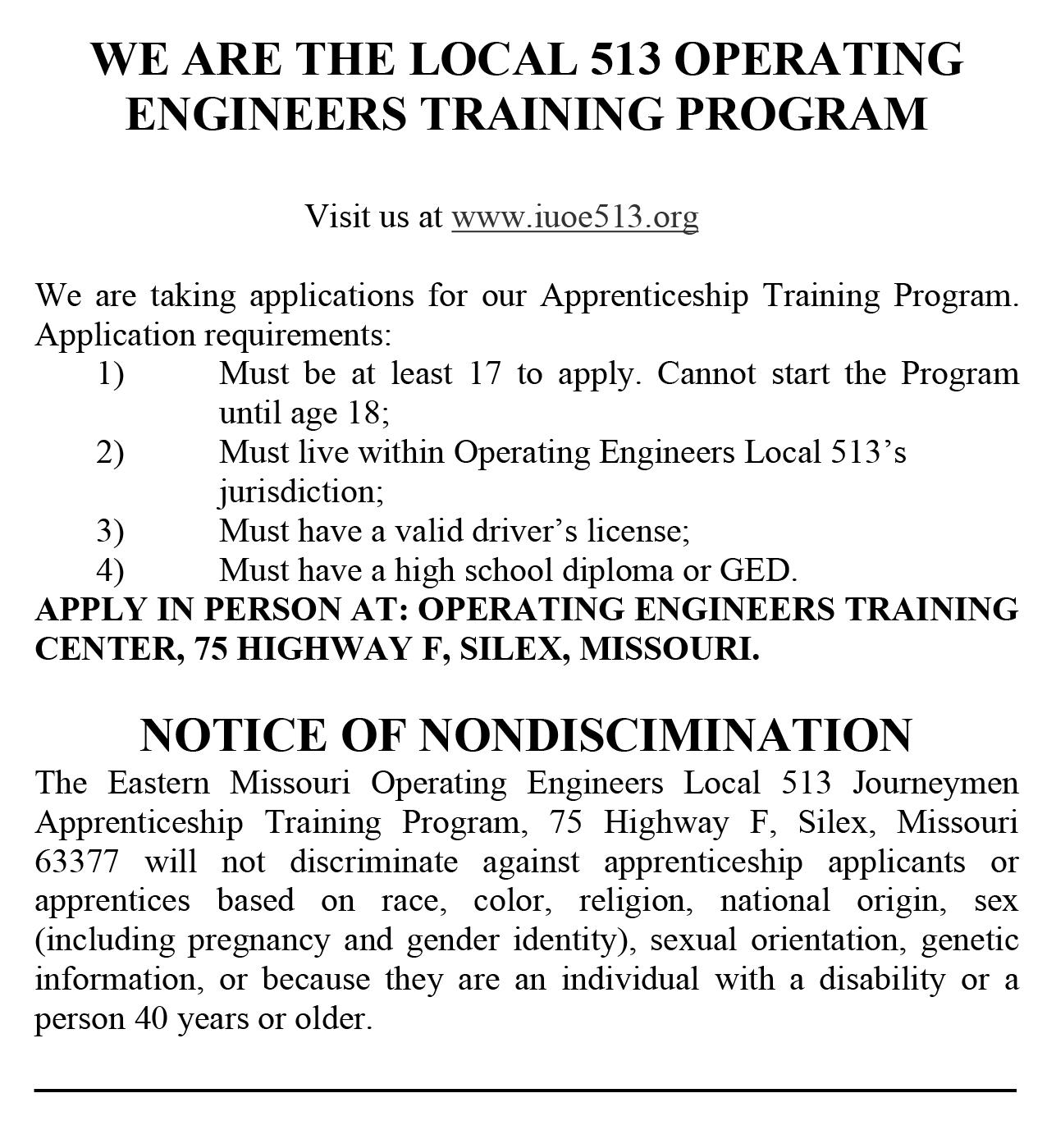
Francis Park Stream Improvements
Sealed proposals will be received by the Board of Public Service in Room 208 City Hall, 1200 Market Street, St. Louis, Mo. Until 1:45 PM, CT, on March 9th, 2021 , then publicly opened and read. Plans and Specifications may be examined on the Board of Public Service website http://www.stl-bps.org/planroom.aspx (BPS On Line Plan Room) and may be purchased directly through the BPS website from INDOX Services at cost plus shipping. No refunds will be made.
A pre-bid conference for all contractors bidding on this project will be held on February 11th, 2021 at 10:00 A.M. in onsite.
Bidders shall comply with all applicable City, State and Federal laws (including MBE/WBE policies).
All bidders must regard Federal Executive Order 11246, “Notice of Requirement for Affirmative Action to Ensure Equal Employment Opportunity”, the “Equal Opportunity Clause” and the “Standard Federal Equal Employment Specifications” set forth within and referenced at www.stl-bps.org (Announcements).
PARIC/Barton Malow A Joint Venture is seeking proposals for Bid Package 1 for the following project: University of Missouri Women’s and Children’s Hospital Facility.
This is the construction of a 7 story plus basement and mechanical penthouse building addition to the neighboring existing patient tower.
Bid Package 1: Early Site Utility Package scope of work includes but is not limited to Site Utilities and Associated Earthwork, Site Electrical, Site Mechanical and Site Pavements.
This project has a diversity participation goal of 10% MBE and 10% combined WBE, DBE, Veteran Owned Business and 3% SDVE.
Bids for Bid Package 1 are due on February 24th at 1:30 p.m. For any questions or would like to find out more detailed information on this opportunity, please contact Paul Moffat at 615-519-6522 or Paul.Moffat@bartonmalow.com
All bids should be delivered to PARIC/Barton Malow via the University of Missouri at the below address, no e-mail and/or fax bids will be accepted.
General Services Building, Front Desk University of Missouri Columbia, MO 65211
PARIC/BARTON MALOW A JOINT VENTURE IS AN EQUAL OPPORTUNITY EMPLOYER
Paric Corporation is seeking proposals for the following project: University of Missouri Teaching Hospital 6th Floor Pediatrics Renovation.
This project includes approximately 17,200 sf of renovation work on the 6th floor of the Teaching Hospital.
Scope of work includes but is not limited to asbestosmabatement, selective demolition, carpentry, casework, firestopping, doors, drywall, acoustical ceilings, flooring,painting, specialties, fire sprinklers, plumbing, HVAC and electrical work.
The owner has supplier diversity participation goals of 10% MBE, 10% combined WBE, DBE and Veteran Owned and 3% SDVE.
Bids for this project are due on February 25, 2021, at 10:00 p.m. For any questions or would like to find out more detailed information on this opportunity, please contact Evan Chiles at 816-878-6003 or emchiles@paric.com
All bids should be delivered to Paric via e-mail (bids@paric.com) or fax (816-878-6249).
PARIC CORPORATION IS AN EQUAL OPPORTUNITY EMPLOYER

McCarthy Building Companies, Inc. requests bids from qualified and certified MBE and WBE subcontractors and suppliers for the following project:
Washington University School of Medicine 4370 Duncan - Research Building and Garage Bid Package 9
For the following scopes of work: Interior Fit Out Site Work Roofing
Bids Due March 11, 2021 by 2:00 PM CST
Contact: Michael Bax at mbax@mccarthy.com or 314-919-2215
Prequalification is required and can also be accessed through the McCarthy website above.
McCarthy Building Companies, Inc. is proud to be an equal opportunity and affirmative action employer.
Aging Ahead invites proposals and bids for: transportation services, frozen meal home delivery, evidence-based programming, and primary vendor within counties of St. Louis, St. Charles, Jefferson and Franklin.
Awards to be made are governed by Titles III of OAA regulations and specifications of the US Dept. of HHS, Missouri Div. of Senior and Disability Services and Aging Ahead
The contract period will be July 1, 2021 to June 30, 2022. Contracts may be extended up to three fiscal years. Specifications and proposal packets may be obtained at Aging Ahead office beginning noon, February 22, 2021, 14535 Manchester Road, Manchester, Missouri, 63011, 636-207-0847 or online at https://www.agingahead.org/who-we-are/ financials/. Closing date for receipt of proposals is March 26, 2021 at 4:00pm. Agency reserves right to accept or reject any or all proposals.
ST. LOUIS COUNTY, MISSOURI
NOTICE TO BIDDERS
Sealed proposals marked “Gym
Floor Abatement” will be received at the Crestwood Community Center for the Crestwood Parks and Recreation Department. 9245 Whitecliff Park Lane, 63126, until 3 pm on Friday, February 24, 2021. A mandatory pre-bid meeting will take place at 3:00 pm, February 18, 2021 at the Community Center. Bidding documents and specifications may be obtained at the City of Crestwood website: www.cityofcrestwood.org. All bidders must register with Laura Ingold at lingold@cityofcrestwood. org. Failure to register may result in failure to receive addendums, etc.
City of Crestwood, 1 Detjen Drive, Crestwood, MO 63126 is seeking bids for The Historic Thomas Sappington House gutter and downspout project. Bids due 2/25/2021 by 3:30 p.m. by email to jgillam@cityofcrestwood.org
An optional pre-bid site meeting will be held on 2/22/21 by appointment at 1015 South Sappington Road, Crestwood, Missouri, 63126. Complete sets of procurement document may be obtained from Cross Rhodes Print & Technology, 2731 S. Jefferson Ave., St. Louis, MO 63118. For project questions and on-site appointment, contact Juliana Schafer at jschafer@bondarchitectsinc.com
K&S Associates, Inc. is soliciting MBE/WBE/SDVE/DBE/VBE for the following project for Feb-Mar, Greensfelder Recreation Complex Renovation & South Farm-Swine Research Facility University of Columbia, Plans and Specs can be viewed at www.ksgcstl.com-submit bids to estimating@ksgcstl.com or Fax 314-647-5302
The St. Louis Center for International Relations d/b/a World Trade Center-St. Louis (“WTC”) invites qualified individuals and firms to assist the WTC to provide general-export counseling services to businesses in a virtual format. The requested services shall be for a six-month period with the option for the WTC to renew for an additional six months. A five percent bid preference may be available to certified MBE firms. Bids will be opened and read aloud as identified in the Invitation for Bids. A copy of the complete Invitation for Bids is available at https://stlpartnership.com/ rfp-rfq/. To be considered, proposals must be received no later than 12 PM CST on Friday, March 12, 2021 St. Louis Economic Development Partnership Equal Opportunity Employer
The St. Louis County Department of Transportation is requesting the services of a highly-qualified consulting engineering firm to perform professional engineering services for the Sulphur Spring Road Resurfacing, Manchester to Big Bend Road project (St. Louis County Project No. AR-1826)
Full details for this project, including submittal requirements and deadline, will be available on February 15, 2021 from the St. Louis County Web Site (https://stlouiscountymo.gov/)
3 / MBE /WBE Encouraged 32 Units Multi Family –Potosi, MO For Bid Information: 636-931-4244 or zventura@vendev.cc Double
BID NOTICE
PJ Hoerr, Inc. Is Soliciting Bids MBE/WBE/DBE/ Veteran/SDVE for the following; University of Missouri, Columbia University South Farm Swine Research Facility Bid Date: 3/4/21 @ 1:30pm Contact: Gabe Rodriguez, gabe@pjhoerr.com Phone: 309-688-9567
PJ Hoerr, Inc. Is Soliciting Bids MBE/WBE/DBE/ Veteran/SDVE for the following; University of Missouri, Columbia University 6th Floor Pediatrics Renovation Bid Date: 2/25/21 @ 1:30pm Contact: Mike Murray, mikem@pjhoerr.com Phone: 573-999-1329
The St. Louis County Department of Transportation is requesting the services of a single, highlyqualified consulting engineering firm to perform professional engineering services for the design of the following three (3) projects: Lackland Road Resurfacing, Craig Road to East of Concourse Drive (AR-1565) Woodson Road Resurfacing, Brown Road to Kempland Place (AR-1828) Olive Boulevard Resurfacing, Ferguson Avenue to Skinker Boulevard (AR-1822) Full details for these projects, including submittal requirements and deadline, will be available on February 15, 2021 from the St. Louis County Web Site (https://stlouiscountymo.gov/)
strong work ethic and passion for the STEM curriculum.
“We’re proud of Josiah and know he’s gonna take over the world some day,” Hickman said. After high school graduation, Josiah would like to enter the aerospace programs at the University of Illinois, the University of Michigan or the Massachusetts Institute of Technology.
from C1
were on stage watching us perform,” Ellis said.
“It was epic, and the energy was amazing!”
While at the Summit, he met Grammy Award-winning singer-songwriter Guordan Banks, with whom he later forged a friendship that yielded a distribution partnership with indie company, AWAL.
“When I met him at the REVOLT concert, he was up against hundreds of artists and ended up winning the grand prize. You gotta come prepared to do something like that,” Banks said.
Continued from C1 DeShields
Continued from C1
vide solace to listeners who are going through rough times over the past year.
“We’ve known of like three suicides of friends during this time, and so ‘I Won’t Let You Be Lonely,’ those songs, I feel like they speak across cultural lines, they speak across religious lines and all of those things,” Christia DeShields said.
The song, “Imagine,” written
“I think it would be great to work with people who are like-minded, that have a gen-
“I’m all about grassroots, independence, bootstrapping, just making it happen. The distribution was an organic thing.” Months later after the Summit, the coronavirus hit the artists community hard. Nevertheless, Ellis was able to continue recording, experimenting with his sound, became a successful day trader and produced his own line of merchandise.
“I want people to understand I’m a dual-threat,” Ellis said. “I’m a jack of all trades. I feel like 2021 has the potential to be my breakout year.” Takamatsu agreed. “I feel he’s on the brink of explosion,” she said. “You can’t work that hard and nothing comes from it. It’s been really cool to see his perseverance. He just doesn’t
with singer Russ Mohr, decries the continuing wave of violence against Black people. Kenny DeShields said they want to urge religious leaders to talk openly about race.
“How does the church help speak into these things, like how do we help process this together?” DeShields asked.
“It’s either the church, in many ways, is either super silent on it or kind of just saying whatever comes to mind, sometimes it’s not necessarily always the right thing.”
But more than anything, the DeShieldses want the music to let people know that love can
uine love for aerospace and have been building things their whole life.” Josiah said. Applicants are eligible to apply for the scholarship until November 2022. More informagtion about Outlier and the Frontline Workers Scholarship, is available at: https://www.outlier.org/pages/frontline-workers-scholarship.
stop, and I’m not surprised.”
Last month, Ellis released the video for his single “Belize,” off his highly-anticipated album “Global Warming,” projected due to drop next month.
Ellis, a 2008 graduate of Hazelwood West High School, won the 2012, Slum Fest Award as part of the Freshman Class. In 2016, he won the Best Hip-Hop Mixtape for the Slum Awards.
He is well on his way to becoming a household name in hip-hop. He has since opened for J. Cole, Ella Mai, Jhene Aiko, and Ty Dolla $ign *cq*. A-Game’s music can be found on all streaming platforms under AGAMESTL. More about A-Game is available here: https://www. agamestl.com/.
overcome hurt feelings. It’s what he sings about on “That’s When You Love,” a song Kenny wrote several years ago.
“That song basically, I think, summarizes what the whole Real Love Project is about,” Kenny DeShields said. “When life is tough, when it’s unfair, when you have been the one that has been wronged, that is when you love.”
Chad Davis is a reporter for St. Lous Public Radio, a media partner of The St. Louis American and is reprinted with permission from https://news. stlpublicradio.org/

Through transformative moments in its
Organized chronologically, Storm of Progress explores key events and ideas through the lens of our exceptional collection, highlighting German art from Romanticism


strong work ethic and passion for the STEM curriculum.
“We’re proud of Josiah and know he’s gonna take over the world some day,” Hickman said. After high school graduation, Josiah would like to enter the aerospace programs at the University of Illinois, the University of Michigan or the Massachusetts Institute of Technology.
from C1
were on stage watching us perform,” Ellis said.
“It was epic, and the energy was amazing!”
While at the Summit, he met Grammy Award-winning singer-songwriter Guordan Banks, with whom he later forged a friendship that yielded a distribution partnership with indie company, AWAL.
“When I met him at the REVOLT concert, he was up against hundreds of artists and ended up winning the grand prize. You gotta come prepared to do something like that,” Banks said.
Continued from C1 DeShields
Continued from C1
vide solace to listeners who are going through rough times over the past year.
“We’ve known of like three suicides of friends during this time, and so ‘I Won’t Let You Be Lonely,’ those songs, I feel like they speak across cultural lines, they speak across religious lines and all of those things,” Christia DeShields said.
The song, “Imagine,” written
“I think it would be great to work with people who are like-minded, that have a gen-
“I’m all about grassroots, independence, bootstrapping, just making it happen. The distribution was an organic thing.” Months later after the Summit, the coronavirus hit the artists community hard. Nevertheless, Ellis was able to continue recording, experimenting with his sound, became a successful day trader and produced his own line of merchandise.
“I want people to understand I’m a dual-threat,” Ellis said. “I’m a jack of all trades. I feel like 2021 has the potential to be my breakout year.” Takamatsu agreed. “I feel he’s on the brink of explosion,” she said. “You can’t work that hard and nothing comes from it. It’s been really cool to see his perseverance. He just doesn’t
with singer Russ Mohr, decries the continuing wave of violence against Black people. Kenny DeShields said they want to urge religious leaders to talk openly about race.
“How does the church help speak into these things, like how do we help process this together?” DeShields asked.
“It’s either the church, in many ways, is either super silent on it or kind of just saying whatever comes to mind, sometimes it’s not necessarily always the right thing.”
But more than anything, the DeShieldses want the music to let people know that love can
uine love for aerospace and have been building things their whole life.” Josiah said. Applicants are eligible to apply for the scholarship until November 2022. More informagtion about Outlier and the Frontline Workers Scholarship, is available at: https://www.outlier.org/pages/frontline-workers-scholarship.
stop, and I’m not surprised.”
Last month, Ellis released the video for his single “Belize,” off his highly-anticipated album “Global Warming,” projected due to drop next month.
Ellis, a 2008 graduate of Hazelwood West High School, won the 2012, Slum Fest Award as part of the Freshman Class. In 2016, he won the Best Hip-Hop Mixtape for the Slum Awards.
He is well on his way to becoming a household name in hip-hop. He has since opened for J. Cole, Ella Mai, Jhene Aiko, and Ty Dolla $ign *cq*. A-Game’s music can be found on all streaming platforms under AGAMESTL. More about A-Game is available here: https://www. agamestl.com/.
overcome hurt feelings. It’s what he sings about on “That’s When You Love,” a song Kenny wrote several years ago.
“That song basically, I think, summarizes what the whole Real Love Project is about,” Kenny DeShields said. “When life is tough, when it’s unfair, when you have been the one that has been wronged, that is when you love.”
Chad Davis is a reporter for St. Lous Public Radio, a media partner of The St. Louis American and is reprinted with permission from https://news. stlpublicradio.org/

Through transformative moments in its
Organized chronologically, Storm of Progress explores key events and ideas through the lens of our exceptional collection, highlighting German art from Romanticism

